#Spiritual but not Religious b/c the only way to be spiritual is to be christian lite & if you're Genuinely even christian lite then you
Explore tagged Tumblr posts
Text
already thinking "and by 'religious' really i mean 'christian'" re: how the term "religion" is not really useful when it's largely like, from a christian perspective, what is considered "equivalent" of christianity, see: perhaps a "rival"/obstacle to some person or group being considered christian....and even if not thinking about converting anyone, resulting in some at best misinterpretation / misrepresentation based on framing it through/as [element of christianity] and limiting of any more accurate language
like how tumblr recommends me a post about someone thinking about "religion" in general and concluding that it's Weird and perhaps Wrong for anyone who is a "true believer" in their religion(tm) to Not be proselytizing / trying to Convert everyone. like yeah why isn't everyone being an evangelical christian, they ought to be, benevolently informing all those around them that they're going to hell, otherwise. don't see any problem with this conclusion, or that someone's getting antisemitic in the notes already in agreement, or that That's Not How This Works and you don't just know how All "Religion" works based on considering it to be an alternate version of christianity (which in itself doesn't All work like that either)
#and even when it comes to having a Critical View of any belief system / way of living / spirituality it's like...people are on that already#without having to see it from a christian perspective or understand the only possible framework for it as [critiques of christianity]....#a dogmatic approach / doctrine of Salvation....not how it all works out there re: ways anyone can be anything besides christian#So Bizarre why everybody's not all trying to ''convert'' everyone else in the world....is it.#what; like; ''you'd think everyone would be launching an inquisition'' like would you.#even if you know fuckall abt non christian beliefs / perspectives / traditions/practices / identities / ways of life etc....#we could maybe go ahead and question this conclusion. or perhaps go ''but also i know fuckall about all that so why am i theorizing'' like.#and again there are non ''western'' christian traditions....and of course individuals and philosophies within christianity who would also#not think you can only Truly be christian by going ''and i'd better be trying to convert everyone. or i'm being a jerk'' too#not actually the case that everyone thinks everyone else who doesn't share some ''religious'' factor is Damned To Hell or an equivalent....#anyways telling tumblr actually this particular post? isn't for me. and i don't thank you#another tiresome factor of [mass at the benedictine monastery] like the homilies/sermons were especially exhausting#they always were but like ''what are you even talking about'' as one priest goes on about how it's silly for people to say they're#Spiritual but not Religious b/c the only way to be spiritual is to be christian lite & if you're Genuinely even christian lite then you#ought to realize you should go full throttle christian. like a) No b) why are we preaching to the choir here. we're all at Sunday Mass???#not like any sermons ever feel that thoughtful when like too much analysis is like uh oh? a bit heretical are we??? which is not universal.#gee thanks for this [are we just supposed to all sit here feeling validated in our superiority; or...?] experience#wisdom you couldn't totally get from someone going on some self-assured monologue abt heathens these days over dinner or sm shit#really makes you think. and then someone will be really thinking & going ''shouldn't everyone w/a Religion be an Evangelist'' hmm: No.#and they aren't ''wrong'' about their own beliefs approaches perspectives identities traditions etc for it either. Done#anyways changed ''religious parent'' to ''christian parent'' for its own enhanced accuracy & precision alike....
2 notes
·
View notes
Note
buddy look, i dont know how to tell this to you but the fact that you are centering your christian religion (talking abt jesus) in relation to a war in which both participants are part of religions who are oppressed by christians is oppression. buddy, jesus has nothing to do with this, youre Personal spirtiual beliefs are not relevant. literally saying this would all be solved if we listened to jesus is literally a) islamophobic and antisemitic b) demeaning (i know the right way and these poor people are wrong) c) just blantantanly fucking callous, like imagine centering your religious beliefs when people are literally dying. jesus fucking christ.
Hi there. So for context, you're responding to my post about Anakin and radical forgiveness.
Why would I talk about Jesus, and forgiveness when there's a war on? Because He loves all those people in that war, and they need His forgiveness for themselves and each other. I'm pretty sure everyone talks about their 'religious beliefs' when people are dying.
Personal spiritual beliefs have everything to do with it—the attacks by the Hamas were driven by personal spiritual beliefs, and the retaliation is driven by personal spiritual beliefs. Everything you do comes out of your worldview, and that grows out of your personal spiritual beliefs. No matter what those are, whether you believe in an afterlife or not, whether you believe God is real or not, whether you belive in absolute truth or not, whether you believe there is right and wrong or not. Those are personal spiritual beliefs, and they will influence whatever you do.
Jesus is the Greek transliteration of His name, which spread the widest among the western gentiles thanks to the Roman Empire, but His name is originally Yehoshua, usually shortened to Yeshua. Hebrew, means 'the LORD is salvation'. Jesus, Yeshua, was a Jew, born in Bethlehem, grew up in Nazareth, preached around much of Judea (present-day Isreal and Palastine). Jesus was the fulfillment of thousands of years of prophecies given to and for the Jewish people first, and then the rest of the world. He was fully God, and fully man. He lived, died, and came back to life all on Israeli and Palestinian soil. He was a real person, and I encourage you to look into that, overhaul the evidence for yourself.
Yes, many people have done awful things to Jews in the name of Jesus, but those things didn't line up with what He instructed His followers to do. The first Christians were Jewish, and Jewish people continue to find hope in Jesus today.
Believing that Islam is a false and empty religion, does not mean I am afraid of muslims. I care deeply about them, that's why I am willing to disagree with them. It's like a person standing in the middle of a street licking an ice cream cone, and they say, "Hey, I'm fine, you can't tell me to move," when there's a dump truck about to run them over. Believing the wrong thing is dangerous. That's why asking questions and digging into the background and basis of your beliefs is so important. And many many Muslims have come to believe in Yeshua and everything he said.
I dunno, is it demeaning to tell people they need help, and I know someone who can help them, because He helped me? He saved me from despair and darkness and bitterness, and He forgave me of all the wrong things I've done, so I can forgive others with joy. That kind of saving, that kind of life is available to anyone. From murderers, to little kids, to doctors, to exhausted parents. Palestinian, Israeli, Canadian, American, whoever YOU are, my friend, wherever you are, you need saving. Jesus, Yeshua came for you too.
For this is how God loved the world: He gave his one and only Son, so that everyone who believes in him will not perish but have eternal life. God sent his Son into the world not to judge the world, but to save the world through him. (John 3:16-17NLT)
How is it callous to talk about the source of hope in hopeless times? I'm praying for peace, and I'm praying that peace will come through something so much more powerful than a bullet or a bomb. I'm praying that peace will come through forgiveness and the power of God, of Yeshua who came for Israel and the whole world.
All the links are to YouTube videos, some of them are longer, but I hope you'll watch/listen to some of them, and do some digging of your own.
#sending this out with prayer#not the kind of response i expected from a post about anakin skywalker and radical forgiveness but here we are#christianity#israel hamas war
6 notes
·
View notes
Text
2nd post for the morning. It was just going to be a deconstructing post, but I went off on a health tangent.
I have multiple journaling locations. I have one where I try to collect everything, but it's getting ... octopus. It's in OneNote, and I have multiple tabs and subpages for different topics: my kids coming out, my husband coming out, my religion shattering, a letter for my Mom about it that I've been procrastinating finishing for over a year -- it's so close--, my own thoughts and feelings about 'all the things.' Due to life's business and my previously mentioned (the other post from this morning) low energy and mental function, I haven't been able to give my religious/spiritual aspect enough attention, and lately I've been feeling the need to do that. The last few days I've been wanting to start rereading Untamed by Glennon Doyle. I think I'm ready to move into the next phase, ?, whatever that is. I feel stalled right now.
I had been working my way through Falling Upward by Richard Rohr. That was also supposed to be part of my Sunday morning time. Now I'm not sure how applicable it will be given my Christian deconversion. I guess I should look and see. I am capable of recognizing metaphor and framing separately from my experience and so still be able to take the lessons. ... ... haha, just had to bring my brain back from another tangent related to framing/context. OK. back to the topic at hand. See, I didn't leave Mormonism only to remain a Christian; my deconstruction of God precludes that. My understanding of God was the first thing that shattered. So, while I often appreciate others' deconstruction experiences, I'm still looking for more non-Christian deconstructing community. Jesus as radical historical figure, fine, but no more Jesus as Savior, no more Heavenly Father (or Mother) -- I feel like they're less parental and more transcended siblings. I want to find my own divinity, not the "seeds of Divinity" as spoken of by Mormon leaders but the stardust inside.
Since at least November, my husband has been in the early goo phase of metamorphosis or the early germination phase of a seed: breaking apart, melting, he's beyond the point of no return from what he used to be. But in his case it's kind of weird b/c what he used to be was constantly masking, constantly trying to be what everyone else thought he should be, so he's trying to be himself, to go back to the beginning, but I just realized that even that being is socially defined, I think, by the imprinting he got as a child. But there's also a lot of trauma there. Anyway, I feel like I'm finally ready to explore nonmonogamy but now he's in a very personally, mentally, and emotionally delicate stage. He's worried that I'll find someone "better" or replace him. (Actually one of the 1st fears listed on a remodeledlove post in IG.) He also expresses interest in swinging, but I can't see myself doing that, at least partly b/c I've never had sex with anyone else. So sometimes, he's like, hurry up and have sex w/someone else, so that we can move on to threesomes and swapping and swinging. But I can't have sex with a stranger; I wouldn't mind having a FWB relationship but I at least need the friend part. I'm on an app, but I'm afraid to 'like' anybody. I've only liked 2 people but have not had any conversations with them. I'm not "talking to" anyone. I just fantasize, lol. And he's not ready for any new relationships, friend or otherwise, right now. So...where does that leave me? Where am I, and where do I go from here?
#deconversion#deconstruction#deconstructing christianity#2nd half of life#polyamory#nonmonogamy#fear#adrift#stuck#divinity
0 notes
Text
yippee, im so excited i was tagged! here are my answers!
How long have you been practicing?
it all started around when i was 12-13 and got super into astrology and tarot and it has only grown from there. its been a solid 6-7 years now!
How would you describe your practice?
my practice is a folk practice built upon my religious (jewish), regional (american/appalachian/midwestern) and ethnic/heritage (irish, ashkenazi-jewish). i am a bit of a jack-of-all-trades in exploring and practicing witchy topics but thats just b/c of my immense love of learning!
What tools do you use in your practice?
a solid variety of tools! incense, candles, bottles, bowls, cards, pendulum, crystals, jewellery, the list goes on!
What kind of divination is your go to?
tarot! i feel the most comfortable with it compared to other form of divination
Where do you think your practice falls on the low energy to high energy scale?
it honestly varies day to day i feel. sometimes it’s simply just saying a blessing or some other mundane things, while other times its much more involved with spellwork and research and activities.
What are your favorite resource(s) in witchcraft? (books, youtube, podcast, etc.)
for jewitchery…
@/jewitches, @/devotaj_arts, @/sheydgarden, anything by jill hammer, “the encyclopedia of jewish magic myth and mystycism” by geoffery w dennis, “jewish magic and superstition” by joshua trauchenberg
for general/other folk witchery…
@/annekekathrina, @/chaoticwitchaunt, @/ellaharrison, anything by bree nicgarren, anything by jake richards, the firefox series, so many more im forgetting rn
How cycle oriented in your practice?
very cycle oriented! i follow the astrological movements, the seasons, and both the jewish and gregorian calendar and its movements.
How does nature play a role in your practice if at all?
it is a fundamental part of my practice as it is what connects me to the world around me and the spiritual within it. every single animal and plant and phenomena of nature is holy in its own way and carries its own magic.
What is your witchcraft hot take?
some of yall are NOT ready to hear this but most witchcraft spaces are dominated by wiccan, new age and culturally christian beliefs/ideas and it is truly a plague on the larger witchcraft community. that might need to be an entirely separate post just to get through all my problems here lol
What is the weirdest thing to happen to you via your practice?
perhaps just the amount of eerie “coincidences” i run into that at times. that might not necessarily be related to my practice, but who knows?
What is the best thing to happen to you via your practice?
making friends with fellow folk witches and finding community! it isn’t perfect ofc, but im so happy to have it!
i tag @endorsprophecy @toothandsugar or honestly anyone else who wants to do this!
I was trying to find something like this to just look at and see the responses, and I couldn't find any, so I decided to create one.
Witchcraft Ask Tag
How long have you been practicing?
I have been practicing for about 6-7 years now, kind of off an on as my adhd takes me from one place to the next.
How would you describe your practice?
Its a mix of kitchen witchcraft, green witchcraft, and my jewish religious practice and culture all together. I have also called it hearth craft to a couple friends since my practice is based in my household and home, ie what can I do to improve the quality of the lives within my home.
What tools do you use in your practice?
I have a mortar and pestle, thats sooo necessary imo. And all my kitchen utensils as well. I just have a lot of bits and bobs that are used.
What kind of divination is your go to?
Bone throwing! though I have recently tried crystal throwing and that is pretty cool too.
Where do you think your practice falls on the low energy to high energy scale?
I would say medium, and at times high.
What are your favorite resource(s) in witchcraft? (books, youtube, podcast, etc.)
I am gonna say Jewitches in my favorite resource for all my jewitchery needs.
For general witchcraft HearthWitch & ChaoticWitchAunt on youtube have to be my favs.
How cycle oriented in your practice?
Very! Thats because Judasim is a very cycle oriented religion due to the calendar being sol-lunar, and every week I renew things once more on shabbat.
How does nature play a role in your practice if at all?
A lot! being out in nature is very important to me, and my plants are a reflection of mine and my households health.
What is your witchcraft hot take?
Stop calling non-jewish holidays sabbats! You are appropriating if you do.
(link to a nice tumblr post that describes my feelings on this a lot better than I can)
What is the weirdest thing to happen to you via your practice?
I had a prophetic dream that predicted the end of one of my long term friendships.
What is the best thing to happen to you via your practice?
Making new friends and joining a community of like minded people. I am so happy to have met the people I have!
~.~.~.~.~.~.~.~.~.~.~.~.~.~.~.~.~.~.~.~.~.~.~.~.~.~.~.~.~.~.~.~.~.~.~.~.~.~.~.~.~.~
I am going to @bubblefemmejewitchery, @zevthejewitch, @salixsociety, @shtetlshabbos, @will-o-the-witch, @hiddenhearthwitch, @magickkate, @broomsick, and anyone else who wants to do it! Feel free to share as much or as little as you would like, and don't forget to pass it on!
15 notes
·
View notes
Text
shoutout to Gladiator (2000) for having one of the only cinematic scenes i know of that portrays ancient pagan spirituality as a genuinely personal and emotional part of the main character’s life that brings them peace while adding something good to their journey, rather than (A) as a flashy but ultimately meaningless event intended purely for public spectacle, like the equivalent of a modern float parade, (B) as simply fake or irrelevant as a religious tradition, or worst of all, (C) as a strange / evil practice that will be “corrected” by christianity later on. instead it looks like it was actually taken seriously, mirroring the way you’d see a prayer depicted in a contemporary christian movie. it’s a short and simple scene but i find myself thinking about it a lot because it’s such a heartfelt good-faith depiction of pagan practice, not to mention visually appealing, and that’s not something you see often.
#roman paganism#roman polytheism#ancient rome#gladiator#gladiator movie#hellenism#hellenic polythiest#hellenic pagan#roman pagan#hellenic polytheism#pagan#paganism#polytheist#polytheism#religion#gods#op
33 notes
·
View notes
Note
How would you interpret an "atheist" Lestat's spiritual vacation witnessing "God-Satan affair in hell" but a persistent "catholic" Louis only seeing "Void" after death? As a Hindu, I have no idea about atheist or ex-catholic people's notion of the afterlife. But can we see this as Louis's victory over any sort of man-made religion to witness the "nothing"/ "dark matter" (🤯) "beginning of the universe" (☠️)?
Okay, I apologize if this isn't the answer you were looking for, but I hope it at least provides some insight on my thoughts about the topic of religion in VC as a whole.
Again, I feel obligated to start this answer by reiterating that I tend to avoid even taking anything post-trilogy into account in my consideration of a lot of my analysis of canon. So much of it is wildly inconsistent and contradictory to the point where is makes reasonable analysis impossible. All the crazy religious things that happen in VC read to me like AR externally processing her relationship to Catholicism, and if you track her public statements on her faith and match them up to VC, you can pretty much see that the characters are her avatars for exploring whatever she's feeling at that particular moment.
When she wrote IWTV, she was struggling with God and faith in the same way and for the same reasons Louis was. When she wrote TVL, she'd left the church. When she wrote Memnoch, she was in the processing of returning. She even leaves again later and comes back to Christianity but not to Catholicism. All of that is paralleled explicitly in her work and I don't think it has anything to do with the actual plot or characters requiring it.
In short, I don't think that discrepancy actually means anything for canon, I think AR's personal views of religion simply changed between Memnoch and Merrick. Alternatively, the fact that Louis was reanimated by blood suggests to me that he was never really dead, just close to it. That would make his experience closer to a coma than to death which could explain why he didn't experience what Lestat did.
That said, if we take Louis' experience out of context, I could see a reading where that empty "void" is quite triumphant. He spends all of IWTV terrified of damnation and tortured by the thought that he might be forsaken by God or a minion of the Devil. For him to "die" and find, if not paradise, the peace of nothingness is significant. It's clearly upsetting to him, but in time I think it could become a comfort.
As far as Memnoch and the things Lestat sees, I really resent everything about it for so many of its implications. If what Lestat saw was real, and even though AR half-recants it later, it seems like it was at the time, that means that a) Louis' religious trauma was justified and he is a minion of evil/the Devil, b) Armand's cult was right about vampires and his recovery/deprogramming was for moot, and c) Lestat's journey find find his own happiness/goodness/meaning has been pointless because there actually is a divine figure to control him and tell him what to do. I hate that so much for all of them. It absolutely annihilates so much character development.
So that's my abbreviated Memnoch rant as a bonus.
I'm sorry I can't answer your question any better, but I truly think that AR is just projecting and being weird here.
15 notes
·
View notes
Text
A guide to 13 Jewish holidays / Jewish Writing Advice
Depending on how you want to count, there are theoretically 47 Jewish holidays, assuming you count all minor, major, and modern celebrations, both minor and major fasts, special shabbats, and each Rosh Chodesh (new month) individually. Since that post would be A) neverending, B) probably not useful in its entirety here, and C) really not applicable to most Jews you meet or write, I’m going to tell you about 13 celebrations (12 holidays plus the category of Rosh Chodesh and the category of special Shabbats), which will be plenty long enough. Maybe I’ll write a super-niche passionate post about the minor fasts or modern holidays later, but today is not that day.
Usual disclaimers: I’m one me. The Jewish community is 14 million and super diverse. These are broad strokes and local tradition may vary. I operate from an American context and communal gathering/food sharing practices come from the Before Times (in some cases, the long before now times).
I’m going to go in the order of the Jewish calendar, instead of likelihood of celebration, and note the most popular ones as I go. Three general notes as well: I will be using the most common transliteration/translation of the Hebrew names, Jewish holidays (and days in general) start at sunset and operate on a separate calendar that fluctuates relative to the secular Gregorian calendar. The Hebrew dates are listed with the months they generally fall in on the Gregorian calendar. Holidays marked with an * will likely merit their own list at some point.
Additionally, how long many holidays last also varies depending on location. For some holidays (NOT fasts), diaspora (outside Israel) Jews celebrate an extra day for Jewish-diaspora-is-complicated-story-for-another-time reasons. I will note these holidays.
*Rosh HaShanah (Tishrei 1, September-October): Jewish new year (well, one of four, but for the purposes of our discussion today, the Jewish new year). 1a. Typically celebrated by synagogue attendance, consumption of foods that are sweet and/or round (or have heads, like fish heads). Longer services than normal Saturday morning services but not by much, even when combined with regular Shabbat services. Big time to gather with families for a large meal. 1b. Lots of blowing of shofars at specific times, shofars, which are cleaned and sometimes painted ceremonial ram’s horns (we’re operating on 1200 B.C.E. tech here). Some of us are very good at blowing the shofar. Some of us are assuredly not. 1c. One of the most common holidays to celebrate, part of the “High Holidays.” If your character is remotely observant or has a very Jewish family, they celebrate this holiday. 1d. One day in Israel, two in the diaspora.
Yom Kippur (Tishrei 10, September-October): The second holiday in the “High Holidays.” Yom Kippur is ten days after Rosh HaShanah, known as the “Days of Awe” (or the “Days of Repentance”). The Days of Awe, outside of orthodoxy and people who do prayers every day, aren’t really celebrated outside of asking people for forgiveness and tashlich (throwing away sins by yeeting small pieces of bread or other small foodstuffs into a pond). 2a. Yom Kippur is a 25 hour fast. Fasting on Yom Kippur means the following: No food. No water. Medication is typically okay (and most denominations are 100% okay with food/water necessary to accompany medication). No sex. This is usually extended to no sexual contact in general. No wearing of leather. You’ll see a lot of sneakers on Yom Kippur. No perfumes or lotions. Bathing/washing. This one is the one most people ditch. 2b. Jewish “adults” who are not health-impaired are expected to fast. Pregnant women, sick people, and the elderly explicitly get a choice and most of the former two do not fast. Lots of old folks do and have very strong opinions about it (I fast, but have gotten second-hand awkward watching a healthy 23-year-old explain why they aren’t doing so to an 89 year old survivor who is). There are young/healthy/not pregnant people who choose not to fast, but this is generally frowned upon. 2c. One day holiday regardless of location. Starts at beginning of sunset one day and ends at complete darkness (ideally with three stars in the sky) the next. Fasts are typically broken as a group over a large meal. 2d. It’s very likely that your Jewish character “celebrates” Yom Kippur and whether they fast or not is likely a point of contention with their family. 2e. There are a bunch of different services and they are usually heinously long. 2f. Shofars are also super important here. 2g. Wearing white is traditional in many communities. 2h. Napping is a popular way to pass the time, especially among less traditionally observant Jews.
*Sukkot (Tishrei 15-22, September-October): The Festival of Booths, basically the Jewish Harvest Festival. 3a. Fairly common to celebrate but not as much as the High Holidays, Passover, or Hannukah. 3b. Celebrated by building a Sukkah, which is an at-least-three-sided TEMPORARY structure with a natural roof (corn, leaves, bamboo) that you can see the stars through. People will eat and sleep in the Sukkah, and go “Sukkah hopping” to visit other families’ Sukkahs. 3c. In addition to regular guests, there is kabbalah and traditional mysticism that the a different guest from Jewish history will join you in the Sukkah each night, known as the Ushpizin. The Ushpizin Abraham, Isaac, Jacob, Moses, Aaron, Joseph and David) are all male, and in the 20th century some Jews began the custom of honoring Ushpizot (female guests as well, adding Sarah, Miriam, Deborah, Hannah, Abigail, Hulda, and Esther (although some obscure lists of Ushpizot date back to the 15th century). 3d. Your Jewish character may not have a Sukkah. Their temple will have a communal one. 3e. It is customary to shake a lulav and etrog, also known as the four species. Three leaves and a citrus from specific plants are held together and shook in all six directions after the recitation of a prayer. I like to call this shake-the-plant, but it actually has a ton of different spiritual meanings traditionally ascribed to it. There is also a processional in synagogue with the lulav and etrog.
Shmeni Atzeret (Tishrei 22, September-October): In Israel, the one day after Sukkot and in the diaspora the last day of Sukkot and the day after. There are some extra prayers and it marks a seasonal shift in prayers pertaining to rain. Unless your character is particularly religious/observant, they aren’t going to do anything extra. This holiday’s functions were mostly relevant during the Temple Periods in ancient Israel.
*Simchat Torah (Tishrei 23, September-October): Simchat Torah celebrates the restarting of the Torah-reading cycle and overlaps with the second day of Shmeni Atzeret where there is a second day. Unlike in some other faiths where the congregation or leader generally chooses the text of the day, Jewish congregations are bound by the Parsha (portion) of the week for formal services/readings (as opposed to other forms of study). The 54 parshas are read over the course of the Jewish year, and the resetting of that cycle is Simchat Torah. In synagogues during services readings from from Torahs, which are large, heavy, physical scrolls. This is relevant during Simchat Torah particularly. 5a. Two days in the diaspora, one day in Israel. Intermediate level popularity. 5b. Seven hakafot (professionals) are performed by dancing around the synagogue while members alternate carrying the Torah. This is considered an honor. Simchat Torah is usually the only day all the Torahs are brought out (or at least the ones that are in good enough shape to be carried). Dancing is mixed outside of orthodoxy and separated within orthodoxy. Only Jewish adults are permitted to carry the Torah. Outside of orthodoxy this includes both men and women. Within some orthodox congregations, women-only circles will also include Torahs in their dancing. 5c. There are also smaller not-Torah-but-still-Holy scrolls and Torah-shaped-stuffies that children will sometimes carry and dance with. 5d. After the dancing, the final parsha is read aloud. This is the only time we read Torah at night (from the physical object Torah - we read books of the Torah in other forms at any hour). The scroll is then rolled back all the way to the first reading. Reading the first or last reading is a great honor.
*Hanukkah (Kislev 25 - Tevet 2, November-December): Hannukah celebrates the victory of the Maccabees over the political and cultural oppression of the ancient Greeks in the 160s B.C.E. After the victory of the priestly-class-turned-warrior-bros over their oppressors, the Maccabees found the Temple seriously wrecked, both on a physical and spiritual level. They wanted to rededicate the temple, but only found one itty-bitty little jar of oil for the Menorah (seven-branched candelabra in the Temple), enough for one day. They figured it was better than nothing, and immediately sent out for more oil, which took eight days. That was the miracle of the lights, and where the Hanukiyah (eight-branched variant of the Menorah) comes from since the oil for one day lasted eight. 6a. Hanukkah is an immensely popular eight day festival. 6b. Religiously, Hanukkah actually isn’t super important. Religiously-significant practices for the holiday are lighting a Hannukiyah, telling the story of Hanukkah, and eating greasy foods. 6c. There are approximately a shabillion ways to spell Hanukkah, it’s not just you. There are actually only two acceptable (really only one 100%) Hebrew spellings but transliteration is a bitch sometimes. 6d. Although not “Jewish Christmas” gifts on Hanukkah are a thing because of the proximity to Christmas. Hanukkah gifts as they now are are really a 1950s-forward thing because Jewish kids were starting to have Christian friends en-masse who were getting Christmas gifts at the same time a lot of the U.S. was experiencing an economic boom. Purim is actually the traditional gifting holiday. 6e. Related: Hanukkah parties are very popular, but much more cultural than religious. 6f. Dreidels have a weird AF history and their dubious origins (and half-dozen possible theories) truly merit their own post. In the U.S. they are played with chocolate coins or other not-money, elsewhere children frequently use their local equivalent of pennies instead.
Tu Bishvat (Shevat 15, February-March): The Jewish new year/birthday of the trees. Functions like a Jewish Earth day - planting trees is popular. Fresh fruits are consumed in celebration of what trees give us. Some more religious families also do a ceremonial meal, a Tu Bishvat seder, but most Jews don’t.
*Purim (Adar 14, February-March): Purim, an immensely popular holiday celebrates the survival of the Jews during the first exile period in the ancient kingdom of Persia. The text celebrates the strength of our community and the chutzpah of a Jewish woman, and is usually celebrated in practice like Jewish Halloween. 8a. The story really merits its own post, but the short of it is because shenanigans, antisemites, and booze-hound kings a Jewish lady named Hadassah became queen (hiding her Jewish identity and taking the Esther to do so), the king’s head advisor Haman wanted to kill-the-Jews-tm, Esther was able to prevent it by convincing the king that the Jews should be able to fight back, the Jews did so and won, Haman was executed, and Esther’s cousin/bestie Mordechai became the new advisor. [really, the full story is Hollywood-level drama, another post to come.] 8b. Communities gather together to do communal readings of the book of Esther (in Hebrew or the lingua franca), it’s only about 10 chapters and takes an hour or two. The megillah is read once in the night and once in the day. Technically there are several megillahs for different books/holidays, but Jews are usually referring to Megalilat Esther (the book of Esther) when they say the megillah, definitely so on Purim. 8c. Costumes are donned by adults and children alike, both inspired by the story and otherwise. This is in honor of the hiddenness in the story (with both Esther and some other stuff we don’t have time for today). Synagogues often hold costume contests as a small break between chapters. 8d. Readings get ROWDY. It’s customary to boo and make noise using little noisemakers when Haman’s name is said aloud, as with the names of his also Jew-hating sons (which are traditionally said in one breath). There are also certain lines of the megillah read out loud together. 8e. It is a mizvah to give gifts (typically of food) to friends as well as to charity on Purim (two separate mitzvahs). 8f. It’s also a mitzvah to have a big special meal. 8g. It’s a common misconception that it’s a mitzvah to get so lit on Purim you can’t tell the difference between Haman the wicked and Mordechai the blessed. It’s not a Mitzvah, but there is some commentary in the Talmud saying that, so while not a commandment, “get lit to honor the party king goy who vouched for us and also because Jewish history requires drinking sometimes” is a historically-rooted take. Consequently, it’s very popular to drink a lot on Purim. 8h. Purim is, for all of the above, immensely popular with both children and adults despite being dark AF. 8i. Purim is the last holiday in the Torah itself (Hannukah is after). 8j. Purim is a one-day holiday unless you’re in a walled city (long story).
*Passover (Nissan 15-22, March-April): Arguably the most important holiday, theologically. Passover celebrates the Exodus from Egypt. 9a. Families gather for Seders on the first night (Israel) and second night (Diaspora). The holiday is 7/8 days long and one of the most common to celebrate. In normal years it’s common for families to travel to have large gatherings together. 9b. In addition to regular kosher laws, “chametz” (basically leavened bread and bread-like things and most foods that bring joy). There are five grains that can make chametz, wheat, rye, barley, oats, and spelt. Some communities historically forbade other foods that could be mistaken for chametz, like the Ashkenazi forbiddance of kitanyot (legumes, rice, corn, certain seeds), although that was revoked/voted on to be not an official custom by nonorthodox denominations in the late 20th and early 21st centuries. 9c. Seders are ceremonial meals with 15 steps, including the actual meal itself. The quickest Seders run maybe an hour plus the meal. The longest can run upwards of 6-8, depending on the denomination, family, and customs. It almost goes without saying that there’s a lot of food and wine involved. 9d. In addition to be prohibited for consumption, Chametz cannot be possessed or consumed on Passover, so Jews clean out their houses of Chametz, and temporarily sell it to a gentile friend or family member for the duration of the holiday. 9e. Passover-specific hanger is very real, especially after the post-Seder food-coma wears off. Especially if you already have dietary restrictions and can’t just do a meat-fast. 9f. During the Seder, the story of Passover is gradually told from Moses to the plagues to the Exodus itself. It is a fairly interactive telling/ceremony and the specific rituals to different parts of the Seder merit their own post. 9g. Synagogues also hold Seders, but at-home ones are very common. Whose home to go to for the Seder is often a very political choice.
Lag BaOmer (Iyyar 18 for Ashkenazi, Iyyar 19 for Sephardi, May): The counting of the Omer is from the second day of Passover to Shavout. Passover is the leave from Egypt, Shavout is the getting of the Torah, the Omer is the in-between time. There are a bunch of restrictions during the Omer for long-story reasons, but haircuts, shaving, listening to instrumental music, weddings, parties, and dinners with dancing are forbidden during the Omer. Lag BaOmer, the 33rd day of this count, is the exception. 10a. Consequently, for Jews who are abstaining from the aforementioned things, Lag BaOmer is popular to do those things. 10b. Many Jewish schools and synagogues will have counting activities for kids and prizes if they can count all the way to Shavuot on their sticker chart or equivalent. 10c. One day regardless of location. 10d. Bonfires are a super popular activity, usually accompanied by feasts. 10e. Not as popular as some others.
Shavout (Sivan 6, May-June): Shavout celebrates the day Moses came down with the Torah and when the ancient Israelites in the desert formally chose to enter their covenant with God at Mount Sinai. It was also celebrated as an additional harvest festival in ancient times. 11a. Two days in the diaspora, one day in Israel. 11b. The “dairy holiday” because the Jews didn’t have any kosher meat and had just received the laws, including kosher. 12c. The book of Ruth is read on Shavout. There are several possible explanations, but the most popular is that she choose to be Jewish, just as the Jews did at Sinai. 12d. Torah studying all-nighters are traditional. 12e. Not as popular as some other holidays.
Rosh Chodesh (varies, 1st of every Hebrew month): There are 12 Hebrew months, except for leap years which have a second Adar. The first day of each month is known as Rosh Chodesh. It is unlikely your Jewish character does anything for it, unless they’re very religious, work at a synagogue, happen to be at shul anyways for another reason, or go to a Jewish school. If any of those are true, their prayers will have extra prayers (especially on Shabbat or another holiday). 12a. Rosh Chodeshes are traditionally women’s time/a moment set aside to honor women.
Special Shabbats (varies): There are eight special Shabbats scattered around the year right before or after a big holiday. Services are longer and special prayers are added, but unless your character goes to shul or is in another circumstance where they pray consistently, they likely won’t know/care/notice.
Some of these topics are also totally their own posts, but this is a general overview of the most important/common holidays and already super long!
#jumblr#jewish writing#jewishwriting#jewishwritingadvice#jewish writing advice#jewishwritinghelp#jewish writing help#writing advice#writingadvice#jewishholidays#jewish holidays#writeblr#jewish identity#jewishidentity#jewish#reference#jewishreference#ref#jewish ref#jew ref#writing jew#writing jewish characters#long af and I'm 100% okay with that
41 notes
·
View notes
Text
Alrighty here’s a few things to chew on.
Firstly: I’ll happily concede I wasn’t aware the was religious imagery was intentionally placed in the movie. I don’t keep up with promotional stuff or interviews or anything of the like.
But: that doesn’t mean it’s a commentary on the religion itself still. Imagery can still be used as a metaphor for something else entirely. And it’s not uncommon for those with religious upbringings to use stories of the Bible as a metaphor or allegory for something else. Here the sin ruining paradise is an allegory just to carry the story that the patriarchy ruins what Barbie/women has built for herself.
She’s stated herself she’s using these stories because they resonate with her. That doesn’t mean it has to add an explicitly religious element to the story. Bathtubs, red silhouettes, and black and white color schemes resonate with me and thus repeat in my art. It doesn’t mean I’m adding an explicit commentary on bathtubs in it. I’m not even adding an explicitly Christian lens when I draw demons, I just am because that imagery resonates with me. Maybe an audience finds a connecting thread or meaning with it, but it’s not explicit.
Regardless, there’s still the case to be made that art takes on its own life and meaning when it’s sent out to the wider world with each interpretation. In which case we’re both right and debating against each other is a mute point. But I digress.
Secondly, I’m not trying to prompt a question when we talk about playing god. Playing god has a colloquial meaning. Typically in use of someone using too much power and abusing it when it’s not your place to. Ergo, being human and making choices isn’t playing god because that’s not a power being abused. That’s just being alive and making choices. There is no slight against a specific god when anyone says “playing god is wrong” it just means you’re abusing power to make decisions and outcomes that are not yours to make.
And then everything else about your god and choices and all that. There’s quite a bit there to unpack but I’ll be frank:
You’re right, me acting like it isn’t true doesn’t mean it automatically false. That’s simply not how arguments work.
Arguments go in one of two ways (as per philosophical arguments, which is what this is)
1) it’s true because of these X, Y, Z points
2) it’s true because if it wasn’t we’d see A, B, C points and we don’t.
And then philosophy kicks in and that’s when you argue whether or not each point are in/valid or are a fallacy and all the nuances and exceptions. Fun stuff love philosophy genuinely.
You’re arguing two things right now: 1) God (as you interpret Him) is real and thus 2) Humans are made only and for Him.
And as long as that first thing isn’t a convincing argument, the second isn’t going to be convincing because it’s relying on the first. Asking why over and over again. Like I said, philosophy is fun stuff. But that’s also the flaw of hinging your arguments on each other, break the first one in the chain and suddenly the others can’t quite stand up on their own.
(That’s why we don’t define morality strictly and solely based on religious principals. It hinges on a specific interpretation not everyone is sold on. You’ve got to have reasons that exist outside of religious contexts because not everyone exists in a religious context yknow?)
(And I’m not saying all this as some sort of antithiest or asshole atheist who thinks I’m better and smarter for not believing in religion. I’m actually a panthiest/omniest and have a complex and nuanced relationship with religion and spirituality, Christianity included. I’m saying all this because the arguments you’re giving aren’t very strong, especially for the intense and grand things you’re arguing for.)
There’s a couple points in the Barbie movie addressing feminism that y’all aren’t critically considering.
Will Ferrell���s character makes a little comeback about how his corporation is women-loving because they have had “at least two woman CEOs!” And the audience is supposed to laugh, like “just two? It’s pathetic how you think that absolves you of patriarchal sins.” But then the question becomes “how many CEOs is enough? How many would you like them to have? What number of women will satisfy you?”
if you answer “ALL OF THEM BABY! $@!*& MEN” then you’re like the Barbies who marginalize Kens. “Nobody should be in the shadows,” claims the Barbie movie.
Okay well then if they shouldn’t be in the shadows what should they be? Not in the Barbieland Supreme Court. Not in real positions of power. Not just because we don’t trust them, but because oh actually leading is hard and maybe you don’t even like it. Maybe nobody does. Maybe some people do. Oh, because maybe societal positions and power isn’t what it’s all about—maybe because it’s all about what you like. Individually.
If you’re like Allan and you don’t want to massage feet, don’t massage feet. If you’re like Ken and you want to be important to somebody, be important to yourself. If you’re like Barbie and you don’t want to be Barbie, be human instead.
That’s where America Ferrera’s speech goes. “It’s too hard, it’s too contradictory, it’s all your fault, you have to go through so much pain to get people to like you” is supposed to lead to “all that matters is, do you like yourself? Can you just be Ordinary Barbie who gets through the day feeling good about herself? Do you identify with YOURSELF not with others and their norms for you?”
Because at the center of the Barbie movie is “yourself.” You’re Kenough. You don’t need man, or society, or woman, or culture, or history, or yesterday’s you, to tell you who you are. It’s something you just choose to be in the moment.
But most importantly—most importantly—you don’t need GOD to tell you who you are. Heck, you don’t even need your Creator’s permission. You can just be whatever you want to be—because you are God. That, after all, is what it means to be human and
OH MY GOSH what a big drink of dawn-of-time sewer drainage to pass off as the nectar of the goddesses. I can’t even parrot the movie anymore, it’s disgusting.
Mankind has literally been hocking this same message since we were created. “We don’t need the Father who loved His Son enough to create us as an inclusion of that relationship for anything. In fact, we are gods, ourselves. That Father God, he’s dead.” (<— THAT is an incorrect statement, by the way, for those of you who can’t infer the angry sarcastic tone I’m typing in.)
We’ve been saying it since Eve. That’s what’s been behind all this. “I deserve my rights. I get to decide what those are and I get to decide how to fight for them until I don’t feel like it anymore. Don’t tell me what to do. In fact, don’t even hold me to being whatever I said I was going to be when I started marching—I’ve changed my mind since then, and I can do that, because I’m in charge. I’m god.”
This isn’t new. We just used to believe it was ugly. Now we’re celebrating it more than ever under the pink and the glam.
And hey, if you believe in the living God of the Bible who loves you, don’t attack this movie for its feminism or man-degrading. That's not what the movie is about. The movie is only about feminism as long as feminism points to humans being the only relevant god.
It wants you to attack feminism arguments. It prophetically mocks you for attacking feminism in the movie. That's a misdirect. That's a distraction. If you're going to engage Barbie at all, attack the attempt to kill God. That's what the movie is really about--you don't need God, because by being an imperfect human, you are god, and you get to decide what you are.
And
And the movie's wrong. God is not dead, and He is not mocked. He made us for something. He made our emotions and our desires for Him. And He did give us permission to choose, because He did have to give us permission, because otherwise we wouldn't be anything. So he gave us permission to choose to be in relationship with Him, or not--but that choice did not come without consequences. We're made for Him. We choose not to he with Him and it's choosing misery and self-delusion.
39 notes
·
View notes
Text
I recently ran into a post on here where there was some disagreement about the importance of blood sacrifice in the christian religion. As a studious and dedicated former christian it was very disturbing to me to see that there were people out there who did not seem to understand some of the core tenets of their own christian religion. It is incredibly important that people understand the full beliefs of any religion that they are a part of so they can make educated decisions about how to handle their personal spiritual journey.
Therefore I have written a long (8 page???) essay on basic white evangelical christianity and its relationship with blood sacrifices.
I will explain in full under the cut if anyones interested as this is incredibly long.
Christianity’s central core tenant is undeniably our complete reliance on blood sacrifice for salvation.
I will be speaking about the beliefs of your generic american evangelical church as I don’t know much about other sects of christianities beliefs. And will be referred to these beliefs are christian beliefs because I'm lazy and don't wanna type that much.
I will be relying on memories from my twenty sum years in multiple churches as well as the numerous bible studies I was in; including but not limited to several by Beth Moore and Kay Arthur including her Covenant and Jeremiah studies.
I will be using the New American Standard Bible (NSAB)for all bible passages unless indicated otherwise.
This will include some beliefs that are really fucking anti-Semitic. These are the beliefs of the groups discussed and not my own.
I do not believe any of the things I will be discussing. I did for many years, but I have learned, grown, and changed and no longer do.
We’ll start with the covenants and original sin and then a small communion rant..
We’re gonna go through the bible in the order of the books in the NASB and the whole fucking blood sacrifice thing is wrapped up in the idea of these covenants (fancy christian word for promise or deal that's super old timey/biblical or a serious religious commitment like a marriage covenant or your relationship with god) god made with different people and groups of people. I’ll only be going through the big covenants and as some of them don’t really apply, I’ll just give a quick summary of those ones.
One of the crucial things you'll have to understand is the concept of original sin also known as sin nature.
Pretty much christians believe that when Adam and Eve fucked up in Genesis 3 by eating the fruit that all their descendants (all the people) got “infected” with sin. Like everyone has badness inside of them (Sin Nature = the ability to fuck up sometimes) and that god cannot be around that infection, that badness because he is the opposite of that badness and they cannot coexist because he gets like a migraine or rage episode or something IDK, so he had to do all this stuff so some of us wouldn’t be separated from him forever (sent to hell).
Side note: most christians believe you won’t get automatically sent to hell due to having a sin nature. They believe that your brain must be developed enough to “understand” right from wrong and must have the ability to sin or misbehave on purpose to be sent to hell for your sins. There is no biblical passage I can cite for this its just what many chrisitans have decided to be canon. Some christians believe you gain responsibility for your actions around age 3, some around age 13, and some believe it just depends on your personal brain development and that there is no real way for us to tell.
Anyway what god did to “save” us from hell as a punishment for being people who can sin (fuck up sometimes) is all about the blood and the covenants:
NOAHIC (Genesis 9:8-17)
The first, like, BIG covenant is called the Noahic Covenant where god promises not to kill everyone again with a flood. It's not really important to my point but here ya go.
This covenant involves the deaths of pretty much everyone in a rage killing by god because he thought they were wicked (Genesis 6:5-7).
ABRAHAMIC (Genesis 12,15)
The next important one is the Abrahamic Covenant. In Genesis 12:1-9 god just like tells Abraham to leave his life and wander off with his wife and that god will make a great nation from him and make his name famous in a good way and punish everyone who's a dick to abraham. And then after he leaves and gets to a good area god tells Abraham that god’s gonna give him this particular land.
And then like some stuff happens and later in Genesis 15 things get really weird and taken probably wildly out of context by christians.
Verse 1-7 Abraham is like god you said I’d have descendants but I don't have any kids so what the fucks up with that. And gods like, I'm badass, don't doubt me dude. And god has Abraham grab some animals (ram, birds) and cut them in half (not all the birds). And some vulture type birds come and eat the carcasses and Abraham drives them away and then falls asleep. Then god tells Abraham to trust him again and night comes. Then a smoking oven thing and a torch appear and like float back and forth between that animal parts and god promises again everything he’s promised before.
Now the fuck do we care?
It's because this is the first covenant god makes to Abraham that leads to Jesus. And christians believe they are the spiritual descendants of Abraham replacing all biological descendants in the eyes of god and therefore any promises made to Abraham about his descendants are applicable to christians and not to Jews, Muslims, or any other groups.
This covenant also involves the blood of animals. Christians believe that this is one of the proofs that all covenants must be “sealed” in blood. This makes the promise more like a business contract and makes it extra hard to get out of. Like a pinky promise verses a regular promise because you killed something or someone.
Next is the MOSAIC COVENANT
Ok, so if you don't know at this point Abraham had some kids and they had some kids and they all moved to Egypt where they are all slaves and there are tons of them now and they’re called Israelites and pretty much it the Prince of Egypt happening now. So the one Israelite kid Moses gets adopted/raised by like Pharaohs daughter or wife (some English versions say different things) and then kills some dude and runs to the dessert for like years and then Moses sees this bush that's on literal fire (but not being damaged by the fire) and god or an angel (it depends on what version you are looking at) speaks through this bush and tell Moses to go rescue the Israelites from slavery and he goes and talks to Pharaoh (who he like knows) and Pharaoh is like hell no; and then god punishes Egypt until Pharaoh sends the Israelites off into the dessert and some stuff happens and then they all camp out by this mountain Sinai and god tells Moses in (Exodus 19) that if the people hold to his covenant with them they’ll be his special awesome chosen people.
Again this according to christian beliefs. I understand that other religions believe differently about this passage. Christians believe they have replaced these people in god’s eyes and that this covenant ended with the death of Jesus and was replaced with a new one; we will get there.
And then in Exodus 24 they all make the covenant official and have a little ceremony.
Exodus 24:5 And he sent young men of the sons of Israel, and they offered burnt offerings and sacrificed bulls as peace offerings to the Lord. 6 Moses took half of the blood and put it in basins, and the other half of the blood he sprinkled on the altar. 7 Then he took the Book of the Covenant and read it [c]as the people listened; and they said, “All that the Lord has spoken we will do, and we will be obedient!” 8 So Moses took the blood and sprinkled it on the people, and said, “Behold the blood of the covenant, which the Lord has [d]made with you [e]in accordance with all these words.”
Again, this covenant was cemented/sealed with the the spilling of blood. And christians believe all the sacrificial laws in the OT are part of this covenant so I will go into christian belief about one of these sacrifices and what role they believe this sacrifice plays in this covenant..
Ok so we’re going to be using Leviticus chapter 1
The sacrifice is the burnt offering.
Christians believe this was offered in atonement of sin. This is a hugely important one to remember to understand the beliefs I will be laying out when I tie this all together later.
Leviticus 1:4-5
4 And he shall lay his hand on the head of the burnt offering, so that it may be accepted for him to make atonement on his behalf. 5 Then he shall [a]slaughter the [b]bull before the Lord; and Aaron’s sons the priests shall offer up the blood and sprinkle the blood around on the altar that is at the doorway of the tent of meeting
So christian believe that you would magically transfer your sins onto this animal and the animal would then be killed to assuage god's anger at your sin.
They call this the principle of substitution. The animals blood supposedly “covered” the sin of the person so god’s “sin-dar” wouldn’t go off and so he wouldn’t “have to” send that person to hell.
This is an example of a blood sacrifice to avoid punishment for your sin.
DAVIDIC COVENANT (2 Samuel 9)
This one just said that David’s kids would be kings forever and is used by christians as proof that Jesus was the chosen, special one who is the true king and totally the best ever. Because again they believe they have replaced the Jews as god's favs and that Jesus is their legit prophesied god/king. They believe that this covenant is still in effect as Jesus rose from the dead and is still alive and will return to establish a perfect kingdom on earth later after the rapture and shit (no I won’t go into end time stuff right now)
AND NOW THE NEW COVENANT
It's called the New Covenant or the Everlasting Covenant.
It is the deal christians believe they have with god right now. It's the covenant they believe they are under. The believe this covenant is what protects them from eternal damnation.
Christians legit believe that the only way to be cleaned enough from the sin nature/”ability to fuck up” you inherited from Adam and Eve is to either die and suffer in hell or sacrifice someone/something else. Because as Romans 6:23 lays out “For the wages of sin is death, but the gracious gift of God is eternal life in Christ Jesus our Lord.” This is believed to be saying that the deserved punishment for sin is death. (And in this context death is believed to mean death as it would be without divine intervention. Death and eternal punishment in hell. Because remember, christians believe god is saving them from hell by cleansing them of the sin that he cannot tolerate to be around due to his divine nature that he cannot change.) and that by utilizing the death of Jesus we can be saved from that punishment.
What does that mean?
They believe that in the OT people used animals but that it was a placeholder until Jesus made it down to us and died as the last sacrifice needed. He's special enough to count for everyone as a sacrifice because he was human but had never sinned because he was god as well but still todally human.
And to be saved from punishment, for the sacrifice to “count” for you, you must be spiritually cleaned in his blood. That's why they say shit like “I plead the blood” and “let your blood make me white as snow” and all that fuckign wierd ass shit. They believe that by “accepting Jesus into your heart as your lord and savior” he actually, like, bonds with your soul and cleans it with the power of his sacrifice.
Like you magically put your sin onto Jesus, he died, and not that sin doesn’t “cling” to your soul because his blood cleaned you.
Here's their evidence:
Back to the Old Testament: Jeremiah 31:31-34
31 “Behold, days are coming,” declares the Lord, “when I will make a new covenant with the house of Israel and the house of Judah, 32 not like the covenant which I made with their fathers on the day I took them by the hand to bring them out of the land of Egypt, My covenant which they broke, although I was a husband to them,” declares the Lord. 33 “For this is the covenant which I will make with the house of Israel after those days,” declares the Lord: “I will put My law within them and write it on their heart; and I will be their God, and they shall be My people. 34 They will not teach again, each one his neighbor and each one his brother, saying, ‘Know the Lord,’ for they will all know Me, from the least of them to the greatest of them,” declares the Lord, “for I will forgive their wrongdoing, and their sin I will no longer remember.”
Christians believe that this is the first mention of the New Covenant. They believe they have fully replaced “the house of Israel and the house of Judah” and are now living under the terms of this new deal with god promised in this passage.
A couple days before he dies at dinner with hid buddies Jesus said:
Luke 22:14-20
14 When the hour came, He reclined at the table, and the apostles with Him. 15 And He said to them, “I have eagerly desired to eat this Passover with you before I suffer; 16 for I say to you, I shall not eat it again until it is fulfilled in the kingdom of God.” 17 And when He had taken a cup and given thanks, He said, “Take this and share it among yourselves; 18 for I say to you, I will not drink of the fruit of the vine from now on until the kingdom of God comes.” 19 And when He had taken some bread and given thanks, He broke it and gave it to them, saying, “This is My body, which is being given for you; do this in remembrance of Me.” 20 And in the same way He took the cup after they had eaten, saying, “This cup, which is poured out for you, is the new covenant in My blood.”
Verse 16: I shall not eat it again until it is fulfilled in the kingdom of God.
Verse 18: for I say to you, I will not drink of the fruit of the vine from now on until the kingdom of God comes.
It's believed that Jesus is saying he won't eat/drink until he dies and his death fulfills the sacrificial need that must be met for christians to “be saved”. The kingdom of god will come when Jesus dies and the need (christians believe they have) to be cleaned in blood is met because once people can be cleaned in blood then the kingdom will be fulfilled and will have come. Does that make sense???? Jesus dies, people can be cleaned of badness, and that is the kingdom of god aka life under the new covenant (and some end time stuff that I will NOT do into right now).
Verse 20: And in the same way He took the cup after they had eaten, saying, “This cup, which is poured out for you, is the new covenant in My blood.”
Christians believe that Jesus is saying here that the new covenant (that christians believe protects them from hell right now) was made using the blood of Jesus to save them.
SUMMARY
Christians believe that when Jesus died on the cross he took on all the sin of 2 groups of people:
The first group is: All the people who would have believed he is the legit son of god, also god (I am not going in to the trinity right now guys), if they had heard prior to his birth
The second group is: All the people who believed he is the legit son of god and god after his birth
And with his death cleaned all their sin off of them so they could be with god in heaven because they had no more sin for gods “sin-dar” to detect.
If we didn’t need Jesus to sacrifice himself to clean us from our sin then why did we need him at all? Without the need for Jesus blood there is no need for christianity. Christianity is all about the blood, all about the blood, all about the blood of Jesus. Because what can make me whole again? What can cleanse me white as snow? No other fount I know, nothing but the blood of Jesus.
And all chrisitians should know this because this is literally what communion is about. This is literally every good Friday service.
What is Communion and what does that have to do with all this?
For those of you who don’t know communion is a thing christians do usually do during the singing part at the beginning of a church service. It's a ritual to remember how Jesus died to save them from the punishment of their sins. Essentially it's a re-enactment of the scene from the verses I put in earlier Luke 22:14-20.
So everyone gets a little cup of grape juice or sometimes real wine for the adults and a little piece of bread and everyone eats it and drinks it and thinks about how lucky they are that Jesus saved them from the punishment they believe they deserve.
Communion is literally remembering and spiritually partaking in and acknowledging this blood sacrifice that Jesus made.
1 Corinthians 11:23-26
23 For I received from the Lord that which I also delivered to you, that the Lord Jesus, on the night when He was betrayed, took bread; 24 and when He had given thanks, He broke it and said, “This is My body, which is for you; do this in remembrance of Me.” 25 In the same way He also took the cup after supper, saying, “This cup is the new covenant in My blood; do this, as often as you drink it, in remembrance of Me.” 26 For as often as you eat this bread and drink the cup, you proclaim the Lord’s death until He comes.
And if you “do” communion with the wrong attitude can and sometimes does punish you. There's a story in the bible about a church that all got brain tumors from god because they had communion with the wrong attitude but a quick google search isn’t giving me the reference for that so if anyone knows that one please share it with me!
But here's more from Corinthians about Communion and appropriate gratefulness:
1 Corinthians 11:27-32
27 Therefore whoever eats the bread or drinks the cup of the Lord in an unworthy way, shall be guilty of the body and the blood of the Lord. 28 But a person must examine himself, and in so doing he is to eat of the bread and drink of the cup. 29 For the one who eats and drinks, eats and drinks judgment to himself if he does not properly recognize the [p]body. 30 For this reason many among you are weak and sick, and a number [q]are asleep. 31 But if we judged ourselves rightly, we would not be judged. 32 But when we are judged, we are disciplined by the Lord so that we will not be condemned along with the world.
It says that if you do “not properly recognize the [p]body” during communion you are bringing punishment on yourself. This means that if you do not show appropriate gratitude for Jesus' blood sacrifice for you, you can be punished by god; but “ we judged ourselves rightly, we would not be judged.” If you show appropriate gratitude for Jesus' blood sacrifice THEN you will be cleansed and allowed into heaven.
IN CONCLUSION
The blood of Jesus, the blood sacrifice Jesus made, is part of every aspect of christianity. It is the core of christian beliefs. You cannot deny that the need for a blood sacrifice is the literal core of christianity. Without the need for blood, there is no need for Jesus.
14 notes
·
View notes
Text
Colin McCahon
‘To Colin McCahon the essence of Christian Art appeared to lie in its absolute honesty. It seemed that a work of Christian Art could be produced by a man not living a Christian life and that such a work need not necessarily be good art or its subject matter be religious. McCahon came moreover to the opinion that Christian Art needed to manifest the suppression of the artist’s personality in his work, that is, an utter humility before the spirit of the work. The work hadto be honest and not “declaiming anything about the artist himself”.’30
L. Beiringa. (1975). Colin McCahon: ‘Religious’ Works 1946–52.
https://www.mccahon.co.nz/sites/all/files/Q_of_F-Part1.pdf

Artist. C. McCahon. (1950) Easter Morning. [Painting]. Auckland Art Gallery. https://www.aucklandartgallery.com/explore-art-and-ideas/artwork/5308
‘From the end of 1946 until the early 1950s McCahon’s drawings and paintings reflected his interest in religious art. Selecting his subject matter from popularly-known biblical events and stories, he reinterpreted them in settings of contemporary New Zealand landscapes, putting emphasis on the spiritual and human values implicit in each scene.Towards the end of 1946 McCahon completed I Paul to you at Ngatimote 1946 (page 67), the first painting in which he placed a cast of biblical characters in the New Zealand countryside.
Although the landscape itself is not paramount in the painting, the titling of the work specifically situates the biblical disciple Paul in a particular New Zealand locale, a farming community on the east bank of the Motueka River near Nelson. By choosing Ngatimote – the correct spelling of which is actually Ngatimoti, and which translates as ‘belonging to’ or ‘place of’ Timothy in Maori – McCahon alludes to Paul’s Letters to Timothy in the New Testament.In this year Gordon Tovey, with whom McCahon had studied in Dunedin, was appointed National Supervisor of Arts and Crafts. A significant feature of Tovey’s directorship was his promotion of the idea that Maori art was on a par with art produced by New Zealanders of European ancestry. This recognition contributed to an already growing interest in Maori culture.
Several of the images were based on McCahon’s memory of Renaissance paintings he had seen in books and chosen for their existential human meaning. Equally, people, places and incidents observed in McCahon’s daily life functioned as triggers. To use but one example, a power-line repairman observed climbing a telegraph pole became a figure climbing a ladder leaned against the Cross in Crucifixion (For Rodney Kennedy) 1947 (page 70).’
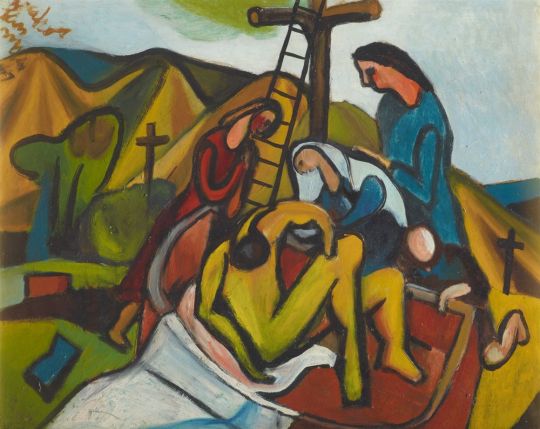
Artist. C. McCahon. (1947) Entombment (after Titian). [Painting]. Te Papa. https://collections.tepapa.govt.nz/object/44138
‘Colin McCahon’s interpretation of the execution of Jesus Christ on the cross borrows as much from a vernacular New Zealand setting and European Renaissance art as it does from the Bible’s high-tempo Gospel of Mark. McCahon’s plasticine-coloured hills and sky sing with primary school vibrancy. In the background, Jerusalem’s Temple curtain – which tore in two at the moment of Jesus’ death – is flung high from a simple country church. The speech balloons of Christ and those mocking him below, meanwhile, gain their sense of immediacy from the visual language of comic strips and small-town grocery store signage and packaging.’
Christchurch Art Gallery. (2020). As Time Unfolds. https://christchurchartgallery.org.nz/collection/82-50/colin-mccahon/crucifixion-according-to-st-mark
‘While I was at Rodney’s this weekend I saw your Crucifixion painting. It struck me greatly. Not that I am a competent critic of style; but this I found very moving. A Presbyterian rather than a Catholic occurrence. I mean – rawness, Christ suffering, not Christ triumphantly Son of God. The tags of speech are surprisingly successful, recalling (a) cartoon strips and (b) stained glass windows, though there one usually sees only the names of saints.’ James K Baxter in letter
In McCahon’s work, Christianity is contextualised in NZ. This is really interesting because we are so used to seeing Christianity in Greek and Roman settings. But What I love about this is that Christianity is for every nation and is intended for all people, and so it should be linked to people, contextualised to their way of life. McCahon does this by bringing in the vernacular to these scenes . I love this because Jesus was God incarnate, and he lived a total human life - with eating, and being tired, and working for a living. Jesus lived the vernacular life, as well as the spiritual! They entertwine! One informs the other. Coming back to that spiritual linking to the physical world.
It’s also interesting to note that McCahon was influenced by poet James K Baxter, who after sobering up and becoming a Christian, felt God calling him to serve a small Maori community ‘Jerusalem’ - a Maori settlement on the Whanganui River. Baxter went there to serve the marginalised people of the region. These artists also serving people... linking to the marginalised people. showing the relevance of Christ in relationship to us in every day, and to the marginalised in society.
‘In late 1968, as a result of a dream in which he heard the call ‘Go to Jerusalem’, Baxter travelled to a Maori settlement of the same name on the Whanganui River. Here he founded a community based on a fusion of Christian and Maori spiritual values. It provided a base for marginalised people – the drug-addicts, alcoholics, unemployed and homeless whom Baxter called, in Maori, his nga mokai (‘fatherless ones’) – and a place for sanctuary and healing. Here, in 1970, he wrote what is perhaps his best-known and acclaimed poem cycle, Jerusalem Sonnets.’
The pilgrimage of these artists McCahon and Baxter from art to faith, struggles with alcoholism, to serving the marginalised - particularly Maori people in NZ is really interesting to me personally because I am increasingly having dreams that head more this direction... eventually want to live up north with my partner to serve his iwi, having recently gotten involved with some volunteering work in conjunction with Auckland city Mission we have interest in serving marginalised people. And I keep trying to think how this all fits in with being an artist/designer. It’s very cool to know that people have travelled a similar path as creatives.

C. McCahon. (1979). May His Light shine. [Painting] Cornwall Park. https://www.mccahon.co.nz/cm001517
Also interestingly, McCahon’s work - particularly this religious period of work, got absolutely shredded for being ugly and a pretentious attempt at being religious. While quite honestly some of the depictions of Jesus scare me a bit because they are rather ’plasticine’ I think McCahon had a genuine heart that wanted to link these Biblical stories to vernacular Kiwi life, and did not want to avoid suffering. Even thinking about his context - NZ in a time that was filled with poverty Post war and the hard work of the land... these subjects have a deep relevance that in our modern western comfort we think we do not need.

C. McCahon. (1970). Scared. [Painting]. Te Papa. https://collections.tepapa.govt.nz/object/763435
‘A stark, blackboard-like image, Scared contains a brief text scrawled in white: ‘I am scared / I STAND UP’. These two phrases go to the heart of McCahon’s preoccupations: a confession of existential anxiety, couched in the most direct language, followed by a resounding declaration of courage and faith. The sense of urgency is reinforced by the script, which is hastily applied, spattering dots of white paint against the dark background.’
I love this so much. The rawness in McCahon’s work is the communication of a real faith. A wrestling that chooses to trust God regardless. the way faith infiltrates and touches all aspects of life. Someone who had failed and had doubts and struggled and chose faith regardless, and honest as every Christian should be, revealed his need for the grace of God. I also love the way McCahon uses text, this ‘typographical’ work makes me think about the link to design and the use of type to communicate.
M. Bloem, M. Browne. (2002). Colin McCahon: A Question of Faith. Craig Potton Publishing. https://www.mccahon.co.nz/questionoffaith
#maori#nz artist#spirituality#artist with biblical connection#christian art#wrestle#word painting#words
3 notes
·
View notes
Text
So, @argumate is up to some more prosocial atheistic trolling. As is usual with such things, the conversation isn’t particularly elevated, but it does make me nostalgic for the old bbc days. So I thought I’d be the Discourse I’d like to see in the world. This is the post that kicked things off; correctly noting Platonism as a philosophical foundation underpinning most versions of Abrahamic faiths. And it’s probably the most useful place for me to target also, since hardly anybody just identifies as a Platonist but most westerners are one. So, without further ado, a halfhearted and full-length defense of Platonism:
Well, strike that. A little bit of ado.
I’m not a Platonist myself, so this is a devil’s advocate type of thing. Or maybe you could call it an intellectual Turing test? As I discuss here, my philosophical commitments are mostly to skepticism, and for instrumental reasons, to reductionist materialism. That combo leaves me some wiggle room, and I find it fairly easy to provisionally occupy a religious mindset, so I can generally read and enjoy religious polemics. I also have a fairly deep roster of what are often called ‘spiritual experiences’; I’m probably in the set of people that are by nature predisposed to religion. I am not religious, and I approve of Argumate saying things like ‘God is not real’ a lot. This is in no way a retread of the arguments in The Republic or Plato’s other writings; you can go read those if you want, but I’m going to play around with stuff that I think is better suited to this audience.
Attention conservation notice: yikes. This got pretty long.
Anyway, on to the argument. Argumate’s main point is pretty clear, I think: ‘forms’ in the Greek sense are a function and product of the perceiving mind. Birds don’t conform to bird-ness; instead brains naturally produce a sort of bird-ness category to make processing the world easier, and to turn a series of wiggly and continuous phenomena into a discrete number of well-modeled objects. Basically, we impose ‘thing-ness’ on the wavefunction of reality. And there are some good reasons to think that it might be true! Our understanding of categories gets a lot sharper when reality conveniently segregates itself, and whenever that boundary gets a little blurry, our ability to use categories tends to break down. If the recognition of animal-ness came from contact with a higher plane of reality, you wouldn’t necessarily expect people to get confused about sponges.
But. While there’s certainly plenty of support for Argumate’s position, it doesn’t strike me as anything near self-evident, or necessarily true. So what I’ll argue is that Platonism isn’t obviously false, and that if we ever converge on a true answer to the question of our reality, then that truth could plausibly be recognizably Platonist. My opening salvo here is, predictably enough, mathematics.
‘Mathematical Platonism’ is a whole other thing, only distantly related to Classical Platonism, and I only really mean to talk about the latter. But nonetheless, mathematics really actually does appear to be a situation where we can simply sit in a chair, think deeply, and then more or less directly perceive truths. Basic arithmetic can be independently discovered, and usefully applied, by almost anybody; ‘quantity’ comes naturally to most humans, and the inviolable laws of quantity are exploited just as often. It’s also very hard to argue that these are ‘mere’ linguistic conventions, since fundamental natural behaviors like the conservation of mass depend on a kind of consistent logical framework. In most chemical reactions, the number of atomic nuclei does not change, and the atoms added to a new molecule are perfectly mirrored by the loss of atoms in some reactant; this remains true in times and places where no thinking mind exists to count them.
There are a lot of debates about what math is, fundamentally. But inevitably when we study math, we’re studying the set of things that must be true, given some premise: we’re asking whether some proposition is a necessary consequence of our axioms. The so-called ‘unreasonable effectiveness of mathematics’ suggests that the phenomena that Argumate mentions- hotdogs and birds and whatnot- are observed only within the auspices of a sort of super-phenomenon. Loosely speaking, we can call this super-phenomenon self-consistency.
We treat phenomena as having a natural cause. Platonism, at its crunchy intellectually rewarding center, represents a willingness to bite the bullet and say that self-consistency also has a cause. Plato himself actually provided what might be the most elegant possible answer! Basically, posit the simplest thing that meets the criterion of being A) autocausal and B) omnicausal, and then allow the self-consistency of the cosmos to follow from its dependence on (in Platonist terms, its emanation from) that single, unitary cause. The universe is self-consistent for the very straightforward reason that there’s only one thing. Any plurality, to the extent that plurality is even a thing, happens because ‘the only real thing’ is only partially expressed in a particular phenomenon. To skip ahead to Lewis’ Christian interpretation of all this, you’d say that humans and moons and hotdogs are distinguished from God not by what they have, but by what they lack.
And for present purposes, I do want to take a step back and point out that this does feel like a reasonable answer to a very important question. Materialism fundamentally has no answer to the question of self-consistency and/or the presence of logic and order, and that is (for me) one of its least satisfying limits. We’ve got things like ‘the origin of the universe’, sure. But we probe the Big Bang with mathematical models! That’s a hell of an assumption- namely, that even at the origin of our universe, self-consistency applies. It’s not like materialism has a bad explanation. It just remains silent, treats the problem as outside the domain. If we’re adopting the thing for utilitarian reasons, that’s fine. But if we’re treating materialism as a more comprehensive philosophy, a possible approach to the bigger questions, then it’s a painful absence. In that domain, far from being self-evidently true (in comparison to Platonism), materialism doesn’t even toss its hat in the ring!
Which, uh, gets us to the stuff about Forms and shadows in Plato’s Cave and all that- the intermediate form of existence between the omnisimple core of Platonism and the often chaotic and very plural experience of day-to-day life. And frankly, we’re not especially bound to say that the forms are exactly as Plato described them, any more than atomism is restricted to Democritus. Whether there is some ‘bird-ness’ that is supra- to all extant birds might be contestable; however, it’s easier to wonder whether ‘binary tree’ is supra- to speciation and the real pattern of differences between organisms that we map using Linnaean taxonomy.
But, this is an attempted defense of Platonism and not Toggle’s Version of Platonism that He Invented Because it’s Easier, so I’ll give it a try. Fair warning to the reader, what follows is not fully endorsed (even in the context of a devil’s advocate-type essay), except the broader claim that it’s not self-evidently false. And on the givens we came up with a couple paragraphs ago, this is a reasonable way to tackle what necessarily follows. So let me see how far I can defend a very strong claim: in a self-consistent (or: mathematical) cosmos, beauty cannot be arbitrary.
Remember that Plato never argued that his Forms were arbitrary, or even fully discrete as such; their apparent plurality, like our own, emanates from the unitary Thing What Exists. And so, bird-ness is treated as a contingent thing, not an absolute. It’s just not contingent on human experience. And so for us to believe in ‘bird-ness’ is to believe that there exists some specific and necessary pattern- a Form- which any given material bird must express.
Let’s take an obvious example: any flying bird will, for fairly simple aerodynamic reasons, tend to be symmetrical. Usually, this means two wings. In theory, you could… have one in the middle? Maybe? Even that seems rather goofy to try to imagine, but you could probably get away with it if you were extremely creative biologically. And if we see a bird with only one wing (without a prosthetic or other form of accommodation), then we will tend quite naturally to recognize that something awful is in the process of happening.
A fully materialist explanation of our reaction here would say: we think of the one-winged bird as problematic because A) we have been socialized to recognize and appreciate two-winged birds, and spurn deviations from that socialization, or maybe B) because natural selection has given us a set of instincts that recognize when a body plan has failed in the past, so things like ‘being crippled’ or ‘being sick’ are recognizable.
Platonism, I think, would offer a third option, that C) we recognize (as emanations of The Real Thing) that a one-winged bird body is insufficiently reflective of The Real Thing, and that accordingly it lacks the ability to keep existing. Plato had some… basically magical ideas, about how Forms are recognized, but here I’ll point out that ‘deduction’ is a completely serviceable kind of magic for our purposes. It is, after all, our direct experience of the self-consistency of the cosmos, which follows from the fact that we are ourselves an expression of that same self-consistency; it meets the criteria.
Materialists, obviously, would agree that deductive reasoning could allow a person to recognize the problems inherent in a one-winged bird, but as I said a few paragraphs up, their(/our) explanation of this process is rootless. “Yes, logic and a few high-confidence assumptions let you assume that a bird with only one wing is in trouble,” they might say. And we might ask- “what makes you so sure?” And then the materialist must respond, “Well, let me be more clear. It always worked in the past, and my Bayesian priors are strongly in the direction of the method continuing to bear fruit.” True enough, but it’s not an explanation and doesn’t pretend to be. The universe just does this weird thing for some reason; it works ‘by magic’. So why not call it that? Theurgy for all!
So, consider. We recognize (deductively, let’s say for the sake of argument) that a one-winged bird is on the road to becoming nonexistent, absent some change in circumstances. It may keep going for a little while, but it’s not in homeostasis. And if we reasonably admit this very basic duality to our thinking- things which can persist, and things which cannot- then we start to recognize a sort of analogy between physical phenomena and mathematical propositions. A lemma can be right or wrong, albeit sometimes unprovably so. Basically, it can follow- or not- from the axioms we’re working with. And in a softer but very real sense, that one-winged body plan is wrong analogously to the lemma’s wrongness. Not ‘wrong’ as in ‘counter to cultural norms’, but ‘wrong’ as in ‘unstable given the premises, given the Thing That Exists Most’. Look up research on fitness landscapes, if you’re so inclined- actual biological research isn’t totally unacquainted with the notion. There exists a surprisingly discrete ideal or set of ideals, both for flying birds as a whole and subordinately for any given flying bird species. And we have discovered this using magic.
Insofar as beauty is something to be admired, or pursued, or is otherwise desirable, then our sense of beauty must necessarily correlate with those abstract, and dare I say supra-real, qualities which allow things to persist, and which can therefore be understood deductively. And that set of qualities does, effectively, meet the Platonic criterion of a ‘form’.
The immediate materialist objection is: hey, wait a minute. The supposed ‘objective’ criterion of a bird is contingent, not absolute! It follows from the strength of gravity, the thickness of the atmosphere, the availability of food sources, and on and on. This is one of the most important reasons why genetic drift and speciation happens in the first place, because the ‘ideal’ bird depends on an environment that’s in constant flux.
True enough. But! How do you think the atmosphere got there? It’s an old trick in religious discourse, but in this case I think a valid one. The rightness of the bird depends on the atmosphere, the rightness of the atmosphere depends on the planet, the rightness of the planet depends on the solar system, and ultimately it all depends on that necessary self-consistency which (we proclaim) implies our unitary Most Real Thing. This does mean that we can’t really think of Platonic forms as wholly discrete objects, unconnected to one another and without internal relation among themselves- unfortunately, that’s part of the original Plato that I don’t see as defensible, even with maximum charity. But there’s such a thing as a ‘ring species’, and if we admit Platonic Forms of that type, a kind of dense network of paths being traced through higher-dimensional spaces that correspond to the shadow of That Than Which There Is No Whicher, then it’s more than salvageable. It’s both satisfying to imagine and, I think, quite consistent with the spirit of the original philosophy.
One thing this doesn’t mean. Even if we were to accept all of this, we aren’t obliged to resign ourselves to the lot of that one-winged bird. Indeed, if anything this gives us a rich language by which to justify a prosthetic wing or other form of accommodation: we can talk about ‘making the bird whole’, and can see how our compassion for that bird might lead us to create the conditions of homeostasis once again. But it does mean that if we take a position on the merits of existence- if we’re in favor- then we don’t treat a one- and two-winged bird as coequal scenarios.
Anyway, this has gone on hideously long already for what’s basically an intellectual exercise, so I won’t dive into immortal souls or any of the other ancillaries. I mostly want to reiterate that, far from being obviously false, I do think that (some forms of) Platonism are quite defensible, and can provide coherent answers to questions that I A) care about very deeply and B) can’t resolve to my own satisfaction. Of course, it is not obviously nor trivially true, either. But one can be Platonist without being willfully wrong.
67 notes
·
View notes
Text
Sunday Afternoon Session
Oh Say What is Truth
Softly and Tenderly
Henry B. Eyring
“Of course it’s hard! It’s supposed to be! Life is a test!”
We are being proved to see if we will do what God has commanded
They love you..Your success is Their success
God has the power to make our way easier
He knows that we must grow in spiritual cleanliness and stature to be able to return to Him
In all things the Saviors example will be our guide
When you remember how much pain you can endure well, Remember Him. He suffered what you suffered so that He would know how to lift you up.
1 way will be to invite you always to Remember Him and Come unto Him
Feast upon His words
Faith unto repentance
Baptized and then keep covenants with God
D&C 58:4
When we lift another’s burden even a little our burdens are lightened
We must notice the suffering of others and try to help
Jeremy R. Jaggi – seventy
The day dawn is breaking, the world is awaking, the clouds of nights darkness are fleeing away
Count it all joy (James 1:2-4)
Let your trials work for your good
Of all the zealous social, religious, and political endeavors of our day, let ‘disciple of Jesus Christ’ be our most pronounced and affirming affiliation.
When we exercise patience our faith increases. When our faith increases, we have joy.
Where we make sacred covenants, the temple, is closed. Where we keep sacred covenants, our homes, are open.
“Be of good cheer” is the commandment from the Lord, not be of good fear
Hear, hearken, and heed the voice of the Prophet
Gary E. Stevenson
is something the Lord gives us to help us grow
God wants us to know that He will never abandon us, he will always be with us
We can help each other know that we can be blessed during adversity
Temple ordinances we have missed seem sweeter than previously imagined
Go forward and not backward and on, on to the victory
Acknowledge the afflictions in the course of our days, while also acknowledging that we are God’s children
I believe that one day, each of you will look back at the canceled events, the sadness, disappointments and loneliness attendant to the challenging times we are passing through to see it overshadowed by choice blessings and increased faith and testimonies.
He is my Savior, my redeemer, my hope, and consolation
Milton da Rocha Camargo – Sunday School 1st counselor
His impressions are really
He who seeks will find
We seek because we trust the Lord’s promises
Communication with our Father in Heaven enables us to sort through what is true and what is false, what is relevant to the Lord’s plan for us and what is not
To knock is to act in faith. When we actively follow Him, the Lord takes notice
I am here. I love you. Go on, do your best. I’ll support you.
He may not answer all of our questions or solve all of our problems right away; rather, He encourages us to keep trying. If we align our plan with His, He will guide us
Guide Us O Thou Great Jehovah
Dale G. Renlund
Salvation is not earned
We can never do enough or be enough by ourselves. The good news though, is that because of Jesus Christ and His atonement we can become enough
We can be redeemed and stand pure and clean before God
Do justly, love mercy, and walk humbly before God (Micah 6:8)
Do justly is a practical application of the two greatest commandments
Broken heart and contrite spirit entice us to joyfully repent
God delights in mercy and does not begrudge its use
Leviticus 19:18
Always dealing well with others is part of loving mercy
When you become a physician you work to heal people, if you do otherwise you do not deserve to be here
Loving mercy means that we do not just love the mercy God extends to us, but also the mercy He extends to others
You shall not esteem one flesh above another Mosiah 23:7
Treat everyone with love and understanding regardless of characteristics such as race, sexual orientation, religious affiliation etc (I missed the rest ahh)
When ye do these things, you are on the covenant path
Kelly R. Johnson – seventy
What power and knowledge are you endowed with and will yet be endowed with?
Power of God is the power to do more than we can do by ourselves
Burning microwave ahahahahaha
Those who have faith and the word of God deep in their hearts will be able to absorb and overcome the fiery darts which the adversary will surely send to destroy us. Otherwise, our faith, hope and conviction may not endure, and like [an] empty microwave oven, we could become a casualty.
His power diminishes in our lives only if we fail to keep our sacred covenants
et a clear unchanging course in your life
There is no expiration date associated with the power God bestows upon those who make and keep temple covenants, or a restriction from accessing that power during a pandemic
Jeffrey R. Holland
Why the delay of help to come?
while we work and wait together for the answers to some of our prayers I offer you my Apostolic promise that they are heard and they are answered though perhaps not at the time or in the way that we want it but they are always answered at the time and in the way an eternally compassionate parent should answer them
he who never sleeps nor slumbers cares for the happiness of his children above all else that a divine being has to do
He is pure love gloriously personified and Merciful Father is His name
yes God can provide miracles instantaneously but sooner or later we learn that the times and seasons of our mortal journey are his alone to direct
for every infirm man healed instantly as he waits to enter the pool of Bethesda someone else will spend 40 years in the desert waiting to enter the promised land; for every nephi and Lehi divinely protected by an encircling flame of fire for their faith we have an abinadi burned at the stake of flaming fire for his; and we remember that the same Elijah though in an instant called down fire from heaven to bear witness against the priests of baal is the same Elijah who went through a season when there was no rain for years and who for a time was found only by the skimpy sustenance that could be carried in a raven's claw - by my estimation that can't have been anything we would call a happy meal
he point is that faith means trusting God in good times and bad even if that includes some suffering until we see his arm revealed in our behalf
one’s life cannot be both faith filled and stress free it simply will not work
Christianity is comforting but it is often not comfortable. the path to holiness and happiness here and hereafter is a long and sometimes rocky one it takes time and tenacity to walk it but of course the reward for doing so is monumental (taught in Alma 32)
a call for diligence and patience in nurturing the word of God in our hearts, waiting as He says with longsuffering, for the tree to bring forth fruit unto you
when will these burdens be lifted? well the answer is by and by and whether that be a short period or a long one – it is not always hours
by the grace of God the blessings will come to those who hold fast to the gospel of Jesus Christ
those who wait upon the Lord shall renew their strength and shall Mount up with wings of Eagles they shall run and not be weary they shall walk and not faint
Russelll M. Nelson
the Lord wants you to feel we live in a glorious age foreseen by prophets for centuries. this is the dispensation when no spiritual blessing will be
the Lord would have us look forward to the future with joyful anticipation
let us not spin our wheels in the memories of yesterday the gathering of Israel moves forward
The Lord Jesus Christ directs the affairs of His church and it will achieve its divine objectives.
the challenge is to make certain that each of us will achieve his or her divine potential
turn your heart mind and soul increasingly to our Heavenly Father and His son Jesus Christ, let that be your new normal
daily seek to be increasingly pure in thought, word, and deed; minister to others; keep an eternal perspective; magnify your callings
whatever your challenges live each day so that you are more prepared to meet your maker
Tarawa, Kiribati; Port Vila Vanatu; Lindon, Utah; Greater Guatemala City, Guatemala; Sao Paulo East, Brazil; Santa Cruz Bolivia
as we build and maintain these temples we pray that each of you will build and maintain yourself so you can be worthy to enter the holy temple
I bless you to be filled with the peace of the Lord Jesus Christ. His peace is beyond all mortal understanding. I bless you with an increased desire and ability to obey the laws of God. I promise that as you do you will be showered with blessings including greater courage, increased personal revelation, sweet harmony in your homes
God Be With You till We Meet Again
#ldsconf#generalconference#general conference#genconf#tumblrstake#church of jesus christ of latter-day saints
13 notes
·
View notes
Text
Spirituality Defined

Where did our working definition of spirituality come from? How has it evolved over centuries of research, ritual and belief? Philosophy grad Brayte Singletary stopped by the blog this week to take us on deep dive into the ever-elusive meaning of spirituality. Enjoy!
What even is spirituality? Rachel asks that very question in one of this blog’s first posts, and gives her answer there too. It’s one of the fundamental questions of spiritual direction. Those seeking or giving spiritual direction are liable to stumble on it sooner or later, through education or reflection. This post is one of those trips—and since it’s a bone we may need help chewing, I attempt to shine some Sirius-light on the best research I could dig up. Hopefully it’s illuminating.
In 2016 some researchers in Germany and the U.S. published the results of a formal investigation into the meaning of spirituality [A]. They based their investigation on a 2011 survey of Germans and Americans that asked, among other questions, “How would you define the term ‘spirituality’?” Approximately eighteen hundred different definitions came back, about forty percent German and sixty percent American. Quantifying these samples, the researchers started running statistical analysis.
First they looked for categories of response, grouping similar categories together and narrowing the list down to just those that make the most sense of overall response patterns [B]. They found that ten basically distinct concept clusters [C] come under the heading of spirituality, almost always in some combination [D]:
A keenly-felt connection to and harmony with nature, humanity, the world, the universe, or the whole of reality.
Dependence on, relationship to, or union with the divine; a part of religion, esp. Christianity.
A search for one’s higher or true inner self, meaning, purpose; knowledge of these things; attainment of peace or enlightenment, esp. in terms of a path or journey [E].
Holding and daily acting according to ethical values, especially in relation to others, one’s community, or humanity; a moral way of life [F].
Faith or belief in transmundane forces, energies, beings, a higher power, gods or God.
A noncommittal, indefinite, but intensely emotional, maybe loving sense that there is some thing(s) or being(s) higher than and beyond this world, this life, or oneself [G].
Experience and contemplation of reality and the truth, meaning, purpose, and wisdom, esp. if considered beyond scientific or rational understanding, inexplicable and indemonstrable.
Awareness of and attunement to another, immaterial or supernatural realm and its denizens (spirits, angels, ghosts, etc.); feeling their presence; using special techniques to perceive and interact with them (tarot, crystals, seances, etc.).
Opposite religion, dogma, rules, traditions; unstructured, irreverent, religious individualism.
Individual or private religious practice; prayer, worship, or meditation; relationship-deepening or connection-fostering personal rituals and devotional acts.
Doing the same grouping and narrowing to unearth anything deeper, they found that all of these ten clusters fall somewhere on three scales, which they call the dimensions of spirituality [H]:
I. Vertical vs. horizontal general terminology for transcendence [I]
II. Theistic vs. non-theistic specific terminology for transcendence
III. Individual vs. institutional mediation of transcendence
Finally they found that this analysis confirms their larger research team’s theoretically-grounded hypothesis that the root definition of spirituality is:
Individually-mediated, experience-directed religion, esp. among religious nones [J]: i.e., religion oriented away from mediation through institutions, dependence on organizational structures and absolute authority claims, toward the immediacy of firsthand experience, emancipatory independence and value relative to the individual [K].
All this verbiage cries out for explanation. But for the moment let’s step back to marvel at our good luck in having research like this. Its conclusions about the meaning of spirituality—at least the ten concept clusters and three scales—came through something nearer experimentation in a laboratory than reflection in an armchair. In philosophical jargon, this argus-eyed approach was a posteriori rather than a priori; in anthropological jargon, emic rather than etic. As a result, we better see wrinkles in the meaning of spirituality, including internal inconsistencies that a cyclopic definitional scheme might smooth over, e.g., as a part of religion (2) and as opposite it (10).
For starters then, we see that this definition of spirituality is tripartite: “individually-mediated”, “experience-directed”, and “religion”. Since spirituality here is a kind of religion, religion is the core concept, so we’ll take it from there. That will lead to the three scales of spirituality, ‘vertical vs. horizontal terminology’ (I), ‘theistic vs. non-theistic terminology’ (II), and ‘individual vs. institutional mediation’ (III). “Individually-mediated” will come along with the third. That leaves only “experience-directed” and closing remarks. Now where did I put my patience for dry exposition…?
If none of it jibes with your own sense of spirituality, all the better! We all have much to learn, and outliers—you whose lives are led under stones yet unturned by science—have much to teach us.
First “religion”: For these researchers religion is any socially constructed system of symbols and rituals that interprets transcendent experience in ultimate terms [L]. This applies even to people who don’t consider themselves religious, including those who would self-describe as “spiritual but not religious”. But precisely what do transcendent experience and ultimate mean here? Transcendent experience—or simply ‘transcendence’—is any experience of “distance and departure from [the] everyday”, above and beyond the boundaries of ordinary experience [M]. More than just extraordinary, it exceeds our expectations of life and the world as we know it, e.g., by excelling in its class or defying classification (almost) altogether: the weirder and more wonderful, the more transcendent. So transcendent experience is often what we would traditionally call ‘religious experience’, but they make the distinction that it only counts as religious if on interpretation it’s cast in ultimate terms. Turning to “ultimate” then, here this is really elliptical for ‘of ultimate concern or importance to a person’. The ultimate is what “gives depth, direction and unity to all other concerns”, as theologian Paul Tillich puts it, from whom they draw the idea—e.g., our answers to basic questions about the world and our place in it [N]. Bringing these ideas together, a merely transcendent experience becomes genuinely religious when we see in it something all-important to us, and it becomes full-fledged religion when we build around it a symbolic-ritualistic framework of beliefs and practices. One’s framework needn’t be grand or widely-shared: it might be a slim private affair, like a single-person tent that’s as easy to pitch as to pack up and carry. Likewise a person can bring to transcendent experience a religious interpretive lens, or craft one afterwards just to come to terms with it. Either priority fits.
Before we move on to the next concept, let’s clear up some potentially misleading language in this definition of religion. To start, “socially constructed” here doesn’t necessarily mean ‘made up’, ‘fake’, or otherwise unreal. It just means that if nobody thought or talked about religion, there wouldn’t be any: its existence depends on its exercise. Likewise the claim that it “interprets” transcendent experience doesn't imply that it therefore misinterprets it. Indeed the opposite may well be true. Even elementary sense perception needs interpretation to become understanding: naked experience unclothed by categories or classifications is at best a muddle—e.g., in rounding an unfamiliar corner in the city or in coming out without warning on an open expanse in the country, when the sudden change of scenery produces a visual experience of undifferentiated shape and color, it’s all just optical nonsense until reason and intellect, as it were, catch up, and organize this sense data into a coherent picture: only then when interpretation goes to work does one finally know what she’s looking at. Although we may at times be apt to make meaning where there is none, often enough we find it right where it belongs. So this definition doesn’t debunk religion; it merely says that, assuming it has this experiential basis, it’s imbued with the meaning we give it, veracious or fallacious.
The terminology of our interpretation, i.e., our way of using terms for and ideas about the ultimate, admits of a couple distinctions. These are also the first and second scales of spirituality above (I-II): vertical-horizontal, and within that, theistic and non-theistic [O]. The former measures the metaphysical distance transcendent experience crosses. The latter measures the unity and personality and sometimes also the clarity of the religious object. Vertical terminology characteristically evokes what we would traditionally call the transcendent, e.g., God and heaven—generally, the otherworldly. It aims at things other than and over this world and oneself in it. Horizontal terminology tends the other way, toward the traditionally immanent, e.g., nature and humanity. Leaning this-worldly, it aims at things in and of the world and the world itself. Notably, whereas the vertical is often explicitly religious, the horizontal’s religiosity can even escape the notice of the person professing it [P]. Within this distinction is that between theistic and non-theistic terminology. The apparent presence of God, gods, and god-like beings or forces maps an important area of vertically transcendent experience, as their apparent absence does an antipodean area of horizontally transcendent experience. But this also sheds light on terminology between vertical and horizontal. This family of views sees the ultimate as in neither our world nor a world beyond, but rather in “a world behind”, i.e., behind and beneath the world’s surface appearances [Q]. Typically this is non-theistic, e.g., about ghosts, spirits, energies, or forces.
A gloss of the third scale (III) now moves into view, and with it “individually-mediated”: Individual-institutional mediation of transcendence measures the directness or indirectness of a person’s access to transcendent experience, i.e., the extent and power of the gatekeepers standing in her way. As these researchers put it, “Institutionalized mediation says that ... there is no other way to transcendence than through the church, sacraments, and priests; that there is no other truth than the sanctioned teachings; and that the ultimate concern is determined by the institution and its tradition” [R]. By contrast, and often in vociferous reply, individual-mediation says, “there is no or very little mediation of transcendence, but rather the experiential immediacy of the individual; there are no claims of absoluteness, but the individualistic evidence of experience; there is no or very little organization or structure" [S]. In this way, against so-called organized religion’s usual mediation by institutions, esp. hierarchical structures operating them, spirituality favors an unpatrolled, gates-wide-open setup. Yet it doesn’t follow from such independence that spirituality is therefore a lonely pursuit—though “flight of the alone to the Alone”, i.e., hermetic mysticism, is surely right at home here too [T]. We’re able to have experiences with others, just not for them, so it can be equally possible to pursue direct experience of transcendence with others as by oneself.
Lastly, “experience-directed”: This means that, whereas transcendent experience might play no ongoing role in a religion’s usual exercise, e.g., as none other than an oft-remembered historical event, in spirituality it takes the lead. Ritual, symbol, etc., become at best aids to pursuit of transcendence, but at worst impediments. Therefore spirituality in its purest, i.e., barest, form may focus on such experience exclusively; and since “directed” here means both ‘directed to’ and ‘directed by’, the religious ideal may resemble an upward spiral of being led from transcendence to transcendence by transcendence. Still this isn’t to say that spirituality takes direction from nothing else, or that by focusing on transcendence even exclusively, the rest of familiar religion vanishes. A spiritual purist may disavow religious side projects in pursuit of her wonted mode of transcendence, or she may simply subordinate them to it as various means to this end. Yet while she might style herself as therefore unencumbered in her pursuit of raw experience, her religious interpretive lens remains ever-present, however unwittingly. It must, or else her chase after the spiritual would be of the wild-goose variety. E.g., someone undergoing a crisis of faith might discover to her horror that she’s no longer able to participate in her favorite religious exercises, since the vinegar of doubt now spoils every well from which she used to draw joy. Since her experiences can’t mean what they used to, they can’t be what they used to either.
Let’s sum up with a little illustration. Consider this spiritual foil: one an atheistic nature lover, the other a Catholic anchoress. The former’s approach is thoroughly horizontal and non-theistic. She takes regular hikes to feast on natural beauty and sublimity, but deems it all mere serendipity in a chaotic cosmos. She’s a proficient adventurer, as comfortable with friends as without. She might not spurn a Beatrice to guide her through some earthly paradise, but her trust would be that when she came face to facelessness with wild abundance, her delight would need no shepherd. The abundance itself would call out of her everything necessary for its appreciation. In this way she mediates her own pursuit of these experiences. Their ultimacy for her comes not only from her denial of the otherworldly, but also from her judgment that nature is intrinsically, i.e., ultimately, good—or at least, that immersion in it stirs and sustains her is. Conversely, the latter’s approach is thoroughly theistic and vertical, and manifestly ultimate. She spends her life in solitary prayer. Sometimes during contemplation of the divine she has ecstatic visions or auditions. But whatever happens, her daily goal is total abandonment to God. Still even with the individuality of her self-mediating lifestyle, it retains considerable institutionality. She holds fast to piety towards the Church, its orthodoxy and orthopraxy. Yet despite this rigid adherence to ecclesiastical authority—or, she would say, because of it—, she lives as a recluse whose sole aim is attaining union with Him Whom she worships as Transcendence Itself. Both in their disparate ways are individually-mediated, experience-directed religion.
Here we are then! We’ve gained at long last the real meaning of spirituality, right? Well, maybe: We have to trust not only that German and American ideas of spirituality are the same as everybody else’s, but also that the notions of these particular people are the same as those of other Germans and Americans [U]. Moreover we must take for granted that what they put in Tweet-sized writing when a survey bluntly asked them their opinion is the same as what they think all the time, even when they’re not thinking about what they think [V]. Still science has yet to master the art of mind-reading. So even if this isn’t the definitive definition of ‘spirituality’, it’s got my money for our best guess yet.
In Rachel’s post, she’s wise to the width of variety, saying, “Spirituality has been defined and redefined throughout human history, and it is now my intention to shout yet another definition to the abyss.” For her, its definition is: “the practice of deriving any amount of meaning from any event, thought, or activity.” Looking back at the ten concept clusters above, this bears striking resemblance to parts of (3) and (7). She’s in good company. Clinicians and care professionals typically promote this conception: e.g., psychological measures of wellbeing that account for spirituality usually cast it in these terms, viz., purpose and meaning. Though some have wondered whether this confuses spirituality with a part of mental health, the findings above resoundingly vindicate it as an important part of the spiritual puzzle [W]. If they also solve that puzzle, hopefully they do so more in the spirit of Ariadne’s clue out of the Labyrinth than Alexander’s sword through the Knot. At the very least, such research is a waypoint on the path to understanding. If none of it jibes with your own sense of spirituality, all the better! We all have much to learn, and outliers—you whose lives are led under stones yet unturned by science—have much to teach us. So it’s still worth asking:
What does spirituality mean to you? Please share your definition in the comments.
Unpack what spirituality uniquely means to you through the ancient practice of spiritual direction. Schedule a free online session through the link in the comments.
Endnotes:
A. Eisenmann, Clemens, et al. “Dimensions of “Spirituality”: The Semantics of Subjective Definitions.” Semantics and Psychology of Spirituality: A Cross-Cultural Analysis, ed. by Heinz Streib & Ralph Wood, Jr., Springer, 2016, p. 125.
B. Op. cit., pp.129-35. Before grouping and narrowing them together and down, these were the forty-four recurring categories they found:
Faith and belief, believing, belief system
Connectedness, relationship, in touch with, harmony
Individual, personal, private, subjective
Everyday, daily life, way of life, to act
Values, (higher) order, morals, karma
God (also the Father, Lord, Creator, the Divine)
Unspecified transcendent: something bigger, beyond, greater; “may be”
Feeling, emotion, intuition, empathy, heart, love
Within, self, higher Self, inner core, essence
Seeking, path, journey, reaching, to evolve, to achieve
Awareness, consciousness, sense of, feeling a presence, in tune
Supernatural, non-material, cannot see or touch
Transcendental higher power/forces/energy
Thinking about, to understand, to reflect, contemplation
Relation to the world, nature, environment, universe
Cannot be explained or scientifically proven, beyond understanding
Higher/beyond/greater/other than oneself/humans/this life
Relation to others, community, all humanity, humankind
Experience, sensory perception Spirit and mind
Rest (i.e., the remainder of uncategorized responses)
Practices, to practice (one’s faith), music, prayer, worship, meditation
(Inner) peace, enlightenment and other attitudes and states of being
Guided, destined, controlled, saved, healed, dependent
Part of religion, Christian, biblical
All-connectedness, part of something bigger
Meaning and (higher) purpose, questions and answers
Transcendental absolute, “unity of existence,” omnipresent and indiscriminate, the one
Otherworldly, beyond this world, “spiritual” realms Acknowledge, to recognize, to accept, to realize Vague, unclear, unsure; bullshit, fantasy, hocus pocus Without rules, tradition, norms, dogma, structure, directions (21) Something else than religion, without worship
Energies, vital principle, ghosts, angels and demons, spirits
The truth, true nature of existence, wisdom, reality (4) Jesus, Christ, Holy Spirit, the Son Greater being/person, deities, gods Soul
Universal category, basis of mankind Esoteric, occultism, spiritism, mystic, magic (39) Deal with, interest in, engagement, focus
Part and beyond religion Obedience and devotion Life after death.
C. I borrow the notion of concept clusters from passing familiarity with Ludwig Wittgenstein’s philosophy of language.
D. Op. cit., pp. 137-8. Paraphrase.
E. Whereas spirituality conceived of as a part of religion (2) fits nicely with its mostly premodern history as just that, the conception immediately following of it as a journey to one’s true inner self (3) sits well with modern social movements toward individualism and subjectivism: op. cit., p. 146.
F. Spirituality conceived of as living out one’s values may partly underlie the self-identification “spiritual but not religious”. Here ’spirituality’ primarily indicates an ethical concern that being merely ‘religious’ doesn’t—not just talking the talk but walking the walk: ibid. More clearly this identification involves some combination of clusters with (9).
G. The much-maligned vagueness of spirituality’s meaning may come from this conception of it as a sense of something indefinite and beyond: ibid. N.b., philosophers of language usually distinguish vagueness, i.e., unclear meaning due to imprecise extension over borderline cases, from ambiguity, i.e., unclear meaning due to polysemy—having multiple meanings.
H. Op. cit., p. 143. Paraphrase. Their dimensions are: (I) mystical vs. humanistic transcending; (II) theistic vs. non-theistic transcendence; and (III) individual “lived” experience vs. dogmatism.
I. I use “transcendence” and “transcendent experience” interchangeably throughout this post. Though there may be other forms of transcendence than experience, talk of ‘transcendence’ as an event and not, e.g., as a divine attribute, usually means ‘experience of transcendence’, i.e., ‘transcendent experience’.
J. Religious nones get their names from those who answer “none” to demographic polls asking their religious affiliation. In other words, they are the religiously unaffiliated. Cf. unchurched.
K. Op. cit., p. 148. Paraphrase. Their definition is privatized experience-oriented religion, following research by other members of their team: Streib, Heinz, & Wood, Jr., Ralph. “Understanding “Spirituality”—Conceputal Considerations.” Semantics and Psychology of Spirituality: A Cross-Cultural Analysis, ed. by Heinz Streib & Ralph Wood, Jr., Springer, 2016, p. 9. Ensuing fns. refer to that ch.
L. Op. cit., p. 11. Cf. Emile Durkheim’s definition of religion, popular esp. in U.S. religious studies depts.: “a unified system of beliefs and practices relative to sacred things, that is to say, things set apart and forbidden—beliefs and practices which unite into one single moral community called a Church, all those who adhere to them”: The Elementary Forms of Religious Life. trans. Carol Cosman, Oxford Univ. Press, 2001, p. 46.
M. Op. cit., p. 10.
N. Op. cit., p. 11.
O. Strictly speaking, non-theistic terminology could be either vertical or horizontal, while theistic terminology is by definition vertical. As it happens however, or at least according to this research, our thinking about spirituality typically separates out the theistic and vertical from the non-theistic and horizontal.
P. Op. cit., p. 12.
Q. Ibid.
R. Op. cit. p. 14.
S. Ibid. They also mention here sectarian middle mediation “through a prophetic and charismatic person”.
T. Famous last words of the Neoplatonic classic: Plotinus. Enneads. VI.9.11. trans. Andrew Louth, qtd. in The Origins of the Christian Mystical Tradition: From Plato to Denys, Oxford Univ. Press, 1981, p. 51.
U. Cf. WEIRD bias (Western, educated, industrialized, rich, and democratic), an ongoing problem for representative sampling: Henrich, Joseph, Heine, Steven J., & Norenzayan, Ara. “The weirdest people in the world?” Behavioral and Brain Sciences, 33, 2-3, 2010, 61–83. In fact there were some statistically significant differences between German and American responses: American definitions of spirituality were more Christian or otherwise traditionally religious, mentioning Jesus and the Holy Spirit much more, but God only a little more—presumably because theism goes beyond Christianity. Still when they did mention God it was more often in Christian terms of a personal and sovereign lord. Likewise they mentioned faith and belief much more often, and this was more often faith or belief in something beyond, higher power(s), god(s), or God (5). Their notions of spiritual power were also further outside and over themselves, as in talk of guidance or obedience. By contrast German definitions of spirituality were warier of dogma and authority, whether religious orthodoxy or scientific consensus. They mentioned experience, as opposed to belief, more often, and were generally more esoteric, occult, and magical in their terminology, talking of the otherworldly in more universal but impersonal or abstract, terms. They were also more critical of spirituality, oftener complaining of its vagueness or even dismissing it as bovine fecal material. Still despite all this the researchers noted that American and German definitions were much, much more alike than different. These differences should therefore be understood as in emphasis, not substance. Their considerable overlap, striking in itself, forms the basis of the ten concept clusters and the three scales.
V. We must also assume that the scientific method deserves our confidence, and that the concept of spirituality, if not spirituality itself, is amenable to investigation by it. Other assumptions include those about word meaning, natural kinds, and other hot topics of debate in the philosophy of language and science—all of which would take us far afield of the present discussion. May curious readers experience transcendence of this post!
W. Eisenmann, Clemens, et al., p. 147.
#spiritual#spirituality#Religion#religious#theology#philosophy#Religious Studies#spiritual but not religious#spiritual direction#spiritual director#spiritual direction denver#denver spirituality#history of religion#spiritual journey#faith#belief#soul care
3 notes
·
View notes
Note
Can I ask about your religion? I’m catholic but I’m feeling so drawn to Hellenic Paganism but I’m so scared. I don’t want to believe it because I don’t want to go to hell. But I feel something for Hellenism and I’m just confused. I’ve felt something reading about it. It’s so scary to me b/c I do believe in Catholicism. I don’t know what to do with these feelings tho.
Hi! I apologise in advance for how long this answer was but I wanted to be as specific as possible.
You are more than welcomed to ask me about my religion.
This ask was a little hard to answer because I believe in the freedom of allowing anyone to worship whatever faith they want to believe in, but because you are asking me about my religion, I'm assuming you're asking me about what led to me leaving Catholicism for that religion as well.
Before I continue I just want to say that I respect your decision to stay in Catholicism because although it wasn't kind to me due to it's rigid structure and politics, it is a religion others find comfort in, and I would never dream of bashing what others believe in.
Having said that, I would like to talk about what led me to my spiritual divorce from Catholicism when I was once also confused and afraid about the idea of "going to hell."
---------------------------
My childhood:
I grew up in a very poor neighborhood during a time when gang wars, kidnappings and homicides were so rampant that my 5 year old self wondered if I would ever live to see 10. That's when I met my "imaginary friend."
"Who are you?" I asked.
"Your ancestors know me as Mars." He replied. My real last name is Roman and it literally translates to "Child of Mars." It has been in my family for so many generations but I didn't make the connection until I got older.
He introduced himself as just a Roman soldier although his uniform looked nothing like the ones my church showed when they did re-enactments.
He taught me how to fight, defend myself, be cautious, assess my surroundings, how to work around a panic attack and basically taught me how to survive.
Back then we didn't have smartphones and the internet wasn't as informative as it is now so I was sheltered from anything that wasn't Catholic, including Ancient Greek things so I wasn't able to identify him which is funny because "Mars" had a very Spartan looking outfit rather than a Roman one. I would often ask about it. "I like it better" was always his reply. I would often introduce him as "my weird looking Roman friend, Mars." I didn't know about the Roman gods Mars, Jupiter, Venus, etc. I just thought he was really into the planet Mars for some reason.
My Catholic upbringing was so sheltered, I was sure I was going to end up being a nun because of how much I studied it and how little I knew about the political history surrounding it.
I was fascinated by Satan and always wondered about the appropriatness of his punishment, for example, if he likes bad things and bad things are in hell, wouldn't he be surrounded by the things he likes? If god punished the wicked by sending them to hell in order to be punished by Satan, wasn't Satan helping god punish the wicked? Or the idea that Mary was not a goddess but was venerated like one.
It never made any sense to me until I started going to school and became friends with people who practiced Buddhism and Hinduism. They told me about reincarnation, an idea which made a lot more sense to me.
The more they told me about their religions, their multiple gods and female gods, the more they made sense to me, so I started researching other religions and bumped into Wicca. (I'm not wiccan but it was the only thing I could find at the time, in the 90s, about female empowerment (because I was tired of the sexism laced in the Bible) in a religious setting without me encroaching in Buddhism and Hinduism)
Wicca made me realize my friend Mars was actually Ares, god of war. The book was so nasty (and I will later learn, very inaccurate) about Ares that he and I ended up having a falling out. I was afraid and wondered if I was going to hell but then I said to myself "it'll only be temporary because then I'll be reincarnated." Reincarnation had officially become part of my personal philosophy.
There was a section in Wicca that talked about religion. It talked about various religions and the history of how Christianity demonized them. So I started reading as much as I could about the history of Christianity and Catholicism outside of the Wicca books that mentioned them. The more I learned about the political structure of Catholicism, the more I could see the gods sprinkled in the religion.
For example: Jesus and Osiris: both born December 25th, both born to Virgins, A star led 3 wise men to both (for Jesus it was the North Star, for Osiris it was the Eastern Star), Both taken to Egypt to escape the wrath of (for Jesus: Herod, for Osiris: Typhon), both taught in a temple as a child, both baptized at 30, both had twelve disciples, both could perform miracles, both walked on water, both raised someone from the dead (Jesus: Lazarus, Osiris: El-Azur-us) both were crucified, buried in a tomb, both were dead for 3 days and both resurrected, both had titles like "The Messiah", "the good shephard", "lamb of god", etc.
Jesus and Dionysus: Both wandered around, both could turn water into wine, both had legions of followers, both were persecuted, both claimed to be the son of God, both called holy child and if you want to get technical with Dionysus being born from a virgin because Jesus being the true son of God implies Mary was with God but technically a virgin because she had never been with an actual human man. By this technicality, Dionysus' mother Semele was also a virgin since she had never been with a human man.
Here's a couple more for Jesus:

Then you have the Christian holidays with Pagan roots and history: (LINK)
Example: Easter has bunnies and eggs because they are the symbols that represent fertility, which was used by the pagans to celebrate the Assyrian and Babalonian goddess Ishtar (pronunciation sounds a lot like Easter). This is why even though in Catholicism Easter is for the resurrection of Christ, there are eggs and bunnies which never made sense to me until I learn about Ishtar.
The reason why there are so many pagan symbols is because Catholicism didn't start until 300-400 years AFTER the death of Jesus. The Roman empire decided it was going to be Christian and in the process it forced the other countries it ruled over to be Christian as well. But because Pagans love their gods, they had to figure out how to sway them so they looked at their gods and holidays and appropriated them.
Because there were other Romans who still loved their gods and wanted to keep them despite the emperor, they created angels saints with ambiguous backgrounds but could do a lot of things that gods could do and we're used as avatars for their gods like Hermes being the messenger of Zeus (the god of gods) and Gabriel being the messenger of God.
The idea of a one true god is also a political tactic that uses fear which works because the human brain has evolved to respond better to fear thanks to evolution. In the beginning, Catholicism acknowledged other religions but claimed their god was the best one, hence when the Bible or prayer says "You will worship no other gods before me" which I always thought was a weird thing the Bible had because how could one worship other gods when there was only one god?
The idea of there only being a "one true god" came during the dark ages where people would accuse each other of being witches and working with the devil. Here is when Christianity started equating pagan gods with demons and devils.
The dark ages and persecutions were SO BRUTAL that fear became a thing synonymous with Catholicism thanks to the Spanish Inquisition that would randomly show up to make sure people were "properly" following the word of the Pope and not worshipping pagan gods now dubbed demons. This is where the idea of "going to hell" came from.
I also didn't like that the Catholic Church would automatically forgive the rich that would give them money and basically buy their way into heaven which was an actual rule and the reason why Martin Luther created the Protestant section of Christianity.
As for wether or not the gods are real, I will only say that for me, they are and possibly for these ex-non-believers who had very specific signs happen to them: PLEASE READ THE NOTES: (LINK)
But changing faiths can get messy because you have to unlearn what you've been taught your whole life. That is layers and layers of it being part of your subconscious and fear is something that was used because there was a lot of bloodshed that came with the politics of the christianization of Europe and the Americas.
If you are interested in Hellenic paganism, nothing is going to happen as far as going to hell goes, but there will be times where your anxiety will flare up. I suggest you learn as much as you can about the history Christianity, Catholicism and the witch trials of Europe in comparison with paganism.
Hell is a human concept evolved from fear tactics and mass hysteria.
The more you learn about Catholicism, the more you'll see that history has shaped it, paganism has shaped it and as long as you do the best to be the best version of yourself you'll be okay.
If it makes you feel better, you can continue to work with Jesus/Mary/Saints and Angels outside the Catholic system. I do it all the time, especially when I want them to take care of my parents who are hardcore Catholics. I celebrate day of the Dead and do Catholic prayers for my grandparents who were also super Catholics when they were alive.
Spirituallity and Religion are a lot more complex than we humans will ever understand.
I hope this helps.
May your heart connect with those who want to help you make a sounds decision about where you plan to take your spiritual journey.
72 notes
·
View notes
Photo
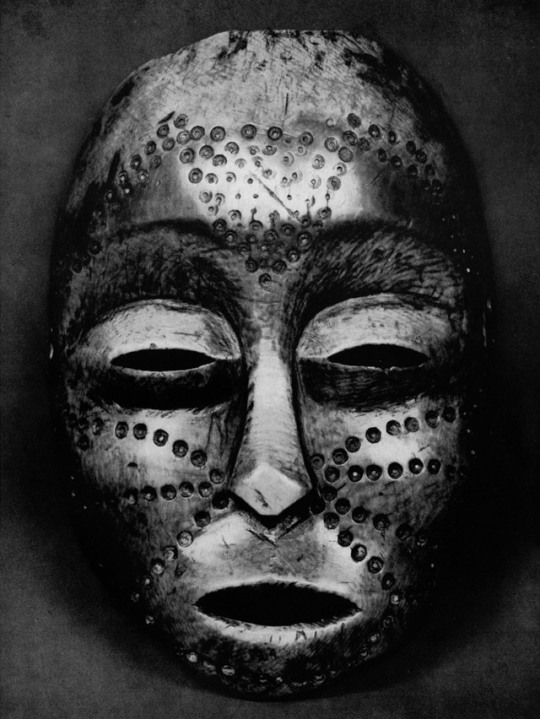
Comparative Religions
ATR (African Traditional Religion) Introduction Three religions dominates African continent: ATR, Islam and Christianity. African Traditional Religion has grown out of the African soil. It is not brought from outside. It is best distinguished as ATR. It is described as the product of thinking and experience of African forefathers and mothers of former generations. This religion is found in all African peoples. Africans who live according to their traditional ways are very religious. Africans have many different kinds of beliefs due to the fact that there are many ethnic groups and tribes in Africa. It is not proper to say there an African Traditional Religion. The truth is, every ethnic group has its own set of beliefs. The observation that is understandable is that there are many similarities between the traditional beliefs of Africans in Africa. Therefore we speak of African Traditional Religion thinking of those common things.
The African Traditional Religion has no founder. It evolved through many centuries, before the westerner come to Africa. Different fathers played a role in the development of this religion. It is not documented. It has no sacred book or Scripture. It is written in the hearts, history and experience of the people. It is passed with the word of mouth. It has never been accused of heresy, falsehood or deception. There are no religious controversies. There is no claim of purity. There is no authority to say what it was before or what it would be in the future. African Religion is open to new ideas. Some ideas of the past has been forgotten because people found them useless and did not carry them over to the next generation. It affects the whole person, the whole clan or tribe. Some writers use to say an African always carry his religion even to the parliament. It is taken everywhere around the world. The practice begins at early childhood until the last moment at death. A person must be born in a particular African people in order to be able to follow African Religion. The people from Europe, America, and Asia cannot be converted to African Religion as it is more removed from their geographical and cultural setting. African Traditional Religion is very pragmatic and apply to the need as it arises. It has supplied answers and direction to many African life, as such people are unwilling to abandon it quickly otherwise they feel insecure afterwards, unless something else give them additional or greater sense of security. It is said that even if they are converted to another religion like Christianity and Islam they do not completely abandon their traditional religion immediately. The religion remains with them for several generations and sometimes centuries. In reality the converted mix their traditional religion with the newly embraced religion. The idea behind is to gain from both religions.
African Traditional Religion influences every area of an African life. It shapes the character, and culture of the people. It is hard to destroy its beliefs. 2 Wrong ideas: African Religion is ancestor worship. This is just one part of it It is superstitious It is animism or paganism It is magic or fetishism African Religion embraces all these four ideas in its belief. Where to look for and find African Tradition Religion? • It is found in rituals, ceremonies and festivals of the people: Birth, giving of names, circumcision, initiation ceremonies, marriage, funerals, harvest festival, need for rain • It is found in shrines, sacred places and religious objects: Graves, caves, rocks, hills, mountains, tree, objects tied around people’s neck, legs and waists. Other objects are kept in pockets, bags or placed on gates or ground. • It is found in art and symbols: wood, stools, calabash, bones, sticks, pots, handcraft, domestic animals, and human bodies. It is represented by insects, birds, animals, trees, colours, etc. • It is found in music and dance: Drums, flute, rattle, etc. Religious festival are accompanied by songs and dance. Music is used to spread religious ideas. • It is found in proverbs, riddles and wise saying: There are proverbs that speak of God, human relationship, man, nature of things etc. Riddles are for entertainment but some contain religious ideas.
Wise saying are about the world in general. • It is found in names of people and places: African names have meaning that are also religious. • It is found in myth and legends: Stories, myth, legend, biographies • It is found in beliefs and customs: religious ideas, and that which people approve and do. Beliefs influences behaviour and what to do in life.
Five essential parts of African Religion a. Beliefs: God; Spirits; human life; magic; witchcraft; the hereafter b. Practices, Ceremonies and festivals: Praying, sacrifices, offering, rituals, customs, birth, harvest, raining seasons, dancing and singing c. Religious objects and places: Holy places, shrines, groves, hills, mountain, rivers, caves, amulets, charms, marks d. Values and morals: Truth, justice, love, right and wrong, respect, decency, agreements, promises, integrity, blame e. Religious officials: Priests, rain makers, ritual elders, diviners, medicine men, kings and rulers
Question: Conversion of Africans does not mean that they have abandoned ATR? How true is this? 3 Three types of heritage Historical heritage Cultural heritage Religious heritage Culture deals with things such as the way people live, behave, act, and their physical as well as their intellectual achievement. It is shown in art and literature, dance, music, drama, style of building and people’s clothing, in social organization, political system, in religion, ethics, morals, philosophy, in customs, and institution of the people in their values and laws and their economic life (John Mbiti, 1975:8)
Structure of African reality (Hierarchy of power) GOD SPIRITS (ANCESTORS) SPIRIT MANIFESTATION WORSHIP Ceremonial items: Home made brew; blood of a goat, chicken, sheep or cows Material used: For knowing the will of ancestors: bones, shells For healing: herbs, roots, and human body parts For power: beads, amulets, buffalo tail, fetishes PRACTIONERS Doctors: specializes in one disease or a general doctors Diviners: experts at unveiling the spiritual causes of disease Sorcerers: Claim power and contact with spirit and can cast spell KINGS AND CHIEFS PARENTS
4 Major Beliefs of African Traditional Religion THE SUPREME BEING All Africans generally believe in the Supreme being, called God Origin: No one knows how this belief originated. How did Africans come to know that there is God? People believed through reflecting on the universe (general revelation) People realized their limitations People observed the forces of nature The Supreme being has name or names. Almost every ethnic group has a name for this great God. What is the name of God used in your tribe or people? What personal pronoun and gender used to describe this God? The names reveals what people think about God. The names reveal His attributes What God is: God is spirit. He is not a human being. He is not visible, for one has ever seen Him. No one can surely describe Him. He is not made. He exists on His own. He has no father, mother, neither child. God is the creator of everything. He is the first cause, the original source. He sustains. He is all knowing and nothing is hidden from Him. He shares human images: He sees, hears, smells, tastes. He eats, sleeps, play, walk, rejoices, get angry, thinks, remembers. He is everywhere present like air. At the same time He is very far from the universe and His creature. God is unknowable. He cannot be explained. African turn to God when in trouble and seeking peace, happiness, and security. He does not do anything more for people. He does not interfere with man who is the centre. Man ignore Him and wait for the need to arise. Worship is to keep contact with the invisible world so that there is harmony. In this way prayers, sacrifices, offering are done and rituals performed. No human being can get near to God or talk to Him. He is the author of both good and evil. He causes people to sin. He is feared as a judge and full of wrath.
5 How different is this God with the God of the Bible whom Christian believe? Is this God the same with the Christian God? ATR versus Christianity • Deism (far from people) Omnipresent and Transcendent Psalm 139 • There is no personal contact Jesus is the way to God John 14:6 • Ancestors are mediators Jesus is the only mediator between God and man 1 Timothy 2:5 • No relationship with God Personal relationship through Jesus (Father) John 1:14, 3:16 • He is not interested with Creation Jesus is God incarnate, Emmanuel, who died John 1:14 • He is full of wrath and is a judge Wrath and love are His attributes John 3:36; Romans 1:18 • He does not communicate He speaks directly through His word Hebrews 1:1-2 • He is regarded as the fist ancestor God is eternal Psalm 90:2; Genesis 1:1 • No mention of His holiness God is holy and hates sin 1 Peter 1:16 • God is not concerned with sin Every sin is against a holy God Genesis 6:5; Romans 3:23; Psalm 51:5 THE SPIRITS There are two kinds of spirits: Human spirits: The spirits of those who were people on earth Those who died long ago and are forgotten Those who died recently and are remembered up to the 4th and 5th generation. They indwell people. They are used by diviners, mediums and medicine men. Nature spirits: The spirits that were created as spirits The spirits are found all over Africa. The animistic belief is embraced. Animism is s religious belief, which recognizes the spirits as indwelling every created things and controlling the physical world. Most world religions share the belief of animism, even though they would not call themselves animists. Animists or those who follow this belief, build their lives around the belief that nature spirits are powerful. The spirit world is stronger than humans. The nature spirits live in forests, trees, waterfalls, strange shaped rocks, caves, villages, hills, etc. Some of those spirits are believed to follow people as they move like the shadow. The spirit also indwell animals like, snakes (python), goats, bulls, tiger, giraffe, baboon, etc.
6 The spirits also manifests themselves in the form of these animals. They are easily recognized by the locals, thikoloshe, mamlambo, house snake, perennial or fountain snakes, etc. Different things are done to protect people from the spirits. The spirits are highly honoured and feared. Their help is sought for anything. ATR man can do nothing without consulting the spirits for permission or approval. In occasion like illness, marriage, childbirth, work, study, trip, poor harvest, accidents, family conflict, and war, spirits are consulted. Relationship between the spirits and the physical world is going on and requires human effort. Human effort is required to ensure the goodwill of the spirits and to ensure that they are not offended or neglected. Spirits want to be served and as such hold people in fear. Special methods are used for contact: Trained or gifted men are required to help Ecstatic trance is practiced just like the shaman Mediums, or divination, fortune telling Offering some rituals The local healers prescribe certain plants and herbs for use. We cannot deny the existence of spirits. They are around, but do not control the world and neither possess or indwell all created things. The spirit that we know, are created by God, and can only function as along as God permits them to function.
The Almighty God is the creator and sovereign ruler of heaven and earth (Hebrews 1:3, Colossians 1:16; Psalm 24:1; Psalm 50) Man should not seek protection or help from the spirits , but only from Jesus Christ because of His work on the cross. He defeated all evil angels and He also controls them. The knowledge of Jesus Christ through Salvation should liberate all Christian with African Traditional belief or Animism from the fear of spirits who indwell all created things. Christians must also know that their bodies are temples of the Holy Spirit, and therefore cannot be indwelt by evil spirit ( 1 Corinthians 3:16; 6:19-20; Romans 8:9-10; John 14:23). Christians can boldly and fearlessly evangelize all men without fear of being indwelt by a demon. There could be demonic attacks of different kind though, but remember the power of God and the one who is in you that He is greater than the one who is in the world. Who are the spirits according to the Bible? The Bible speaks of evil spirit, wicked spirit, unclean spirit, demons and Satan. These all were created holy by God but they chose to sin with Satan. God cast them out of heaven. Now they operate on earth in the sky above (Ephesians 6:10-17).
7 ANCESTOR SPIRITS (ANCESTOR WORSHIP) The main point of interest in African Traditional Religion is the belief and worship of ancestors. Ancestors are used as the mediators between the Supreme Being and man. It is known that not everyone who dies becomes an ancestor. He has to have had a position of authority He had to have adult sons or children depending on the tribe The spirits of those who died and come back to life are the ancestors These ancestors receive honour and worship as long as the tribe still remembers them. Only those who are remembered are worshipped. The names of the forefathers are sometimes forgotten and for fear of harm, when worshipping the priest or head of the family would announce the word even you whom we do not know. The dwelling place of the ancestors is not known. Some say in the caves, in the trees, grave, under the earth, in the high places (forests). The effective way to contact the ancestors is through sacrifices done either by the head of the family or the aunt. The items used are normally meat, blood of animal, or human blood or part, homemade beer, etc. The people do not know whether the ancestor will do them harm or good. Therefore, it is important to appease them or keep contact at all costs. Ancestors may cause sickness or difficulties in the family that would require the diviner or medium to deal with it. Generally, every time the diviners are called or consulted, the ancestors would say the people have done something wrong in the religion or custom. Africans worship the ancestors because that answers the deepest need of their relationship with those they know. What is the Christian response to ancestor’ spirits? First we must clarify that ancestor spirits are spirits of the departed forefathers and mothers. The spirits of people you know died. This is the general understanding of ancestor spirit. These spirits have gone to either Hades to wait for final judgement or to heaven in the presence of Jesus. Secondly ancestor spirits are what the Bible calls demons or evil spirits (1 Corinthians 10:18-22). These are the fallen angels who rebelled with Satan, the Devil in heaven and were cast out. They are waiting for their judgement and damnation (Matthew 8:28-32; 25:41). Their main function is to deceive men and encourage unbelievers to continue living in opposition and rebellion against God. These evil spirit (demons) impersonate the deceased and act as if they are the person.
8 Helping people who live in fear of ancestor spirit The unbelievers must be evangelized. They need the gospel. The message of the cross is the power of God to save those who believe (1 Corinthians 1:18; Romans 1:16; Acts 8:18-23; 13:8-11; 16:17- 18). • We should teach the people and inform that Adam the first man had no ancestor, and ancestor spirit (Genesis 2:5, 7; 1 Corinthians 15:44-47) • We should preach the cross (death of Jesus Christ: atonement, sin, forgiveness and purity). Emphasis must be made on Christ’s defeat of the supernatural beings (evil spirits including Satan):Colossians 2:14-15; Ephesians 4:8-10; Hebrews 2:14-15; Revelation 1:17-18; Matthew 12:22-30; 1 John 3:5, 8). • Christians need a lot of pastoral care and counselling. Inform Christians that issues such as death, sickness, poverty, impotency (barrenness) , demonic attack, unemployment, dreams, etc. lead to reversion to ATR. • We should teach Christians the sufficiency of Christ using Colossians and Hebrews. Encourage the people to read the gospels. • We should inform Christians that we are in spiritual warfare, therefore we need the whole armour of God (Ephesians 6:10-17). • It is important to build strong spiritual foundation by teaching the doctrine of sin (total depravity), the sovereignty of God in salvation, creation and redemption, angelology and the victory of Christ over supernatural evil spirits as well as eschatology (Revelation 12:9; 20:7, 11-20) • We should teach Christians to trust Jesus, His word and the finished work on the cross and the resurrection. Every believer should wholeheartedly believe God’s unfailing promises (1 John 4:4; Matthew 28:20; John 1:12-13) • We should encourage our people to receive medical attention where need be (James 5:14- 16; 1 Timothy 5:22-25)
DEATH AND LIFE AFTER DEATH Death is one of the most feared act in African environment. The origin of death is unknown. As such many myth were introduced. Death cam because the messengers failed to carry their given tasks. There is no myth on how death will be removed from the world. Death meant a separation of God from man. Causes of death Someone is often blamed for the death of a person • Sorcery, witchcraft, and evil magic • Spirits: the body was not properly laid or some taboos broken and that angered the spirits • Curse, breaking the taboos or oath • Natural death: It is sometimes acknowledged that God call old people to leave this life, but its rare. Even in this instances physical causes are attributed to somebody i.e. sicknesses, disease, old age, accident, lightning, earthquake, flood, drowning, animal attack, etc. 9 Rituals of death Disposal of the body requires certain ritual to be performed in preparation for disposal Burial of belonging with the body, some items are placed on the graveyard after burial. In other parts of Africa The belief is that the departed need weapons to defend himself along the way, food because he might be late for evening meal or need that on his way, other properties so that he may not arrive empty handed, etc, Funeral rites for different age groups: children, unmarried people, married, chiefs or kings, etc. The rites are intended to send the departed peacefully and to keep the link between the living for normal life. Feasting and sons of mourning: there are various signs and symbols to sho that there is death. Manual labour stops for a day or more. Shaving of the hair as sign of separation and new hair is sign of new life, smearing white, etc. Hereafter According to African Traditional Religion, there is no break between life and death. After death a proper funeral must be organized with necessary ceremonial rituals. This is done to prevent the dead person from wandering around. It is believed that if the dead person fail to get a place he wanders and becomes a ghost. Place of the departed. It is unknown. Different beliefs. Among those beliefs there is no one mentioning heaven or hell. • Neighbourhood of the homestead • Woods, forests, lakes, hills, rivers and riverbanks • There is a land of spirits in the underworld or underground • The dead goes to a place just similar to this world. It is another world. They do all that is done in this world. When a person dies his body is destroyed but his spirit lives on. The spirit receives s his body which is identical to his earthly body so that he can move around as spirit. A deceased is gathered to his forefathers, and it is finished with him. He is completely dead if no one remembers that ancestors. There is no hope of heaven or despair lf hell. Witches and sorcerer are not allowed in the spirit world (world of the dead) because they are cut off from the tribe. Some tribes feed witches and sorcerers with hyenas. Remembering of the ancestors Food and drink for the dead during festivals Consultation and rituals through the diviner or medium Naming the dead in prayer Naming children after the deceased 10 What is the destiny of man according to the Scripture? The Bible clearly teaches that there are two different places where spirits of a person goes after death. He goes to Hades if he is an unbeliever or heaven (Paradise) if he is a Christian: Luke 16:19- 31; 23:43; 2 Corinthians 12:2-4; Revelation 6:9 After the final judgement the unbelievers will be cast into the lake of fire (Gehenna): Matthew 25:41; Revelation 20:11-15 Christians will not be judge but enter into eternity with Christ the Sovereign Saviour and Lord (John 5:24; Revelation 21-22). There is no teaching on heaven and hell in ATR. As a result people live and die without hope and only fear of hell. They comfort themselves by saying they are going to their ancestors whom they have no idea where they are. In reality ATR has no definite answer as to where do the spirits go after death. They believe the spirit depart from the body and lives on. Some say they go to places like caves, forest, valleys, rivers, graves, or indwell people or animals, etc. Before the spirits get a permanent place they just wander all around the earth.
What is the doctrine of sin and salvation in ATR? Salvation is surely taught in the Bible. It is totally foreign and unknown in ATR. There is no teaching on inherent sin (Sin nature, total depravity, total corruption and human inability). There are expression and proverbs that are used to describe a depraved heart, wicked or evil heart. The doctrine of sin and the fall as taught in Genesis 3 is unknown in ATR. Adam and Eve are not found in their stories (myth). People in Africa do not basically sin against God, but rather they sin against the ancestors, against the members of the family or clan. Sin is evil acts to those whom one is related to. There is no sin of omission, but emphasis is on commission. An act becomes sin, more especially when the act is found or discovered. If not discovered it is fine. Issues like failure to take parental responsibilities, child abuse, and maltreatment of wives is not sinful in African Traditional beliefs. It might raised as a concern by some parents or families. ATR emphasizes that people should live in peace with one another especially those of the same family and clan. The truth of the matter is that there is no genuine peace outside Christ. Peace starts with out relationship with God through Jesus Christ. Then we have peace in our hearts, and peace with fellow men. And then continue to pursue peace and endeavour to live at peace with all men (Hebrews 12:14; Romans 12:18). The Bible says, “Sinners have no peace” (Isaiah 57:21). The word of God reveals that the heart of the problem is the heart. All evil acts and thought comes out of the heart (Mark 7:21-23; Jeremiah 17;9; Genesis 6:5; 8:20). ATR is mainly concerned with physical world full of spirits and the inhabitants thereof. As such the problem Africans Religion face is physical: illness, drought, barrenness, poverty, conflicts, death, marriage, etc. Therefore deliverance is from all these misfortunes. One is then delivered or saved from demonic attack, evil spirits attack, or witchcraft, etc. The practice of deliverance is either offering a sacrifice or receiving protection from a diviner or a religious man (priest or prophet). our 11 A person is also saved from sickness, troubles or bad luck / misfortune or curse. These are done through prayers, laying on of hands, getting some items or obeying the instruction of the diviner or religious figure head. Salvation is also from witchcraft (Sorcery) and other enemies. This needs some items or object to keep at home or carry on your body. The effect of being saved or delivered is seen through the physical health, calm situation or prosperity enjoyed by the family through a member who gets a well paying job or accumulate a lump some of money. To those who mixed ATR with Christianity or biblical practices, salvation is though baptism or being a member of the church, etc. The question we should ask our ATR followers is: What are you saved from? And Who saved you? Romans 3:23; 5:12-14, 18:21; 6:23; Matthew 1:21; John 16:8-11 MAGIC AND TABOO Africans believe that everything has life force, which cause good thing or evil. The force is found in arm bangles, special words uttered, African medicine, etc.
Diviners (witchdoctors) are considered the ones having more power in ATR. Magic This form part of the African Religion or belief. There two kinds of magic: White Magic Black magic White Magic: This magic is used for good reason Traditional healers or medicine man use it. They try to find the source of evil, whether it is a sorcerer or a taboo. When the evil is discovered, the medicine man or healer gives the afflicted protection against his enemy. He may use bangles, powder, tattoo markings, leather necklaces, etc. Some of those items received from the medicine man or healer are believed to bring happiness, harmony and prosperity. Black Magic: This magic is used for bad reason or purpose People use this to harm someone. Those who use this magic are called sorcerer or wizards who practice witchcraft. Africans believe that witches must be destroyed. More often people who are disliked by the community are associated with witchcraft and are called witches. This leads to suffering, expulsion from the community or death. People are warned to take care of things such as hair, nails, clothes hanging outside at night, using certain words or phrases, visiting certain places, eating food from certain families, receiving gifts from certain people, etc. The witches or sorcerer are believed to have power to pick the ground where one has tread and cause cancer or something evil.
12 Taboo Defined: prohibition imposed by social custom, isolation of something as sacred or accursed. Words or speech, items or clothes, conduct, food, places What is the Christian answer to white magic, black magic and taboos? Magic is sinful and associated with activity of Satan. It does not matter whether it is white or black magic. Old Testament forbids the practice as sinful, as well as those who use magic as means of getting help as involved in sin. Leviticus 19:31: mediums and familiar spirits defile the seeker Leviticus 20:6 Deuteronomy 18:10-12 Isaiah 8:19-20 Groups who practiced magic Egyptian magician and wise men: Exodus 7:11, 22; 8:7, 181-19 Babylonian magicians: Daniel 2:2, 10-11 The New Testament addresses magic as sinful (Members of the flesh) Galatians 5:19-20 sorcery Revelation 21:8 Revelation 22:15 Individuals and groups who practiced magic Acts 8:9-11 Simon Magus Acts 13:8-11 Elymas Acts 19:19 Magicians The Bible speaks of miracles wrought by human agents in the name of Jesus, not magic. All man-made rules are set to instil fear in the hearts of children and other people. Taboos are key elements used to keep the people in bondage. Taboos are not vows or oaths, but certain words forbidden to be uttered as it is believed that they would bring harm or disturbance in a person or family. The English word for that is “Spell” (Deuteronomy 10:10-12). There are also practices forbidden and even places not to be visited, and even food not to be eaten (1 Corinthians 8:4-13). Taboos includes the prohibition to do certain things or sit at a particular places. We are delivered from all fear of magic and taboos. We are forbidden to practice them or encourage people to do them (Colossians 2:22). We do believe that no man has power to inflict harm or cause damage through or by his words from a distance, unless there is demonic connection.
13 THE CREATION OF MAN AND THE BEGINNING OF THE WORLD There are so many myths about the creation of man and beginning of the world. Almost every tribe or people in Africa has its own story. Majority believe that God created the universe. Others say someone great created the world. Evolution is a concept foreign to African Traditional Religion. There is no clear evidence how the creation took place. Africans has no slightest thought that the universe will come to an end. Man is said to have come from the clay, from marsh, from a hole, from the leg of god, he was brought from the sky to earth. It is thought that at first man was living in harmony and immortality and in fellowship with the Supreme Being (God). Man is the centre of the universe. At that time heaven was very close to earth, and that a rope tied them up. Later on God went away from man because of sin. He went away not to be interested in him forever. There are many reasons given coming from different tribes, as to why God left. God was tired of man’s requests Man wiped his dirty fingers on the sky A woman pounding in her mortar lifted her pestle too high and kept poking God in the eye, and God decided to go up higher. Smoke get into God’s eye, when man set the grass on fire. The hyena broke the rope joining heaven and earth. There is a sense of disobedience on the part of man in all the myths. Consequences Man lost his immortality This came about because God’s messenger was too slow to bring the message to man that he would die. Others say that the hyena was sent with the message that man would die and reach man first. A great division or separation existed which cannot be mended by anyone. What is the biblical doctrine of creation and separation? There are many stories about creation of man in Africa. There are also many myths about the separation of God and man. The Bible teaches that God created man from the dust and gave him the breath of life (Genesis 2:7). Man was created good and righteous according to the likeness of God (Genesis 1:26-28). The Bible teaches that man separated himself from God because of disobedience (Sin): Romans 5:12; Genesis 2:15-17; 3:1-16, 22-24. God did not go away from man, but man ran away and hid himself from the presence of God. God showed great interest in man. He also showed His care and love. He sought the man, found him and asked him what happened, disciplined him and reminded him of the consequences of sin (Genesis 3:7-9, 10-24). More than that He promised a deliverer who will come on behalf of man to deal with man’s problem and enemy (Genesis 3:15). 14 God spoke directly with Adam and Eve. He clothed them (Genesis 3:21). Then he banished (sends them out of His garden. Man is born an enemy of God. He sees God as unjust and unapproachable. Man created his own way of appeasing God and worship (Isaiah 53:6; 59:1-2). ATR introduced ancestral worship. All that was rebellion and sinning. Because of the separation there was no relationship between man and God. Man opted to follow the devil and his demons (John 8:44) Jesus, the deliverer, Son of God came to reconcile man to God through the cross (2 Corinthians 5:18- 20; Romans 5:20; John 3:16; 1 Timothy 2:5).
The weaknesses of ATR • There is no Jesus Christ. There is no Grace and Faith in Christ • There is no special revelation of God through the Scripture. Due to the fact that it is not documented anywhere, it is open to changes and can also be in different form in other ethnic group. • There is no teaching on total depravity and repentance. But there is promotion and encouragement of sin and sinful activities. • God is not concerned about the sin of the people. There is no final judgement (Hell) • There is no hope of the future. Heaven and eternity with God is foreign to an African rooted in ATR. • Salvation is only physical and not spiritual • The mediator of Africans are both saved and unsaved ancestors • This religion promotes fear in the lives of the people • Since then, they have not found the remedy for death. • There are endless sacrifices offered without intended result. The ancestors demand things from the people without providing for them. • It is ethnic and cultural. It depends on specific tradition and culture. • There is no absolute standard of morality (lying, adultery, polygamy, greed, incest, etc.) • It emphasizes nature worship, worship of man and spirits. • Most of its ritual practices are done at night • It claim special revelation in the form of dreams and visions • It is a family, communal religion Why ATR should be rejected? ! It has no inspired Word of God. It contradict the Bible in its understanding of the mediator. ! It does not provide salvation of the soul by grace through in faith in Christ ! It does not have a Saviour ! It does not clarify the purpose of life
15 Questions ! Why is ATR still exerting much influence on African people despite many years of intensive missionary work and evangelism? People are sinners from birth. Poor evangelism (pragmatic methods). African Theology encourages appropriation of it. Syncretistic practices in the church. Traditional leaders promote it. Africans do not want to loose what their forefathers established. There is a need of identity. ! Why do those who convert to Christianity return in certain moment of their lives to some aspects of ATR? Lack of discipleship and counselling. Immaturity and bad advice. Parental authority. Profession of faith without genuine conversion. ! What are things that sustain ATR in Africa? Fear: ancestral spirit, witchcraft, taboos, death ! What is the future of ATR? Unsaved Africans start practising ATR at an early age. The traditional leaders hold strongly to ATR. The government leaders (State presidents) are followers of ATR and promote it. Practical questions (Kurios and Morena) • The home of your friend has been struck by lightning twice and one of the children has died already. Your friend asks you what can he do about the problem. What do you advice? • A Christian woman is plagued by disease all the time. Her grandmother who is a traditional healer tells her she should go and be trained to become a traditional healer herself. What should she do? • You have a baby that cries a lot during the night. Other people tell you this problem has something to do with the ancestors spirits. You should probably change the name of the child. What are going to do? • New people have moved in and become your neighbours. Since they move in one of your children has become ill and you yourself have lost your job. People say these people are practicing sorcery on you. What are going to do? • Should the church allow church members to consult ancestors?` • If a church member consult a diviner because of some serious problem, should he or she be disciplined?
82 notes
·
View notes
Text
Only a day or two ago I was notified that I was in contact with some people tested for and found positive for Covid-19, this came as nothing un expected, I was in contact with hundreds of people many from Europe recently. Then, as you know we are experiencing, most Universities, Libraries and Book Shows have been indefinitely closed, and because of this; many of us find or try lively-hood’s challenged. In a situation where it seems that there is little to do that will improve the current situation any faster than time will take its course, I have turned to reading and writing. I have been researching, as best as I can from home, fifteen books which are new to my stock. There are many more stuck in Europe and this gives me hope. It is the first day of spring and I awoke to a beautiful snow squall… In like a Lion..
And here are the fruits…
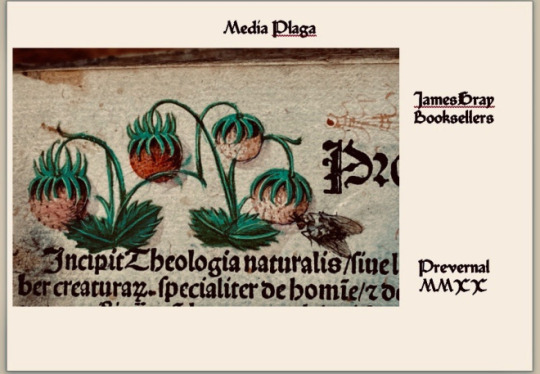
1). 355J Bible Saint Jerome, Gabriello Bruno (active 1480-1514.)
Biblia cum summariis concordantiis : diuisionibus: quattuor repertoriis p[ro]positis: numeriq[ue] foliorum distinctione: terse et fidelit[er] imp[re]ssa. { With table of Gabriel Brunus }
[Lyons]: Jean Pivard, 29 Jan. 1500 & 1. $ 15,000.
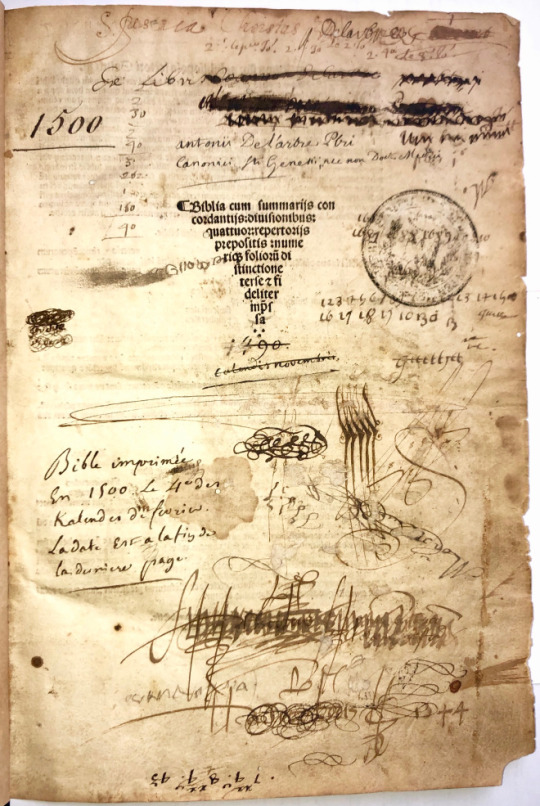
Impresserunt aute[m] solertes viri Franciscus Fradin et Ioha[n]nes Piuard socij impressores. …,]
Folio inches, &8 ç8 , a8 b6, c-z8 A-Z8 Aa8 Bb8; aa-cc8 dd10. Bound in original full calf over wooden boards with 10 brass bosses.
This edition corresponds with the edition printed by Fradin and Pivard in 1497. There are the same tables, summaries, &c.; and the arrangement of the books and the readings are alike. At the end of the subscription we read: “Impressit autem solers ori Johänes Pivard impressor. Deo sint sempiterne gratie.”
Pivard,who was working alone from 7 March 1498 to 1501, Started printing with François Fradin in 1497 (Goff B602) ISTC lists15 titles solely printed by Privard.
Goff B604; HC 3128; GfT 1883, 1884; Pell 2341; CIBN B-426; Arnoult 288; Girard 108; Parguez 213; Polain(B) 4210; IBE 1040; SI 764; Martín Abad B-134; Sallander 2098; Bod-inc B-312; Sheppard 6736; Pr 8670; GW 4281. (Gutenberg-Jahrbuch 1965 p140-3)

Copinger, Incunabula Biblica, 120; Darlow–Moule 6090; Sheppard 6736.
U.S. copies: Boston Public Library, General Theological Seminary, Jewish Theological Seminary of America, Library of Congress, Rare Book Division, Southern Methodist Univ., Bridwell Library (418 ff)

https://data.cerl.org/istc/ib00604000
◊
◊ ◊
◊
2) 353J Alberto da Castello (ca. 1460-1522)
Rosario della gloriosa Vergine Maria : con lle sttattiionii & iindullgenttiie delllle chiiese di Roma perr tutto L’’anno.
In Venetia : Presso la compagnia de gli Vniti,1585. $7,800

Octavo. 6 x 3 3/4. A-Z, Aa-Ii8. A later edition of the first ‘Rosary Book” in Italian.
This book has a wonderful contemporary binding, recently expertly rebacked. It is of red Morocco with gilt center images and borders gilt, with angels. Certainly these books were

very popular, that said, very few copies have survived. This edition is represented on OCLC by only two copies worldwide. 1 US copy Saint Benedict/Saint John’s University. (SJU Alcuin Arca Artium Rare BookBX2163 .C37 1585). [The authorship of the work and the woodcuts are attributable to the Dominican Friar Alberto da Castello, identified as author or editor at the authorizations of the Venecian Inquisition, given 5 April 1521. (Francesco Pisano)]
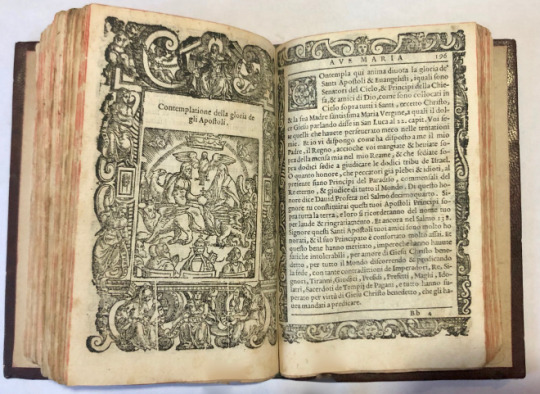
Over 150 woodcuts (including repeats) comprising almost full-page cuts (1 on t.p.) within borders. All had previously appeared in earlier editions. Ornamental and pictorial border pieces on almost every leaf. ( The wood cut on leaf 173v is upside down in the border!) Each wood cuts represent the “Mysteries of the Rosary”
“From the beginning, publications on the Rosary came accompanied by lavish xilographic illustrations. The most striking of these can be found in the edition of the Rosario della gloriosa Vergine Maria by Alberto da Castello from 1521 [Fig. 14.1], which contains a wealth of illustrations. This clearly shows that the Rosary was not just an oral recitation, but was also a contemplative prayer engaging the imagination, a combination later mirrored by the exercises of Ignatius of Loyola.
Alberto da Castello, born in the middle of the fifteenth century in Venice, joined the Dominican order around 1470 and wrote several devotional, liturgical, historical and canonical texts. In the Epistola prohemiale of his Rosario della gloriosa Vergine Maria he says that he wrote the meditations and organised the images ‘acciò che gli idioti che non sanno legere habbino el modo de contemplare gli divini beneficii et de questa contemplatione ne habbino qualche frutto spirituale’.( fol. 6r. ‘So that even the illiterate have a means to contemplate gifts of the divine and to receive spiritual fruits from such contemplation’ (translations are mine).He states that he writes especially for the ‘ignoranti, illetterati, idioti’, and that a good Christian must hold the mysteries of the Rosary deep in his heart. (Literary and Visual Forms of a Domestic Devotion: The Rosary in Renaissance Italy. Erminia Ardissino)

The mysteries of the rosary were introduced by Dominic of Prussia sometime between 1410 and 1439. This gave each decade of the rosary a unique quality. Each mystery leads us to ponder very specific events in the lives of Jesus and Mary and the lessons they hold for our own lives today.
The Rosary has a ritual aspect that individual prayers lack, and it is highly structured. It entails the recitation of 150 Ave Marias, clustered in groups of ten, preceded by a Pater noster and the proposition of a ‘mystery’ upon which to meditate. This number of 150
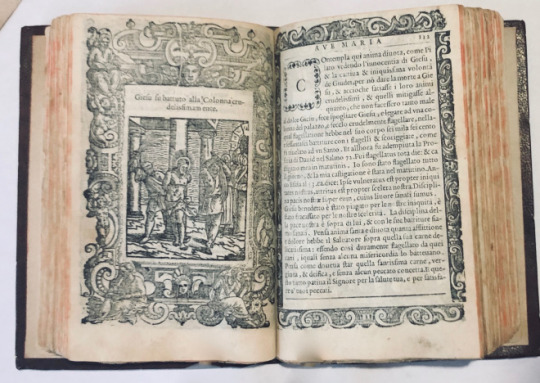
Ave Marias seems to be designed to correspond to the 150 psalms in the Davidic psalter, which is why the Rosary is also known as the ‘Virgin’s psalter’. It does not consist only of repetitive prayers, however, but also entails meditations. Indeed, the Rosary created by Dominic of Prussia was a kind of meditation on the life of Christ and Mary. In his Liber experientiarum he ‘explicitly claimed to be the first to have composed a series of fifty points on the life of Christ that were to be meditated on while reciting the Ave Marias’.
Sander 6572-6573. See: Essling 2124
)0(
100 full page plates and a volvelle!
3) 382J Jan David. 1545?-1613.
Veridicus christianus: auctore P. Joanne David … Editio altera, auctior.
Antverpiæ ex officina Plantiniana, M. DCVI. $6,500
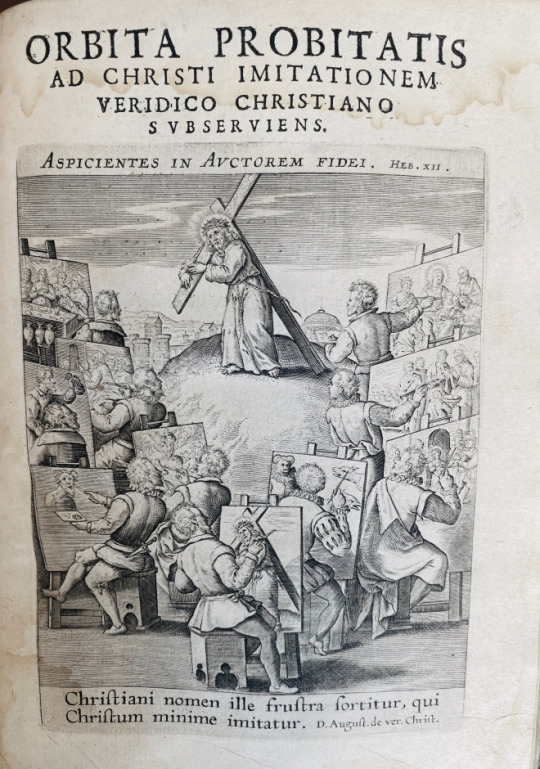
Quarto 8 1/2 X 6 inches ‡4, ‡‡4, A-Z4, a-z4, Aa-Ee4.+ 100 Numbered Plates. Withspecial engraved t.p. with allegorical depiction of Christ carrying the cross, surrounded by ten artists at easels painting scenes from his life (as well as a few questionable profane subjects).
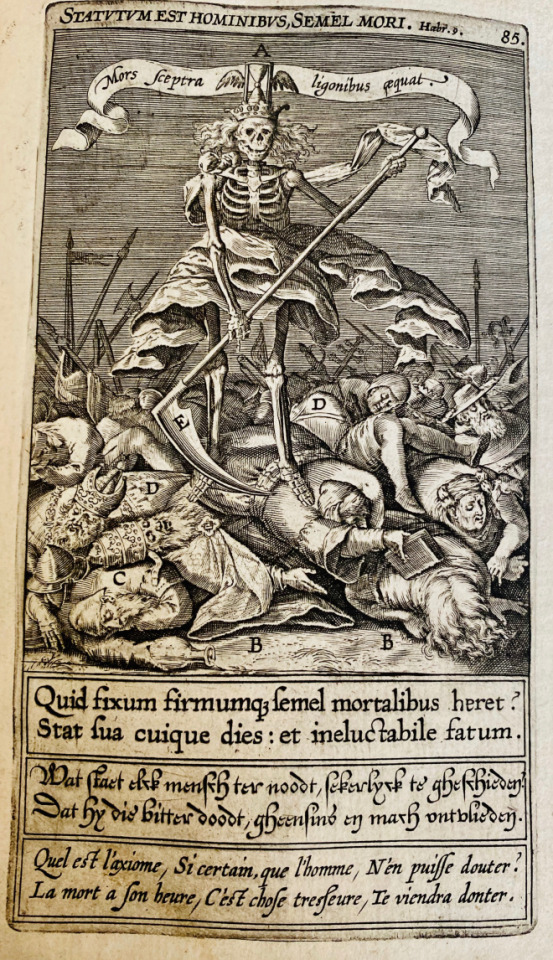
The text is divided into 100 chapters, each with an allegorical engraving incorporating letters keyed to the explanatory text and with marginal references. Each of the 100 numbered plates has a single line of Latin at the head giving the subject, with two-line explanatory verses below the allegorical engraving in Latin (roman letter), Dutch (civilité) and French (italic) First plate (following [2 daggers]4) is added title leaf for the ill., which were also published separately; see Bibliotheca Belgica. The added title reads: Icones ad Veridicvm Christianvm P. Ioannis David e Societate Iesv At the end is Device with compasses and the motto “constantia et labore” on Ee4r . This book is notoriously found defective in one way or another, this copy is perfect and complete.
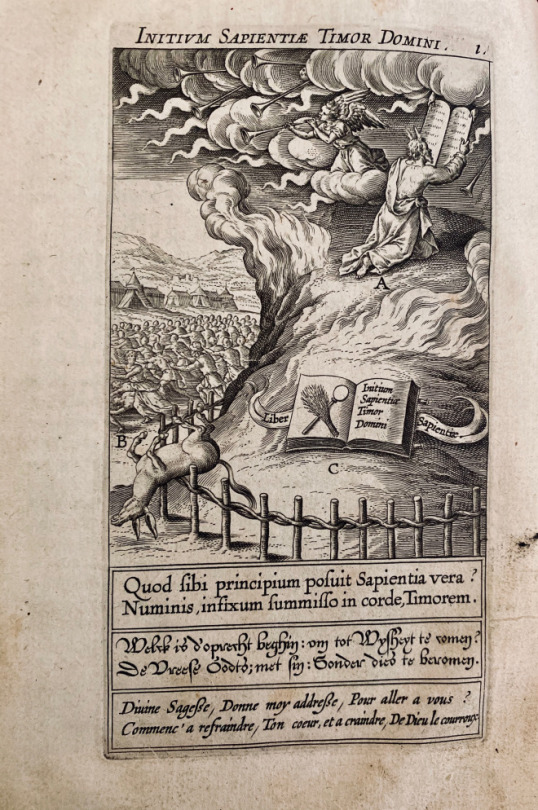
This copy is bound in full contemporary blind stamped calf over wooden boards with two working clasps.
The Veridicus christianus: is followed by the “Orbita probitatis ad Christi imitationem veridico Christano subserviens”: p. 351-374; which preceds a volvelle plate for use in locating specific passages.
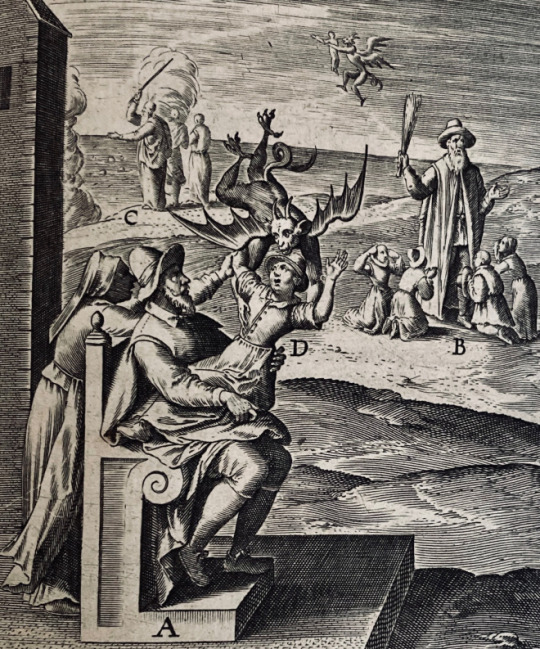
This text contains a series of images with accessible (sometimes to a fault) moral or religious messages. These illustration swarns against opening the senses to temptation lest death and moral decay take up residence in one’s soul.
The Veridicus Christianus emphasizes the Society of Jesus’ investment in thinking in, though, and about visual images that exemplify the supreme mystery of God. Published as a tool of devotion and meditations, it features one hundred chapters that encompass a wide range of topics for reflection. Each chapter incorporates an extensive commentary that interprets the emblematic image David too follows the order in which we apprehend things with our senses, beginning with a visual representation at the head of each chapter. Then comes the explication. The symboli explicatio was considered necessary because cultivated readers would be more susceptible to a reasoned argument than a picture.
Here are images of the vovell. The centers of the engraving and the volvelle (through which a string passes) are reinforced with small paper roundels printed with the monograms of Christ. The numbers are keyed to an “Indiculus orbitae” that follows (Bb1r-Bb2r). There a number, having been selected, is provided with a phrase from various Latin authors (listed on Bb2v), and a reference to one of the hundred sections that comprise the main text. It is suggested in Bibliotheca Belgica that this game may have been intended as a pious alternative to such superstitious books as Thuys der fortvnen.
)0(
4) 312J. Domenico Cavalca. (1270?-1342)
Pungi lingua
[Baptista de Tortis]: Venexia, Adi .viiii. de Octubrio. 1494 $12,000
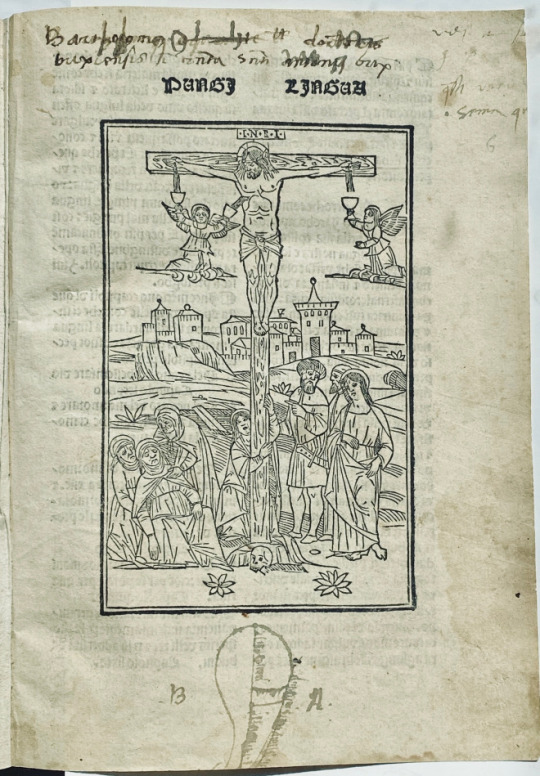
Quarto (200 x 145 mm); [80] pages. a-k8. Large woodcut depicting the crucifixion on the frontispiece, First Venetian edition with the beautiful woodblock published here for the first time. This copy has a beautiful initial “A” in gold, blue, red and green, a colorful coat of arms. This copy is bound in modern carta rustic with a gold title on an orange label

This is a treatise on the dangers of the misuse of the language it was, as you might expect quite popular . Written by the Dominican monk who was a contemporary of Dante and among the first to write in the vernacular, and one of the most successful translators of holy texts.
Aside from Biblical illustrations, the Pungilingua has many exempla drawn from many other sources including some not includes in the Alphabetum narratinum. Most of the stories are told in one to three lines, and many contain commerce with the Devil, one time disguised as a horse. In the prologue Cavalca mentions that he gathered his exempla from many sources “alcune poche cose” . One of the major sources is the Summa Vitiorum by Peraldus. but he also quite a few profane authors , Seneca, Socrates, Cicero, Valerius Maximus. That said, quite often Cavalca attributes the wrong author. Cavalca writes as though he was speaking to the reader in person useing phrases like “Io per me credo” and “Oimé “ Introducing unique stories and words, He refers to someone as double-tongued as a “tecomeco” (bilingue) . He refers to a sleight of hand trick ,called “gherminella” a word which was used later by Boccaccio. This is an important book in Italian literary history, and the Italian vocabulary leaving many contemporary proverbs and descriptions of medieval life. Goff C342; H(Add)C 4776a; R 116; Pell 3448; CIBN C-195; IGI 2637; Essling 750; Sander 1853; Pr 4649; BMC V 328; GW 6413
One copy in Goff. Huntington Library.
Queried Location: New York NY, Manhattan College: sold Christie’s (NY) 1 June 1991 lot 41 (current whereabouts unknown)

***
***
5) 350J. Richard FitzRalph (Ricardus Radulphus Armacanus pseudonym) (circa 1300-1360)
Summa Domini Armacani in Questionibus Armenorum noviter impressa et Correcta a magistro nostro Johanne Sudoris. Cum aliquibus Sermonibus eiusdem de Christi dominio.
Paris: Jehan Petit et ponset le Preux, (Venales habentur in vico divi Jacobi sub Lilio aureo) 1512. [Privilège octroyé à Jean Petit et Poncet Le Preux daté du 12 mars 1511 (1512 n. st.) et prenant effet le 15 juillet 1512.]. $24,000
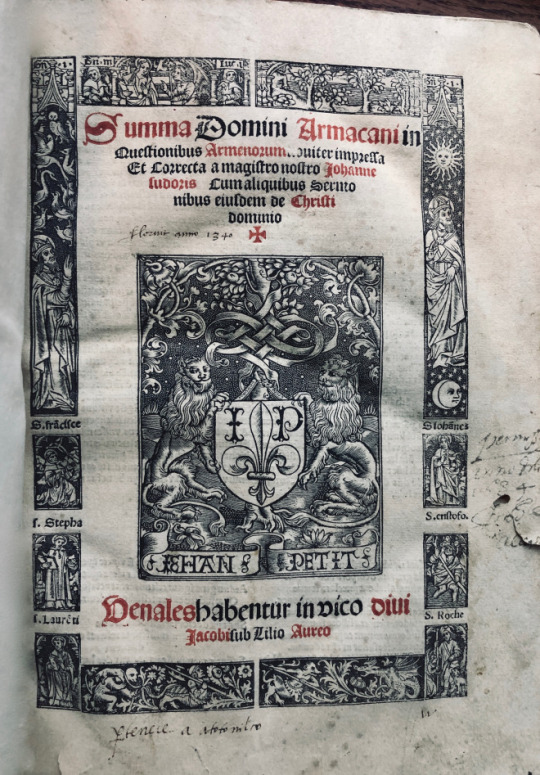
Small Folio 275 x 201 mm. A6 a-z6 &6 A-E6 F4. [6], 177 [i. e., 178] leaves. This copy is bound in a Remboîtage of later limp vellum; contents toned and brittle, lightly damp wrinkled with marginal damp staining at beginning and end, contemporary inscriptions on title and scattered underscoring and marginalia, wormhole through blank outer margin of approximately the first 30 leaves, paper crack in o1 not affecting text, last leaf reinforced in outer margin on verso. A Mexican Augustinian branded ownership mark on bottom edge. This is the only printed edition of the Summa in Questionibus Armenorum which is an examination of alleged Armenian doctrinal errors, the chief dogmatic work by an Irish theologian and prelate involved in negotiations between the papal court at Avignon and Armenian representatives over the reconciliation of the Roman and Armenian churches. FitzRalph, whose Defensorium curatorum was first published circa 1483, was one of the earliest Irish authors to appear in print. Renouard-Moreau II, 314; Shaaber M119; not in RBH or ABPC. Moreau, B. Inventaire 1512- 314; Index des livres interdits, t. IX, p. 86 (n° 50/499; Page de titre en rouge et noir dans un encadrement de plaques gravées sur métal, marque de Jean Petit (Renouard, 890) Adams, F-550
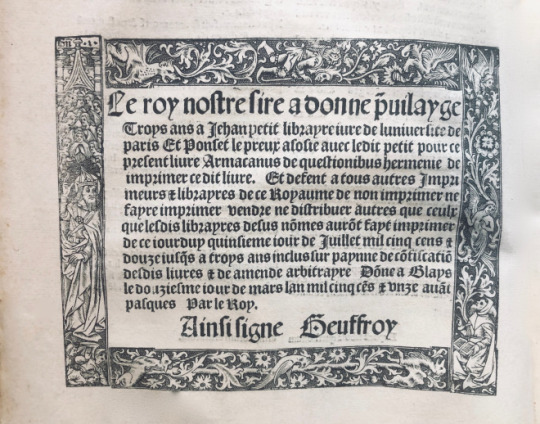
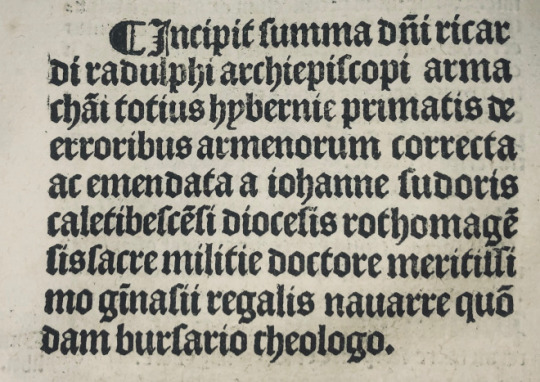
><><><><><
6) 358J Jacobus de Gruytrode 1400-1475
Speculum animae peccatricis
[Memmingen : Albrecht Kunne, about 1490] $6,500

Quarto , [28] ff, 33 lines, the first initial (5 lines) is painted in white and blue on a golden background, upper and left margin richly decorated in red, purple, blue and gold and with two red beasts. 19th c. binding in half leather, title gilt on spine, all edges gilt. Sometimes falsely attributed to Dionysius Carthusiensis, the Speculum is now attributed either to Jacobus de Gruytrode (cf. Bloomfield) or to Jacobus de Clusa (cf. L. Meier, Die Werke des Erfurter Karthäusers Jakob von Jüterbog, Münster, 1955).

Speculum animae peccatricis is a work of spiritual edification which consists of seven sections: on human misery, sin (especially lechery), penance, rejection of the world, the vanity of human wishes, death and hell and heaven.
Firste of the filthenes and miserie of man. Below are the chapter in English
Secounde of the synnes ingeneralle and of their effectis.
Thyrde howe they ought hastely with all diligence to do penaunce.
Fourth howe they ought to fle the world.
Fyfthe of the false Riches and vayne ho∣noures of the worlde.
Sixt howe they ought to drede deth.
Seuenth of the Ioyes of paradyse and of the paynes of hell.
There is no modern critical edition of the text. Among the devotional books by the Flemish mystical writers of the fourteenth and fifteenth centuries, none was more popular on the Continent and in England during the early Renaissance than the Speculum aureum animae peccatricis or The mirroure of golde for the synfull soule, which Lady Margaret Beaufort translated into English. Since the sixteenth century, bibliographers have listed the Speculum as the work of the Carthusian monk Jacobus de Gruytroede, prior of the Liége Charterhouse from 1440 to 1475, yet the English version is always attributed to his friend Denis de Leuwis or Dionysius the Carthusian, as he is better known. The question of authorship may be satisfactorily settled as the result of recent research by an English Carthusian scholar in the library of the Certosa in Farneta. He noted that the editors of Dionysius’s Opera omnia (Tournai, 1913) explain how the error in authorship began. In volume xlii they point out that, owing to the Carthusian tradition of anonymity during a monk’s lifetime, the Speculum was printed anonymously until 1495, in which year the Nuremberg printer Paul Wagner first issued it as a work by Dionysius. He found the manuscript of the Speculum in the library at Ruremond, where Dionysius was prior until his death in 1471, and supposed it was written by him, as were the other works he intended to print. The two priors were close friends, and dedicated several of their works to each other. Nugent E.M. (1969) Jacobus de Gruytroede. In: Nugent E.M. (eds) The Thought & Culture of the English Renaissance. Springer, Dordrecht
Goff S644; HC 14899*; Pell 4313; CIBN S-333; IGI 5001; IDL 2532; Schlechter-Ries 1003; Voull(B) 1617,5; Schmitt I 1614,2; Hubay(Augsburg) 1141; Hubay(Eichstätt) 538; Sack(Freiburg) 1951; Walsh 988; Bod-inc S-258; Sheppard 2032; Pr 2804; BMC II 608; BSB-Ink I-23; GW M10734
U.S. copies;Harvard ,Emory, Columbia ,Huntington Library
Southern Methodist Univ, Univ. of Illinois at Urbana-Champaign Library
)0(
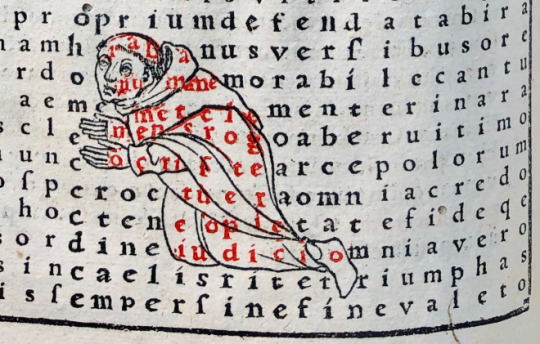
Nam digiti scripto laetantur, lumina visu Mens volvet sensu mystica verba Dei
“The fingers rejoice in writing, the eyes in seeing, and the mind at examining the meaning of God’s mystical words.”
The first printed facsimile of a manuscript.
7) 351J. Hrabanus Maurus. 784-856?
Magnencij Rabani Mauri De Laudib[us] sancte Crucis opus. erudicione versu prosaq[ue] mirificum.
Phorçheim. [Pforzheim] : In ædibus Thom[ae] Anshelmi., 1503. $10,700
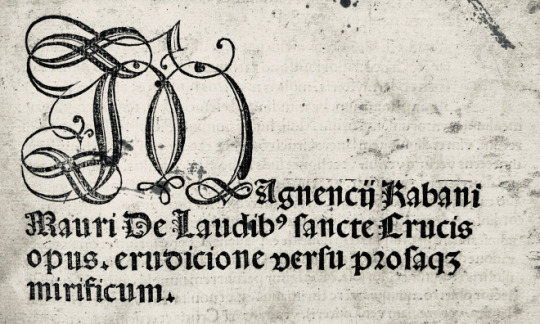
Folio Aa6, Bb4, a-k6, A-B6, C4 (last leaf blank).
THIS COPY LACKING [four leaves] A5 & 6, Bb1 and a1. [two woodcuts of Alcuin interceding on behalf of Rabanus before Pope Gregory iv, and of Rabanus presenting his poems to the Pope; and two figured dedicatory poems the first to Louis the Pious the next christ crucified] It is bound in a full vellum modern binding. First Edition (for a second edition see below) Types 3:109R, 4:180G; 40 lines of transcribed verse + headline, 40 lines of commentary + headline, red and black printing throughout, calligraphic woodcut initial (Proctor, fig. 24) M on title page, woodcut initials printed in red, and a figured prefatory poem, 28 carmina figurata, the first entirely xylographic, the remaining poems combining printed and xylographic letters with the versus intexti printed in red (except fig. xvi), enclosed by either woodcut figures (of the emperor, Christ, the Evangelists, Cherubim, etc.) printed in black or by Christian symbols and characters, most defined by metal rules in red.
This is a remarkable typographical achievement, probably the earliest attempt to reproduce a medieval manuscript. The greater portion of the work comprises a preface in verse and twenty-eight poems. “Hrabanus Maurus, the abbot of Fulda, wrote in the midst of the ‘new monasticism,’ a period associated with a revival of literacy and learning. In religious and secular spheres. This ‘script culture,’ as Rosamond McKitterick has it, used the written word not only as a mode of communication but as ‘a resource, a guide, a key, and an inspiration,’ especially in the devotional practice of Christianity.
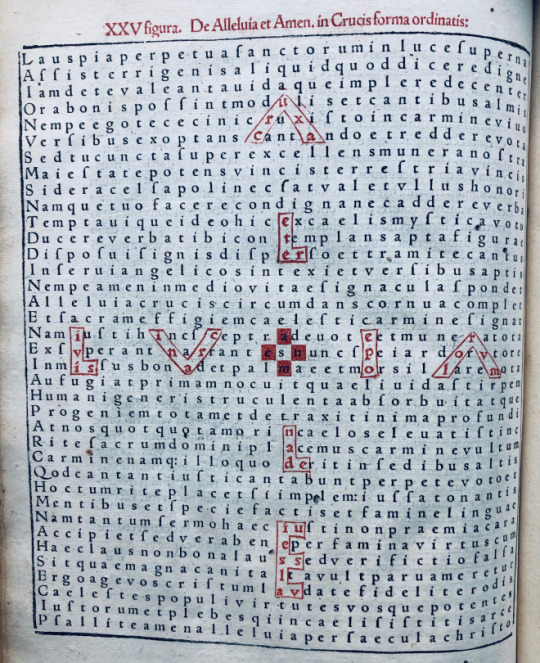
Each of the twenty-eight picture poems that form In honorem sanctae crucis explores a different theme relating to the Cross through a complex interplay of word and image. The poems each have an equal number of letters per line, written continuously like a grid. By following the letters in the usual direction for a Latin text—from left to right, top to bottom—each grid reads as one long poem. But within each grid, certain letters are also marked out with colour and drawings to form pictures. The letters that make up these pictures read as separate short poems embedded within the larger poem. As such, each page of In honorem sanctae crucis presents not just a puzzle of words and pictures, full of hidden and interrelated messages for the reader to decode bout a meditation exercise.
“Hrabanus created the various shapes and figures by highlighting individual letters in underlying poens in colour (in the printed editions red), and theses individual letters together make up meaningful text , ranging from simple declarations to very elaborate ones. For example, Carmina 2 contains a simple cross inside a square (Hrabanus calls it a “tetragonum”)whose sides form a border for the poem as a whole. The textfrom the underlying poen that makes up the figure consists of six hexameters, each one an address to the cross beginning with the words ‘O crux…’ When we follow Hrabanus’s instruction in the accompanying prose text for reading these hexameters, we find the following: even though the verse that forms the top of the square is also the opening of the underlying poem, he insists that we begin reading with the stem of the cross, from top to bottom.” (Schipper)
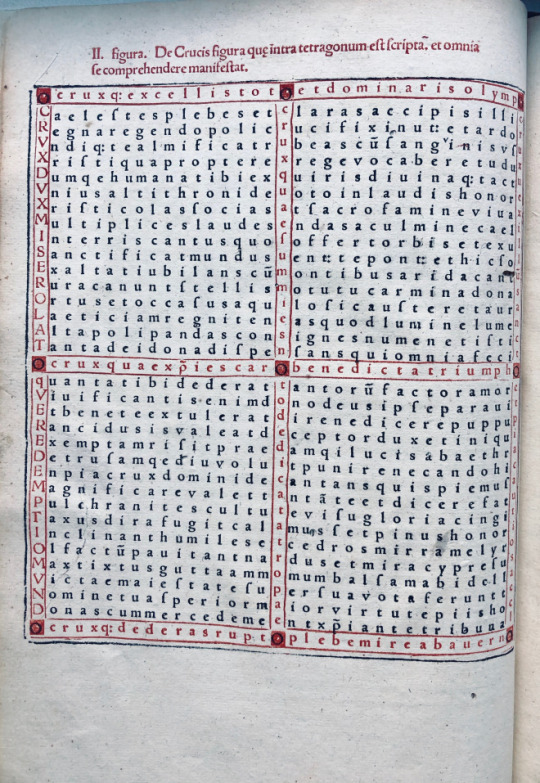
Sunt quoque uersus duo in ipsa ccruceconscripti, quorum prior est: O CRVX QVAE SVMMI ES NOTO DEDICATA TROPAEO
a summo in ima descendens. Alter uero: O CRVX QVAE CHRISTI ES CARO BENEDICTA TRIVMPHO a dextra in sinistram crucis tendens ‡
‡“there are also two verses inscribed in the cross, the first of which is : “ O cross , thou who art at the height of fame, a dedicated moment” ‘running from the top down. And a second’ “O Cross thou who through the body of Christ art the blessed triumph” ‘running from the right to the left.’
Further more Hrabanus flips left and right the texts point of view alternates , Hrabanus tells us the cross is looking out at the reader, not the other way around. “ Only after we have read the hexameters in the cross are we free to read the verses in the four sides of the tetragon, and even then Hrabanus constrains the order in which they are to be read: first the top, then the bottom, then the right side then finally the left side.”
More complex figures present further challenges in reading. The figure in Carmen 25, for example, consists of eight letters of the word ‘ALLEVIA’ arranged around a small cross. It does not take much effort to notice that we need to start with the A, read down to the E, continue on the left, and end on the right of the figure; and that each time we trace out those letters we make the sign of the cross. It becomes more difficult when we also try and read the text that is enclosed in the figures.

The letters of ALLEVIA are made of the following letters from the underlying poem. A crux[a L eter L na[de E i]es[lave[v L ivis V in]arc I e]po A lorvm
CRUX AETERNA DEI ES LAVS VIVIS IN ARCE POLORUM
‡ Eternal cross, thou art the praise of God, thou livest in the arc of the skies.
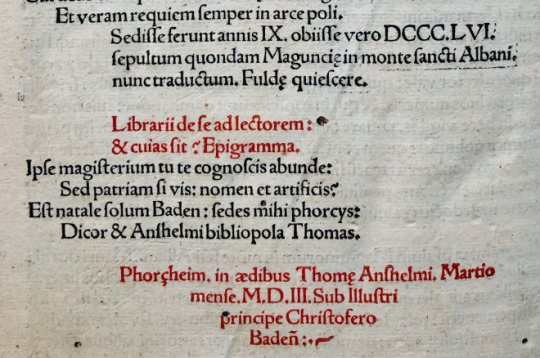
Peter Godman, Poetry of the Carolingian Renaissance (Norman: University of Oklahoma Press, 1985), 249. A. G. Rigg and G. R. Wieland, ‘A Canterbury Classbook of the Mid-eleventh Century Anglo-Saxon England 4 (1974), 113-30.
William Schipper, ‘Hrabanus Maurus in Anglo-Saxon England: In Honorem Sanctae Crucis’, in Early Medieval Studies in Memory of Patrick Wormald, ed. Stephen Baxter, Catherine Karkov, Janet L. Nelson, David Pelteret (Farnham, Surrey; Burlington, Vt.: Ashgate 2009), 283-98.
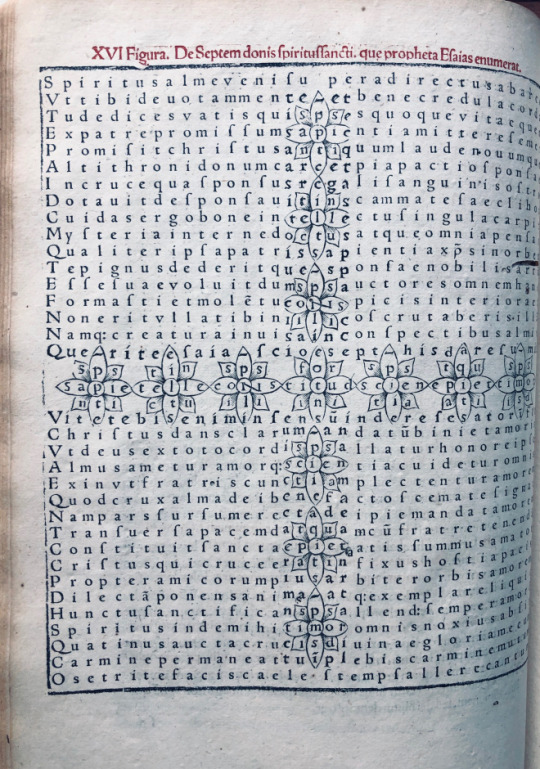
Proctor, R. Index to the early printed books in the British Museum,; 11747; Adams, H.M. Catalogue of books printed on the continent of Europe, 1501-1600, in Cambridge libraries,; R3; Catalogue of a collection of early German books in the library of C. Fairfax Murray,; 350; Panzer, G.W.F. Annales typographici,; VIII 227, 2; Pollard, A.W. Catalogue of books mostly from the presses of the first printers … collected by Rush C. Hawkins,; 189 Panzer, VIII, 227, no. 2. Proctor 11747. Fairfax Murray 350./ Last leaf blank./ Edited by Jakob Wimpheling.–cf. title page verso./ Illustrations: 2 woodcuts of the author presenting his book to the pope, and many woodcut figures (Christ, cherubs, crosses, symbols, etc.) printed on 28 pages of text. Some of the text within and near the outline figures is xylographic, the rest printed. The letters within the outlines are printed in red and may be read separately in a different sense. Printed in red and black, initials (except on t.p.) in red./ With label of Sinclair Hamilton. Peter Godman, Poetry of the Carolingian Renaissance (Norman: University of Oklahoma Press, 1985), 249. A. G. Rigg and G. R. Wieland, ‘A Canterbury Classbook of the Mid-eleventh Century Anglo-Saxon England 4 (1974), 113-30. William Schipper, ‘Hrabanus Maurus in Anglo-Saxon England: In Honorem Sanctae Crucis’, in Early Medieval Studies in Memory of Patrick Wormald, ed. Stephen Baxter, Catherine Karkov, Janet L. Nelson, David Pelteret (Farnham, Surrey; Burlington, Vt.: Ashgate,
^)^)^)^(^(^(^
The second edition One-Hundred and three years later.
8). 354J Hrabanus Maurus. 784-856?
Magnencij Rabani Mauri De Laudib[us] sancte Crucis opus. erudicione versu prosaq[ue] mirificum. Cum antiqviate avctoris <annis abhinc prope octingentis abbatis primum fuldensis, archiepiscopi postea moguntini. tum noitate scriptionis memorabile. Qvo figvris sive imaginibvs XXVIII. multi fedei christianae mysteria, multi mystici numeri; angelorum, virtutum, VII. donorum Spiritus Sancti, VIII. Beatitudinum, IV. elementorum, IV. temorum anni, VI euangelistarum & agni, mensium, ventorum, V librorum Moysis, nominis Adam, alleluia, & amen, aliarumq[ue] rerum vis & dignitas in formam crvis reedacta, subtiliter et ingeniose explicantur.
Augustæ Vindelicorvm e typographeo Praetoriano. , 1605. $9,000
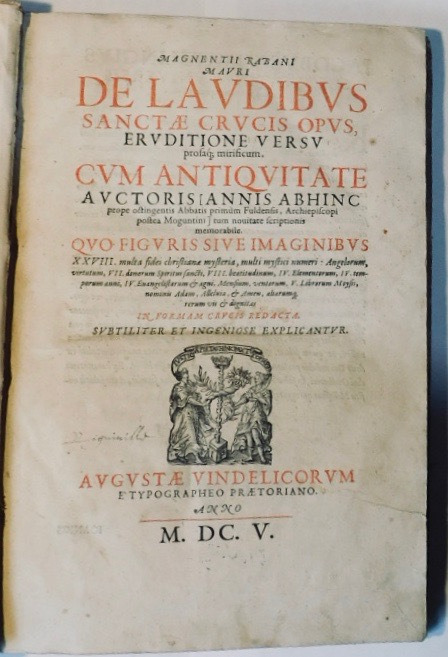
Folio Aa6, Bb4, a-k6, a6, B4, c4. (complete). Printers mark on title page, woodcut initials printed in red, two woodcuts of Alcuin interceding on behalf of Rabanus before Pope Gregory iv, and of Rabanus presenting his poems to the Pope; a figured dedicatory poem to Louis the Pious and a figured prefatory poem, 28 carmina figurata, the first entirely xylographic, the remaining poems combining printed and xylographic letters with the versus intexti printed in red (except fig. xvi), enclosed by either woodcut figures (of the emperor, Christ, the Evangelists, Cherubim, etc.) printed in black or by Christian symbols and characters, most defined by metal rules in red. Bound in contemporary deer skin.
This aside from the prologue this edition is a re-set reproduction of the first printed edition (see above)
#######+++++#######
9) 383J Johannes de Anania
Commentaria super prima et secunda parte libri quinti Decretalium. Add: Repertorium
Bologna : Henricus de Colonia, 7 Dec. 1479, 5 Jan. 1480. $17,000
Large folio 422 x 285mm Pars III (bound first) a8,b6,c10,d6,e8,f4,g8.(lacking a1Blank) Pars I (bound second) a10,b8,i8,k6,l8,m8,n6,o6,p8,q8,r10s 10. Pars II (bound third) A8,-F8,G6,H8,-L8,M6,N8,O8P6,Q8,R8,S6,T8,U10,X8-Z8, &8, ¶8,€8,¡8. In three parts, dated: 7 Dec. 1479 (Commentaria, partes I-II); 5 Jan. 1480 (Repertorium)
No copy of parts II & III in the US. The margin of a2 of the Repertorium cut off with no text loss (see image) This is a very very wide margined copy, with strong and crisp paper. The first leaf is stroked in red and blue. Throughout the rest of the books capital spaces are left blank. This copy is bound in 19th century vellum.
ANANI’A, JOHANNES DE : his family name, Anagni. implies that he was of the family of the Catani, and that his father’s name was Leonardo. He taught canon law in Bologna, and had the reputation of a conscientious man. He studied under Floriano di San Pietro. Alexander Tartagni and Andreas Barbati were his scholars; the former became his step-son, and the latter inherited his library. According to Orlandi, Anania was sent ambassador from the city of Bologna to Pope Martin V. in 1425, and he was also employed to conduct negotiations with other princes. Johannes de Anania at the time of his death, in 1455 or 1458, was archdeacon at Bologna. Spangenberg enumerates four of his works, three of which were published at Lyon between 1521 and 1555 : — 1. A Commentary on the fifth book of the Decretals, published in folio at Lyon in 1521, and reprinted there in 1553. 2. Consilia, discovered and edited by Ludovico Bolognini, in folio, at Lyon in 1555, reprinted at Venice in 1570. 3. “De Revocatione Feudi alienati,” in octavo, at Lyon, in 1546, reprinted at Basle in 1564. 4. A Collection of the Decisions of the Roman Rota, at Venice, in folio, in 1496. Mazzuchelli mentions a treatise on the law as to salaries, “Allegatio de Salario et Stipendio ac de Obligatione et Promissione Domini,” which is preserved in MS. at Bologna in the library of the Collegio di Spagna. In addition to these Lipenius ascribes to Johannes de Anania a legal tract on church patronage, “De Jure Patronatus Ecclesiastico,” published at Amsterdam in 1640; and a collection of cases (” Quaestiones”) at Cologne in 1570. To the folio edition of Baldus, “In Usus Feudorum Commentaria,”
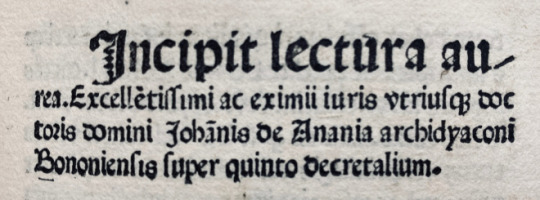
published at Lyon in 1550, there is appended a thesis on the law regarding the alienation of fiefs, maintained by Johannes de Anania at a public disputation in Bologna. The date is not given, but he is styled “Doctor et Canonicus,” and his opponent is said to have been Secundinus de Natis; and the publisher intimates that the MS. had been preserved in the library of Johannes Nevizanus at Asti. No. 446. of the Arundel MSS. in the library of the British Museum contains a treatise “De Usuris” by Johannes de Anania. The volume is of a large folio form, and the ” De Usuris,” written in a small character with numerous contractions, occupies the folios 93. to 164. inclusive, each folio containing four columns. These treatises are the only compositions of the author we have seen, and they leave a favourable impression of his skill in selecting authorities to support and elucidate his positions, and of his talent for lucid arrangement. (Mazzuchelli, Scrittori d’ Italia; Spangenberg, in Ersch und Gruber’s Allgemeine Encyclopadie; Alidosi, Appendice alli Dottori Bolognesi de Legge Canonica e Civile; Orlandi, Notizie degli Scrittori Bolognesi; Baldus Perusinus, in Usus Feudorum Commentaria doctissima, quibus accesserunt Andr. Siculi Adnotationes una cum Joan. de Anania eleganti Disputatione in tres secta Quastiones, Lugduni, 1550, fol.; Arundel MSS. in the British Museum, No. 446.) W. W
Not in Goff: ISTC ij00250150; H 938*; Torchet 521; IGI 5245; IBE 3188; Kotvan 702; Sajó-Soltész 1881; Martín Abad J-44; Voull(B) 2735,20; Walsh 3188; BSB-Ink I-365; GW M12841
Holdings: United States Harvard University, Law School Library (I) only.

)0(
)0(
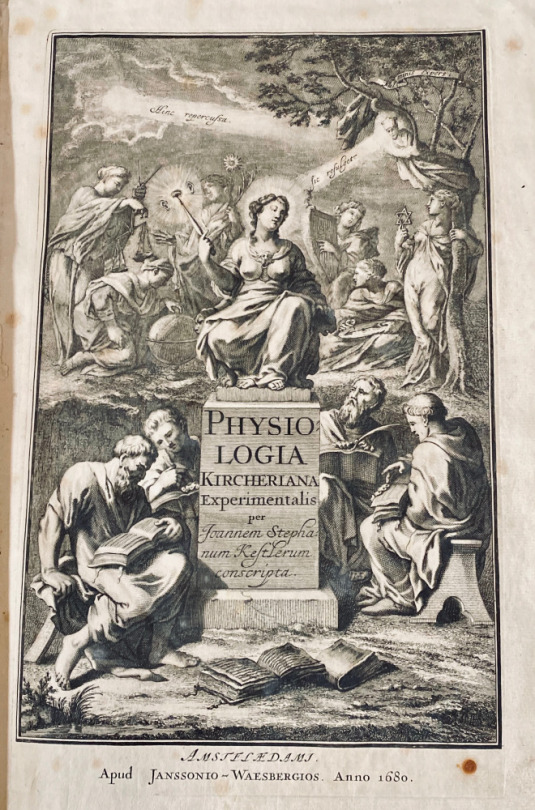
10) 381J Athanasius Kircher 1602-1680
Physiologia Kircheriana Experimentalis, Qua Summa Argumentorum Multitudine & Varietate Naturalium rerum scientia per experimenta Physica, Mathematica, Medica, Chymica, Musica, Magnetica, Mechanica comprobatur atque stabilitur. Quam Ex Vastis Operibus Adm. Revdi. P. Athanasii Kircheri extraxit, & in hunc ordinem per classes redegit Romæ, Anno M. DC. LXXV. Joannes Stephanus Kestlerus Alsata, Authoris discipulus, & in re litterariâ assecla, & coadjutor.
Amsterdam: Ex Officinâ Janssonio-Waesbergiana. Anno 1680 $9,500
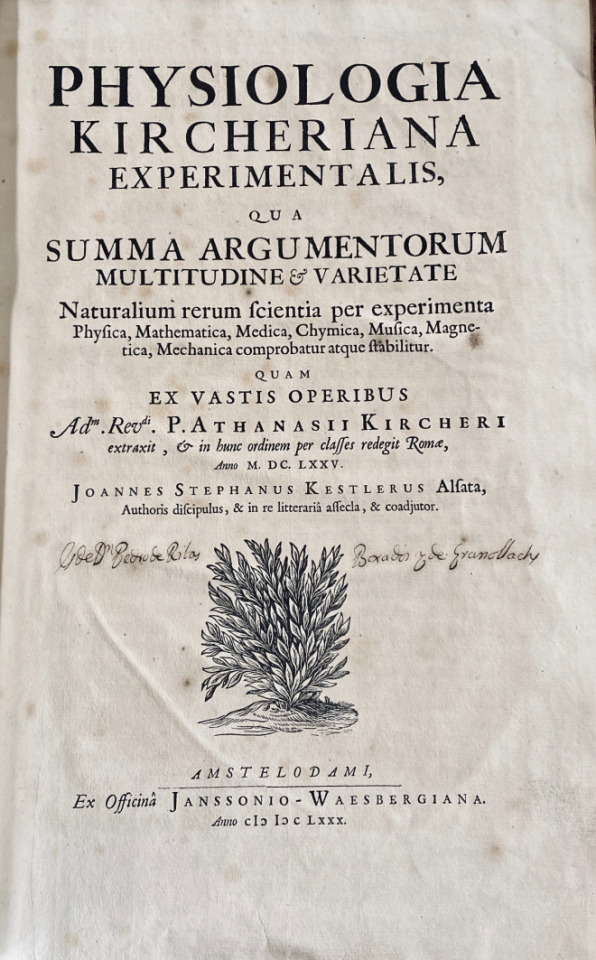
Folio. 15 x 9 3/4 inches. *4, A-Z4, Aa-Ii4. First edition.mmThis copy is quite clean and crisp throughout, never having been washed or pressed. There is some occasional spotting and browning. but none is too extensive. The binding is twentyth century full vellum with title on spine. an impressive and large copy!
“Thus in the must varied branches of science Kircher played the role of pioneer. Even medicine received his attention, as is shown for example by his treatise, ‘Scrutinium phyisco-medicum contagiosæ luis, quæ pestis dicitur’ (Rome, 1663). His scientific activities brought him into scientific correspondence with scholars laboring in the most different fields, as the numerous volumes of his extant letters show. It is to his inventive mind that we owe one of the earliest of our counting machines: the speaking-tube and æolian harp were perfected by him. He was also the inventor of the magic lantern which has since been brought to such perfection and is and is today almost indispensable. [All of these devices are illustrated in the present work, compiled in the year of the author’s death by Kircher and his student Johann Stephan Kestler, including three large and striking engravings of magic lanterns.]” May I ask the reader to take the following quote with a measure of indulgence for its closed minded author [circa 1913] with the hope that modern folk of the last decade of the second millennium have a bit more tolerance for the many sciences that we have yet to master. “That the most varied judgments should be formed and expressed on a man of such encyclopædic knowledge was only to be expected. He tried to find a grain of truth even in the false sciences of alchemy, astrology, and horoscopy, which were still in his time much in vogue, nor is it surprising that in the province of astronomy he did not at this early date defend the Copernican System.” (the above two quoted taken from the Catholic Encyclopedia, vol. viii, page 662) Kircher was an accomplished and versatile scholar who applied his intellectual abilities to a myriad of scientific problems. This work is a fascinating compendium of scientific experiments and principles which documents the accomplishments of early modern thinkers of the west.
^)^)^)^(^(^(^
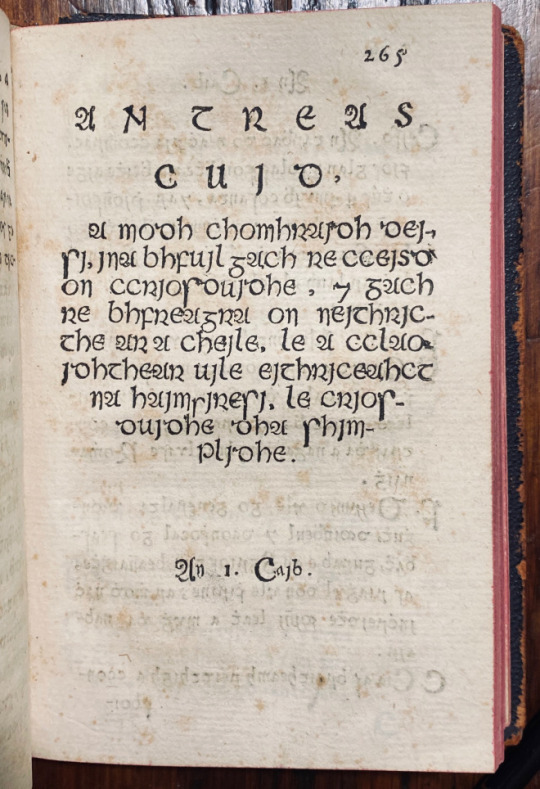
11) 380J Francis Molloy. fl 1660
Lucerna fidelium, seu, Fasciculus decerptus ab authoribus magis versatis, qui tractarunt de doctrina Christiana : divisus in tres partes.
Romæ : Typis Sacræ Congreg. de Propaganda Fide, M DC LXXVI [1676] $4,500 Octavo 6 X 4 inches : A-2B8 2C2. complet, signature ) is mis-signed . This copy is bound in early 20th century sheep.
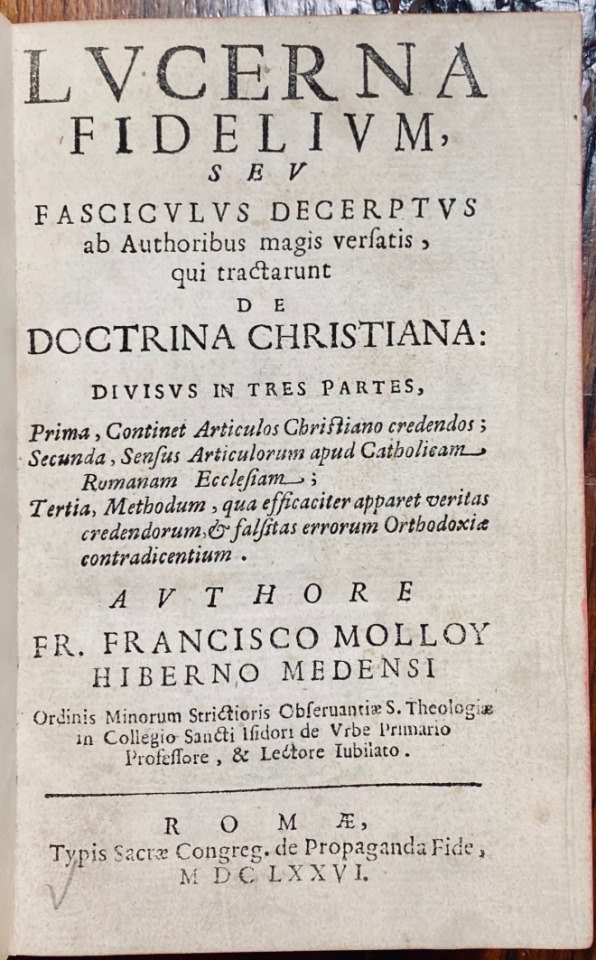
MOLLOY or O’MAOLMHUAIDH, FRANCIS (Jl. 1660), theologian and grammarian, was a native of the county of Meath, Ireland. The family of which he was a member had extensive landed possessions in the district known as O’Molloys’ Country, and some of them engaged actively in the Irish movements from 1641 to 1652.
Francis Molloy entered the order of St. Francis, became a priest, was appointed professor of theology at St. Isidore’s College, Rome, and acted as agent for the Irish catholics at the papal court in the reign of Charles II. His first published work was entitled ‘Tractatus de Incarnatione ad mentern Scoti,’ 1645. This was followed in 1658 by ‘ Jubilatia genethliaca
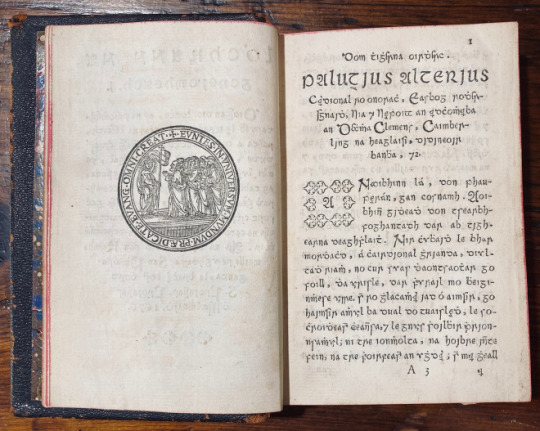
in honorem Prosperi Balthasaris Philippi, Hispani principis, carmine,’ and by a Latin treatise on theology in 1666.
A catechism of the doctrines of the catholic church in the Irish language was published by Molloy in 1676 with the title: ‘Lucerna tidelium, seu fasciculus decerptus ab authoribus magis versatis qui tractarunt de doctrina Christiana.’ It was printed at Rome at the press of the Congregation ‘de propaganda fide,’ ( This book is the first book they printed in Irish Type) from which, in 1677, issued another book by Molloy, entitled ‘Grammatica Latino-Hibernica,’ 12mo, the first printed grammar of the Irish language. Edward Lhuyd [q. v.], in his’ Archaeologia Britannica,’published at Oxford in 1707, mentioned that he had seen a manuscript grammar of the Irish language copied at Louvain in 1669 which partially corresponded with that of Molloy. He added that Molloy’s grammar, although the most complete exta’nt in his time, was deficient as to syntax and the variation of the nouns and verbs. The date of Molloy’s death has not been ascertained. In 1626 Propaganda Fide had installed a printing press for the foreign missions and not much later another one was brought to Louvain where books and catechisms were printed for both the local college and the Irish mission.* The problem with the Propaganda printing press was that only books in Latin and Italian were allowed to be printed so it took until 1674 when Francis Molloy asked for permission to print a catechism there in Irish with the explanation “che altra malamente capisce e vacilla assai per mancanza d’intruttore e d’intruttion sana.”**.
[“Irish priests at Rome had a new Irish type cut about 1675 … [this was] their first book.”- -H. Reichner, Catalogue 34, Jan. 1968]
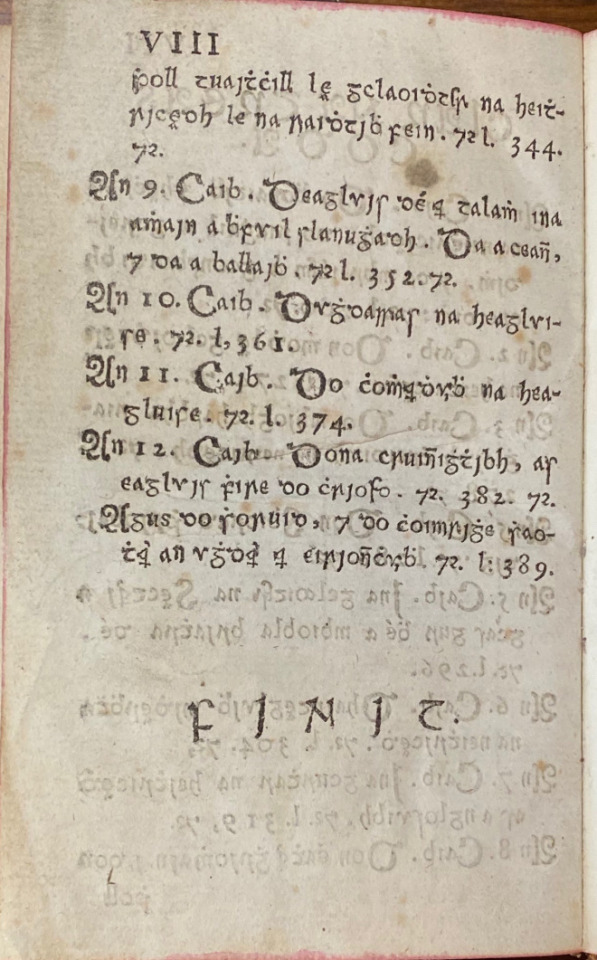
Wing O291C, English short title catalogue,; R41480; Clancy, T.H. English Catholic books, 1641-1700 (rev. ed.),; entry 743; Catalogue of seventeenth century Italian books in the British Library,; page 628 *& ** ;Egan, Bartholomew (ed.): Notes on Propaganda Fide Printing Press and Correspondence concerning Francis Molloy O.F.M., in: Collectanea Hibernica, No. 2 (1959), pp. 115-124.
)0(
)0()0(
With a reference to the invention of printing on the verso of Folio 64.
12) 359J Werner Rolewinck 1425-1502
Fasciculus temporu[m] omnes antiquo[rum] chronicas strictim complectens felici numine incipit. Prologus.
Venice : Erhard Ratdolt, 8 Sept. 1485 $16,000
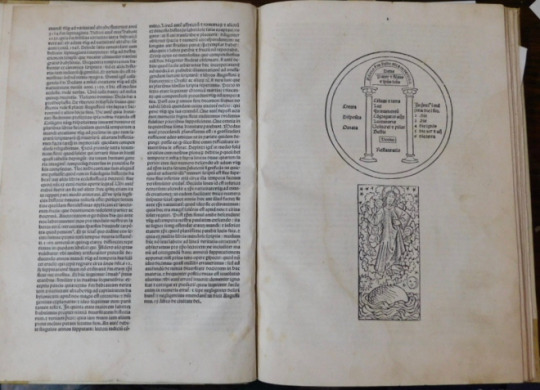
Folio (275 x 195 mm). [A]8 [a-g]8 [h]10 75 leaves without signatures or page numbers (9 leaves, 1-66 foliated ), 3 columns in table, 59 lines and foliation, gothic letter, 2 large ornamental initials, 59 woodcuts, one full-page, woodcut diagram. Fifth and last Venetian edition, and fourth Ratdolt edition being the most complete edition of Rolewinck s chronological history of the world. The chronology follows a double time-line, measuring time from both the Creation and the birth of Christ to the death of the Ottoman Sultan Mehmed II commonly known as Mehmed the Conqueror in the year 1481, demanding a
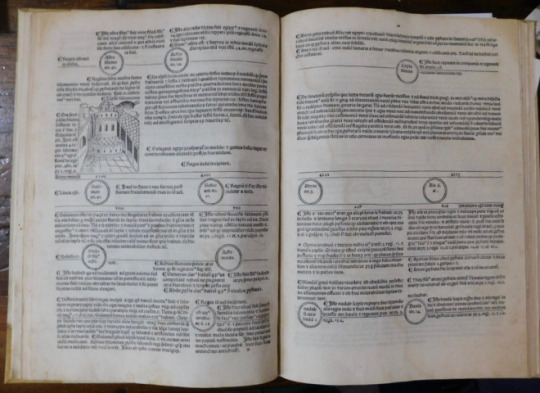
remarkably complex typographical layout. The Fasciculus Temporum (Little bundles of time) was the first book printed on history of the world, it is also one of the earliest and greatest of illustrated incunabula. The illustrations show Noah s Ark, the tower of Babel and contain many town views including Jerusalem, Syracuse, Rome and the Doge s Palace in Venice.
Rolewinck (1425-1502) was a Carthusian monk and prolific author. This book was both the most popular of his numerous writings and the most popular concise world chronicle of its time, being printed 32 times in the 15th century, including translations into French, German and Dutch . Rolewinck’s Fasciculus Temporum was an enormously popular world chronicle, appearing in over 30 incunabular editions in Latin, German, French, and Dutch. A very handsome and typographically-sophisticated volume, with varying columns, circular devices with inset type, and woodcuts throughout.

This work aspires to trace the history of the world from the beginning of time until the year of pulication. The thirty-three woodcuts are crisp and rather charming, and, like those in many fifteenth- and sixteenth-century chronicles, are occasionally reused to illustrate different events and locations. The work is fascinating for the comprehensiveness of its content as well as the beauty of its execution. Of particular interest is a reference to the invention of printing (in 1454) on the verso of Folio 64.

Goff R271; GW M38738; ; BMC V 290; H 6935*; Redgr 52; Essling 280; Sander 6530; Schr 5116C; Pell Ms 10192 (9969); CIBN R-177; Arnoult 1276; Neveu 528; Nice 269; Torchet 821; Polain(B) 4691; IDL 3943; IBE 4955; IGI 8420; CCIR R-40; Kotvan 1024; Sajó-Soltész 2972; Gspan-Badalić 590; IBPort 1576; Mendes 1124, 1125, 1126; Madsen 3526; Martín Abad R-48; Voull(B) 3801; Hubay(Augsburg) 1811; Hubay(Eichstätt) 898; Walsh 1830; Rhodes(Oxford Colleges) 1525; Bod-inc R-121; Sheppard 3688; Pr 4404; BSB-Ink R-247
#######+++++#######
13) 367J Petrus de Rosenheim. (1380-1432). Nom probable : Petrus Wiechs
[Roseum memoriale divinorum eloquiorum]
[Köln] : [Southern Germany : n.pr., about 1480-90?] or [Cologne? : n.pr., about 1483] or [Ludwig von Renchen?], 1483. $12,000
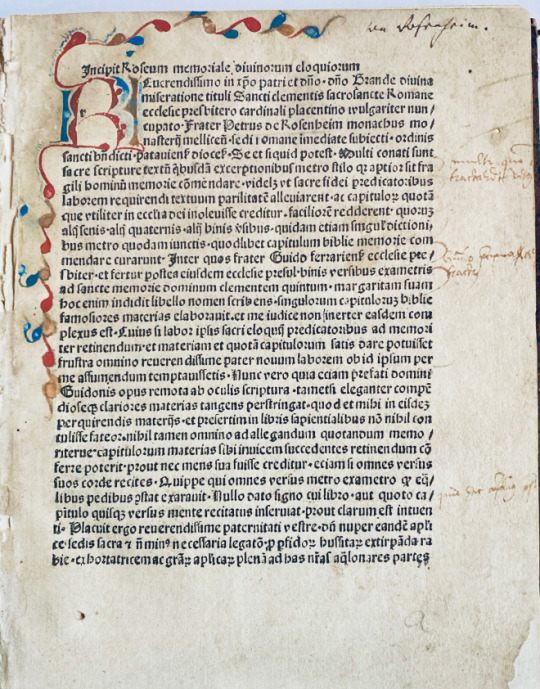
Quarto (190 x 155 mm). Collation: a-f8 [1-68]. [48] leaves. First Edition. Text in one column, 32 lines. Type: 80G. Initials painted in red, and blue ink throughout. Simple vellum binding from a 15th century vellum leaf. Gothic script. . A very good copy, old repair to the first blank leaf, a few spots, pale stain at the lower blank corner of the first quires. It is not known where and by which press this edition was printed. ISTC gives Southern Germany and a date of c.1480-1490, GW tentatively suggests Oberrhein, 1483, and Proctor attributes it to Ludwig Von Renchen in Cologne. The hexameters of each section of the summary form an acrostic of the letters of the alphabet. (alphabetarium) as to insure memorization in the proper sequence, the first word of each verse falls neatly into alphabetical order. [1,194 short mnemonic verses] It uses characteristic couplets (distiches) to express the main content of all chapters of the Old and New Testament. This introduction makes it possible to easily find every quote in the Bible.
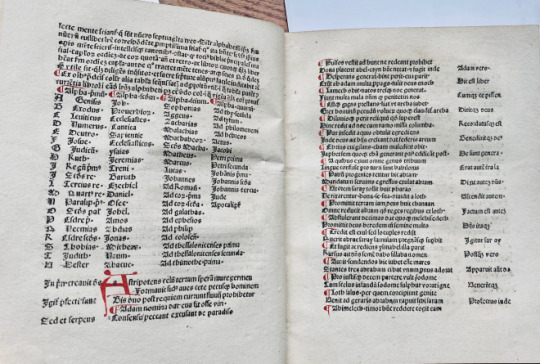
A significant record of the essential role of memory in late-medieval piety, One of the earliest printed books on the ars memorativa or mnemotechnic was composed by the German Benedictine monk Petrus of Rosenhaym (Upper Bavaria), written between 1423 and 1426 for Cardinal Giulio Branda di Castiglione. Petrus of Rosenhaym composed numerous treatises, sermons, and verses: the Roseum memoriale is surely his most famous work, enjoying wide popularity during the fifteenth century and first half of the sixteenth century. The mnemotechnic method here employed is extremely complex: the hexameters of each section of the summary form an acrostic of the letters of the alphabet. in. A highly popular and broadly used manual, its copies could be found in almost every European church after the invention of the printing press it was printed in several different locations. This early medieval incunable has not been clearly dated| researchers attribute it to the Upper Rhine region sometime between 1480 and 1483. After studying at the University of Vienna, Petrus de Rosenhaym, along with his friend Nikolaus Seyringer, moved to Subiaco, where he entered the Benedectine order. In 1413, he was appointed prior to the cloister of Rocca di Mondragone near Capua. In 1416, he took part in the Council of Konstanz, and later he was prior in Melk (Lower Austria). After 1423, he was appointed ‘cursor biblicus’ and ‘magister studentium’. Goff R336; BMC I 312; ; GW M32724; ISTC; ir00336000; Polain(B) 3128; IBE 4559; IGI 7668; IBP 4380; Sajó-Soltész 2676; Madsen 3549; Borm 2134; Hubay(Würzburg) 1704; AmBCat 199; Walsh 492; Oates 867; Pr 1517;; BSB P-362; Van der Haegen II,2:16,4?; Young 278;.
Copies in the United States of America: Brown, Harvard, Library of Congress, Huntington, The Newberry Library, Yale
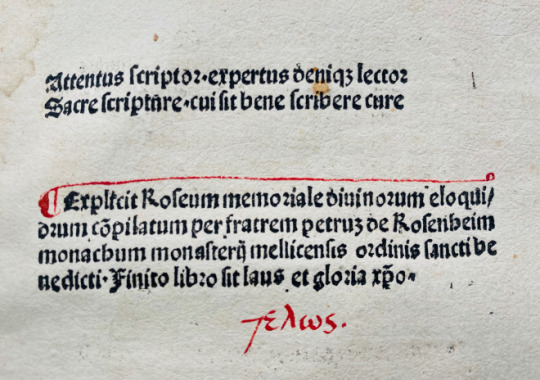
^)^)^)^(^(^(^
^)^)^)^(^(^(^
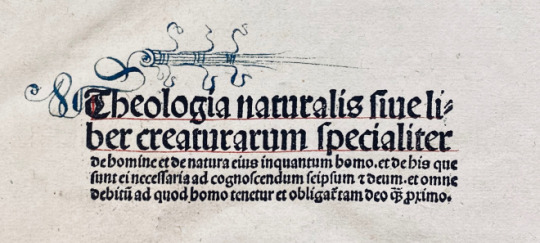
14) 384J Raymundus de Sabunde -1436
Theologia naturalis, sive, Liber creaturarum : specialiter de homine et de natura eius inquantum homo, et de his que sunt ei necessaria ad cognoscendum seipsum [et] deum et omne debitu[m] ad quod homo tenetur et obligat[ur] tam deo quam p[ro]ximo.
Straßburg: Martin Flach, 21 January 1496. $17,000
Imp[re]ssus Argentine per Martinum Flach inibi co[n]ciuem anno incarnat[i]o[n]is d[omi]nice Millesimoq[ua]dringentesimononagesimosexto men[sis] v[er]o Ianuarij die vicesimop[ri]mo
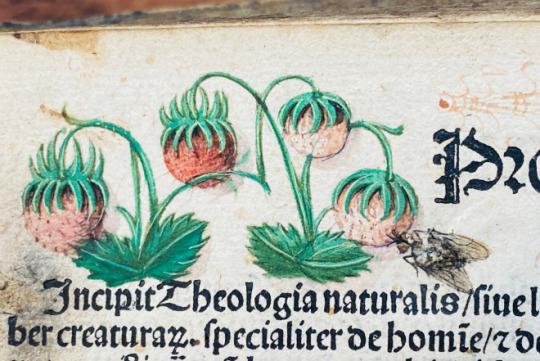
Folio (280 x 200mm.) π6 a8 b-y6 z8 [et]6 [con]8 (the last leaf supplied from another copy, printed on recto only), The second leaf (π2) has a beautiful a green painted initial A [Amor] on a gold ground with pink and blue edges, extending into the margins with green-stemmed pink and gold flowers on opposite side. The first leaf of the text proper (a1) Has a large blue painted initial A on a gold ground with pink and green edges, large pink and purple flowers, strawberries thistles and a Tromp l’oeil of a Dead fly,( quite charming) fill uppermargin; 3-line initials in alternating red and blue, rubricated throughout. This is the first dated edition.
It is bound in Contemporary deerskin over wooden boards, covers panelled and tooled in blind with repeated small rosette tool, remains of paper labels on spine (lacking metal furniture and clasps, some wear and small areas of loss). This copy has some contemporary manuscript notes, including a two-line note on f. b2recto, and on f.a2verso is a marginal drawing of the scala naturae with the four gradus marked. Provenance: Contemporary inscription of Johannes Pengl (Penngl) from Weißenburg in Bavaria, who was active in Eichstätt & Vienna, with a note of cost of binding on final paste down. Later notes and shelf-mark on front paste-down and loose sheet.
Colophon: Finit liber creatura[rum] seu nature siue nature siue de ho[m]i[n]e p[ro]pt[er] que[m] alie creature facte su[n]t ex cui[us] cognit[i]one illu[m]inat[ur] ho[mo] i[n] [co]gnit[i]o[n]e dei [et] creaturarum.
This text marks the dawn of a knowledge based on Scripture and REASON.
The Catholic Encyclopedia sees this as “It represents a phase of decadent Scholasticism, and is a defense of a point of view which is subversive of the fundamental principle of the Scholastic method. The Schoolmen of the thirteenth century, while holding that there can be no contradiction between theology and philosophy, maintain that the two sciences are distinct. Raymond breaks down the distinction by teaching a kind of theosophy, the doctrine, namely that, as man is a connecting link between the natural and the supernatural, it is possible by a study of human nature to arrive at a knowledge even of the most profound mysteries of Faith. The tendency of his thought is similar to that of the rationalistic theosophy of Raymond Lully….Moreover, in Spain scholastics, in combating Islam, borrowed the weapons of their erudite antagonists. Close internal resemblance indicates that Raimund de Sabunde was preceded in method and object by Raymund Lully.” CE

What is new and epoch-making is not the material but the method; not of circumscribing religion within the limits of reason, but, by logical collation, of elevating the same upon the basis of natural truth to a science accessible and convincing to all. He recognizes two sources of (1)knowledge, the book of nature and (2) the Bible. The first is universal and direct, the other serves partly to instruct man the better to understand nature, and partly to reveal new truths, not accessible to the natural understanding, but once revealed by God made apprehensible by natural reason. The book of nature, the contents of which are manifested through sense experience and self-consciousness, can no more be falsified than the Bible and may serve as an exhaustive source of knowledge; but through the fall of man it was rendered obscure, so that it became incapable of guiding to the real wisdom of salvation. However, the Bible as well as illumination from above, not in conflict with nature, enables one to reach the correct explanation and application of natural things and self. Hence, his book of nature as a human supplement to the divine Word is to be the basic knowledge of man, because it subtends the doctrines of Scripture with the immovable foundations of self-knowledge, and therefore plants the revealed truths upon the rational ground of universal human perception, internal and external.
The first part presents analytically the facts of nature in ascending scale to man, the
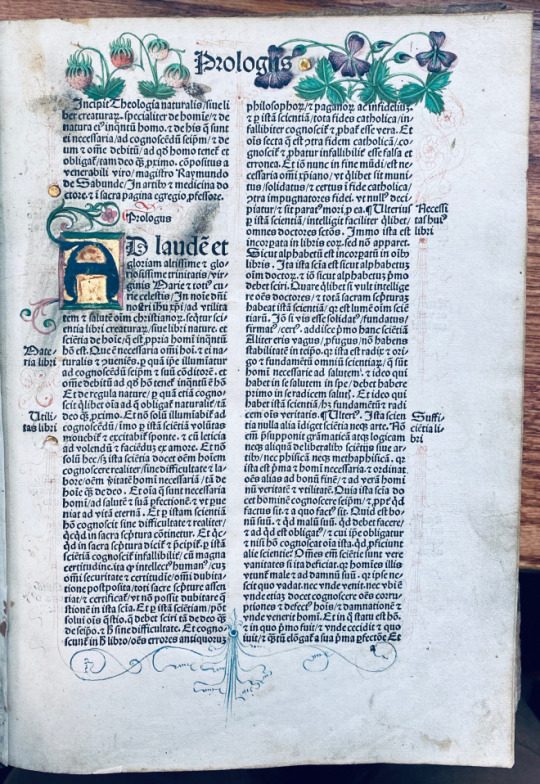
climax; the second, the harmonization of these with Christian doctrine and their fulfillment in the same. Nature in its. four stages of mere being, mere life, sensible consciousness, and self-consciousness, is crowned by man, who is not only the microcosm but the image of God. Nature points toward a supernatural creator possessing in himself in perfection all properties of the things created out of nothing (the cornerstone of natural theology ever after). Foremost is the ontological argument of Ansehn, followed by the physico-theological, psychological, and moral. He demonstrates the Trinity by analogy from rational grounds, and finally ascribes to man in view of his conscious elevation over things a spontaneous gratitude to God. Love is transformed into the object of its affection; and love to God brings man, and with him the universe estranged by sin, into harmony and unity with him. In this he betrays his mystical antecedents. Proceeding in the second part from this general postulation to its results for positive Christianity, he finds justified by reason all the historic facts of revealed religion, such as the person and works of Christ, as well as the infallibility of the Church and the Scriptures; and the necessity by rational proof of all the sacraments and practices of the Church and of the pope. It should be added that Raimund’s analysis of nature and self-knowledge is not thoroughgoing and his application is far from consistent. He does not transplant himself to the standpoint of the unbeliever, but rather executes an apology on the part of a consciousness already Christian, thus assuming conclusions in advance that should grow only out of his premises. Yet his is a long step from the barren speculation of scholasticism, and marks the dawn of a knowledge based on Scripture and reason.
In its day, and for a long time later, it was a celebrated text. The title translates ‘Natural Theology or the book of [living] creatures, in particular about man and his nature inso far as he is man, and about those things necessary for him to know both himself and God, and about every duty by which man is held and obligated both in respect of God and his neighbour.’ The scope is therefore pretty wide. The main point of Sebond’s work is that that faith can be taught, attained, understood by natural reason and not simply on the basis of blind faith and literal adherence to Scripture, although this last is given full weight as is the teaching of ‘sacrosancta romana ecclesia who is the mother of all faithful christians, mistress of grace and faith and rule of truth…’ (preface on a2ra). The work is divided into 330 ‘tituli’ or chapters beginning with the origins of natural theology and ending with the last judgement, the subjects treated at greatest length being ‘God’ and ‘Man’.
Theologia Naturalis, which circulated widely in manuscript and is known particularly in a manuscript in Toulouse (747) corrected after the author’s own copy, was first published in what is called the ‘third family’ in Deventer in 1484-85 (possibly through the offices of the Brothers of the Common Life; the Bodleian copy is from their house at Doesburg, Holland), and then Lyon ca. 1488 from the printer Balsarin. This Flach printing circulated widely (a copy was at Winchcomb abbey in Gloucestershire within a few years (now in Glasgow) and early in the 16the century Archbishop Warham (Abp. 1503-32 ) gave a copy to All Souls College, Oxford) and is the first dated edition. There were a number of later editions (including another Flach edition of 1501) right up into the 17th century. Indeed the well-known 17th-century philosopher Kenelm Digby ( 1603-1664) had a copy of this edition (now at Durham University Library at Bamburgh Castle). Part of the Theologia (Dialogos de la naturaleza delhombre) was translated into Spanish and printed in Madrid in 1610 and 1616, and a resumé by the Carthusian Petrus Dorlandus (Viola anime per modum dyalogi) was published in Cologne in 1499 (ISTC id00360000 ) and in Toulouse in 1500 I(ISTC id003610000).. The Theologia because of the importance it accorded human reason did not escape the notice of the holy Office and was placed on the Index in the middle of the 16th century. Montaigne indeed discovered this during his visit to Rome.
Goff R33.; BMC I, 154.; HC 14069*; GW M36911; Bod-inc R-018. ISTC ir00033000. Palau 283900
◊
◊ ◊
◊
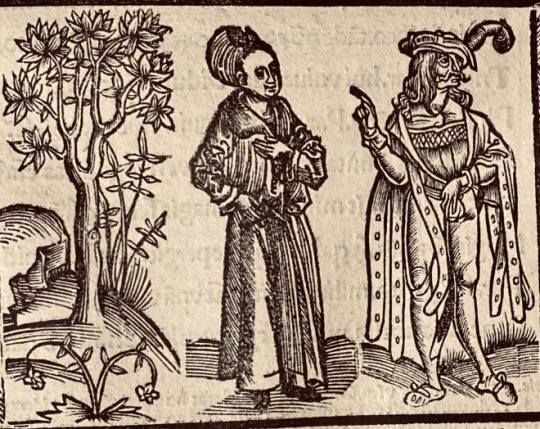
15) 369J Publius Terentius Afer. 185-
Terentius Comico Carmine
Impressum in nobili Helvecior[um] urbe Arge[n]tina : Per Ioanne[m] Grüninger mira etium arte ac diligentia. 1503 $7,500
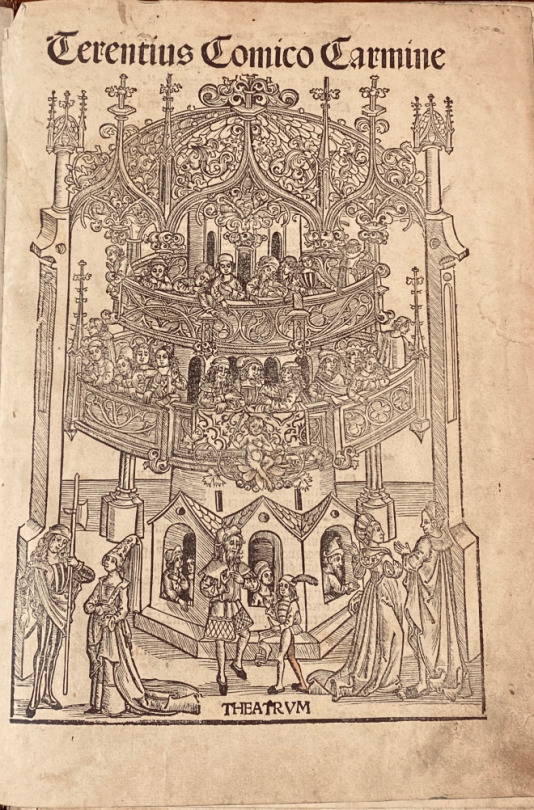
Folio A6 B8 C-Z6 AA6 Bb4 Cc6. There are numerous handwritten annotations in ink (marginal and interlinear, ff. IX-XIX). The binding of half-calf with corners of the XIXth, back with 4 sewing support with pieces of title of red and green leather, boards covered with stony marbled paper. { A typical Kloss binding} (there is a tear sig. B1, with loss; first signature cut shorter at the lower margin; restorations of paper with the last sheets in the upper margin; Yet this copy remains a beautiful illustrated edition of the comedies of Terence with comments by Aelius Donatus and Calphurnius. From the presses of the famous and prolific Strasbourg printer-publisher Johann Reinhard, known as Grüninger, it is remarkably illustrated with 7 large full-page woods (including the famous representation of a theater on the title),
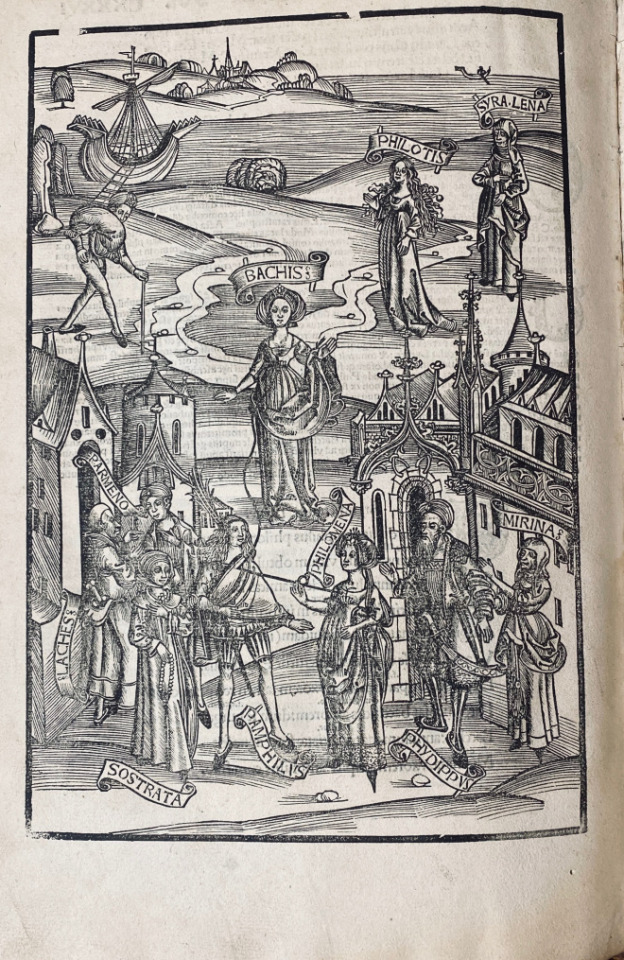
woodcuts depicting the dramatis personae in a land- or cityscape, one at the beginning of each play, and 142 woods in the text 19 of the cuts appear here for the first time; the others are from the 1496 ed. «Grüninger’s illustrations, intended to clarify the complexities of Terence’s plots for the reader, act as visual mnemonic devices for the book’s anticipated student audience. This is demonstrated especially in the full-page woodcut that begins each play, where all of the characters are displayed with connecting lines to indicate their interrelationships. covered with stony marbled paper. { A typical Kloss binding} (there is a tear sig. B1, with loss; first signature cut shorter at the lower margin; restorations of paper with the last sheets in the upper margin; Yet this copy remains a beautiful illustrated edition of the comedies of Terence with comments by Aelius Donatus and Calphurnius. From the presses of the famous and prolific Strasbourg printer-publisher Johann Reinhard, known as Grüninger, it is remarkably illustrated with 7 large full-page woods (including the famous representation of a theater on the title), woodcuts depicting the dramatis personae in a land- or cityscape, one at the beginning of each play, and 142 woods in the text 19 of the cuts appear here for the first time; the others are from the 1496 ed.

«Grüninger’s illustrations, intended to clarify the complexities of Terence’s plots for the reader, act as visual mnemonic devices for the book’s anticipated student audience. This is demonstrated especially in the full-page woodcut that begins each play, where all of the characters are displayed with connecting lines to indicate their interrelationships. A verbal explanation and plot summary accompanies each of these illustrations. The most remarkable feature of Grüninger’s Terence is his use of small interchangeable woodcuts that were combined to create the individual scene illustrations for each play. Individual blocks were cut for most of the characters of the six plays, who are identified by name in overhead banners. The blocks were cleverly combined repeatedly in groups of two to five, sometimes together with cuts of trees and buildings, to create the illustrations. Grüninger was attempting to use the woodcuts as repeatable and combinable objects, much in the same manner as movable type» (Christine Ruggere, in Vision of a Collector: The Lessing J. Rosenwald Collection in the Library of Congress)
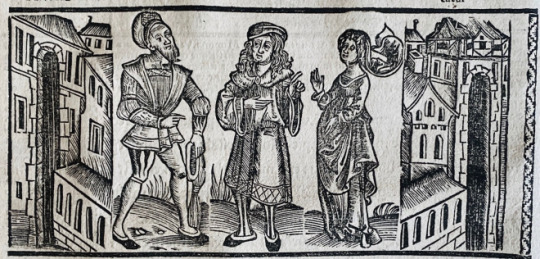
Terence writes in a simple conversational Latin, pleasant and direct. Due to his clear and entertaining language, Terence’s works were heavily used by monasteries and convents during the Middle Ages and The Renaissance. Scribes often learned Latin through the meticulous copying of Terence’s texts. Priests and nuns often learned to speak Latin through reenactment of Terence’s plays, thereby learning both Latin and Gregorian chants. Although Terence’s plays often dealt with pagan material, the quality of his language promoted the copying and preserving of his text by the church. The preservation of Terence through the church enabled his work to influence much of later Western drama. [Holloway, Julia Bolton (1993). Sweet New Style: Brunetto Latino, Dante Alighieri, Geoffrey Chaucer, Essays, 1981-2005.] This copy has the book plate and a binding typical for Kloss. It is NOT Melanchthon’s copy, or his notes!
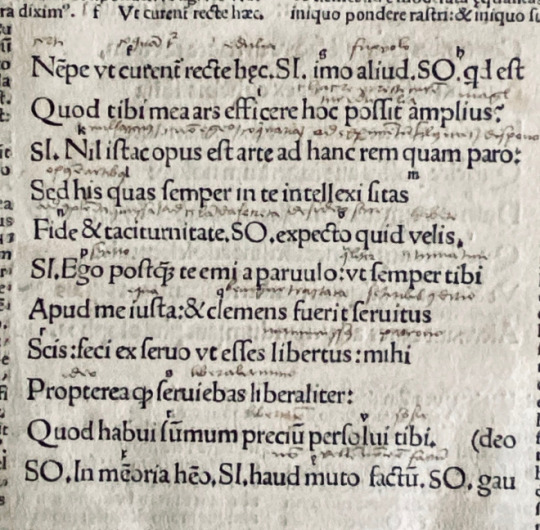
Georg Franz Burkhard Kloss (31 July 1787 Frankfurt am Main – 10 February 1854 Frankfurt). Kloss was the son of a physician and studied medicine at Heidelberg and Göttingen, where he became one of the cofounders of the Corps Hannovera Göttingen. He practiced medicine in Frankfurt. He became a book collector, and gathered a fine collection of old manuscripts,. On February 21, 1838, New York book auction house Cooley & Bangs began a three day sale during which they offered more than 313 incunabula distributed among 1,302 lots. Many incunables came from the collection of George Kloss and had appeared in the London sale of his books three years before. It is entirely possible that the 1838 sale was the first time in America that so many incunables were offered all at once in a single auction..
The bulk of the Kloss books were sold by Sotheby in 1835. Most of the books containing notes were attributed as owned and annotated by Melanchthon .
Catalogue of the library of Dr. Kloss of Franckfort a. M. including many original and unpublished manuscripts, and printed books with ms. annotations, by Philip Melancthon …Which will be sold by auction, by Mr. Sotheby and son … May 7th, and nineteen following days (Sundays excepted) .
https://babel.hathitrust.org/cgi/pt?id=hvd.32044055066971&view=1up&seq=9
Adams D 304. Proctor 9889. Ritter 2284.
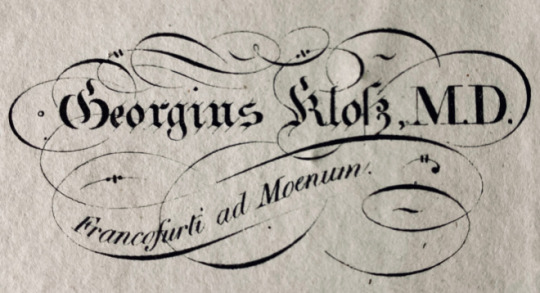
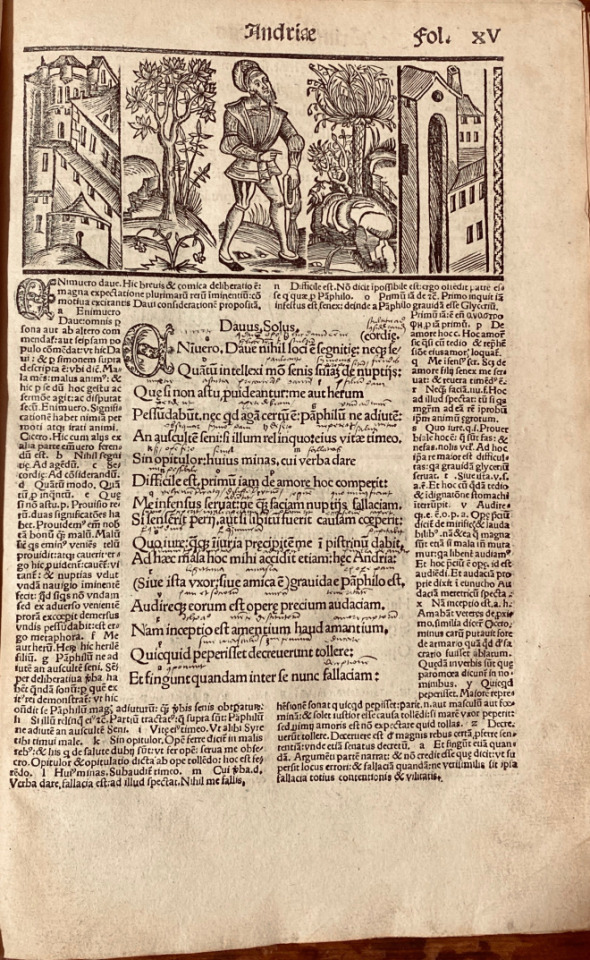
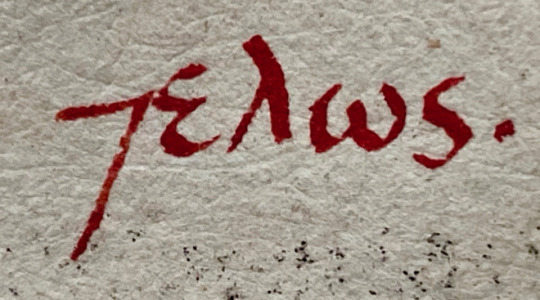
Fascicule XXI. Media Plaga 3-4/2020 Only a day or two ago I was notified that I was in contact with some people tested for and found positive for Covid-19, this came as nothing un expected, I was in contact with hundreds of people many from Europe recently.
#early printed books#fascicule XXI#George Kloss#illustrated incunabulum#Incunabula#Irish authors#irish/gaelic printing#Kircher#Not in Goff#rare book catalogue
9 notes
·
View notes